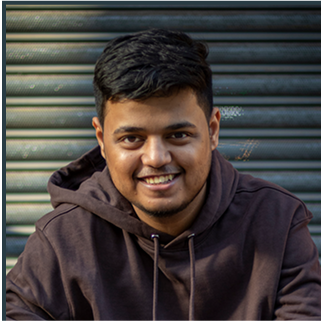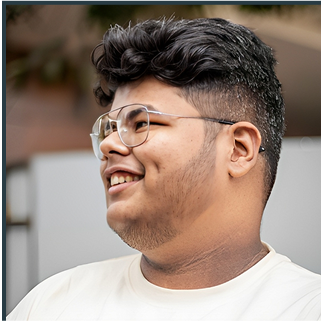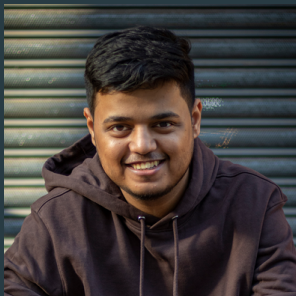


Kiran Kulkarni is the Partner & Marketing Head at ThunderClap, leading the agency's brand strategy and content initiatives. With a deep expertise in writing, marketing, and digital storytelling, she crafts narratives that elevate brands and drive measurable growth. At ThunderClap, Kiran merges creative vision with data-driven insights to deliver impactful marketing strategies.
Blogs by Kiran

The B2B Web Design and Development Blueprint: Tips to Win More Clients
Most B2B websites are Frankensteins. Marketing wants a new campaign page, Product launches a new feature, and IT adds a “security” tab in the footer. After a year, you’ve got a bloated sitemap, conflicting styles, and a homepage where the headline tries to please everyone but ends up meaning nothing.
No wonder they don’t perform. The average visitor-to-lead conversion rate for B2B SaaS is ~1.4%. That means out of 1,000 visitors, just 14 engage. Compare that to 9.5% conversion on high-performing SaaS landing pages, and the growth gap becomes clear.
At ThunderClap, we’ve applied our B2B web design and development blueprint system with 129+ B2B brands, from hypergrowth startups like Storylane and Zluri to enterprises like Amazon and Razorpay. The results are consistent: scalable websites that convert curiosity into pipeline.
This guide lays out our six-step web design blueprint principles to transform your website into a scalable, high-performing growth engine.
TL;DR
Most B2B websites are designed as one-off projects, not scalable systems (leading to poor conversions and outdated messaging). This B2B website web design and development blueprint shows you how to flip that with a system-first approach:
- Build for real buyer anxieties (ROI, security, agility) instead of generic personas.
- Structure your site like a sales conversation—educate, demonstrate, reassure, invite.
- Design as a trust signal with whitespace, social proof, and compliance proof upfront.
- Code for iteration with modular CMS blocks so Marketing can launch in hours, not weeks.
- Remove friction with smarter CTAs, live chat, trials, and instant calendar booking.
- Treat your website like a product—test, measure, and iterate continuously.
Do this, and your B2B website becomes your best SDR.
Blueprint principle 1 → Build for real buyer anxieties, not persona slides
A winning B2B web design and development blueprint starts with clarity: who you’re building for, what they need to see, and what will stop them from engaging.
Unfortunately, we see a lot of B2B sites that feel like they’re talking to made-up personas (remember ‘Marketing Mary’ or ‘IT Ian’?). Marketing personas look good in a deck, but real buyers don’t care about personas. They care about risks and outcomes and need visible reassurance.
When they land on your website,
- A CMO wants to know: “Will this move the pipeline faster?” → They scan pricing, ROI tools, and case studies.
- A Head of Marketing cares: “Can my team launch campaigns without dev bottlenecks?” → They look for clarity in product flows and proof of marketing agility.
- An IT owner asks: “Is this secure?” → They hunt for SOC 2 badges, GDPR compliance, and uptime pages.
When these signals are buried, deals stall.
Kiran Kulkarni, Partner & Head of Growth at ThunderClap, puts it simply:
“B2B buyers don’t care about personas. They care about risk. If your site doesn’t address that in the first 10 seconds, you’ve lost them.”
How to do it:
- Map the top 3 buyer roles and their anxieties.
- Design homepage blocks to answer them upfront. We call these trust signals, and here are five proven trust signals that do the job.
Top SaaS Trust Signals Buyers Look For
| Trust Signal | Why It Matters | Where to Place It |
|---|---|---|
| SOC 2 / GDPR / ISO badges | Reassures risk-averse IT buyers that compliance is met. | Security page, footer, pricing & demo pages. |
| Live Status Page | Shows reliability + transparency on uptime. | Top nav link (“Status”), support section. |
| Integration Guarantees | Reduces switching anxiety; proves ecosystem fit. | Dedicated “Integrations” page, product pages. |
| Case Studies | Provides proof of ROI & vertical fit. | Homepage, industry pages, next to CTAs. |
| Customer Logos | Social proof via association with respected brands. | Hero section, just above/below CTAs. |
| Video Testimonials | Humanizes proof; more engaging than text. | Case study library, feature pages. |
| G2 / Capterra Badges | Signals market validation + 3rd-party credibility. | Homepage hero, comparison pages, pricing. |
| Transparent Pricing | Eliminates early-stage friction, builds trust. | Pricing page, linked in top nav. |
| Security & Compliance Hub | Addresses IT/legal buyer needs directly. | Dedicated hub page, link in top nav. |
| Thought Leadership / Research | Establishes authority + expertise. | Resource hub, ungated reports. |
| Team & Leadership Transparency | Builds credibility and signals maturity. | About section, footer. |
- Build dev-ready templates so these blocks can be updated without redesign.
Don’t bury compliance, integrations, or proof in the footer. B2B buyers scan for these before they engage.
KPI to watch: % of sessions that reach trust-critical pages (security, compliance, integrations).
Also Read: Website Revamp: How to think about them?
Blueprint principle 2 → Structure like a sales conversation, not a sitemap
Legacy SaaS sites still use a brochure sitemap: Home → About → Features → Contact. But that doesn’t reflect how buyers evaluate software.
The high-performing pattern looks more like a sales call flow:
- Educate → resources, blogs, industry explainers
- Demonstrate → features, use cases, “vs.” competitor pages
- Reassure → testimonials, ROI calculators, compliance badges
- Invite → pricing, free trial, demo booking
This is why Slack’s site feels natural. They have resources for the curious, crisp product walkthroughs for evaluators, and social proof everywhere for skeptics.
Now compare that to older enterprise SaaS vendors, where you need six clicks to figure out what the product does.
Storylane’s redesign proved that sometimes the biggest trust signal is brand personality. Without changing a single word of copy, we used mood boards, a clean-but-playful visual system, and custom illustrations to create a bold personality. This led to 36% more impressions and 30% more demo requests.
Full breakdown below:
How to do it:
- Do a website audit and break your sitemap into stages: Awareness (resources) → Evaluation (features, use cases) → Decision (pricing, demo).
- Code navigation menus modularly, so adding/removing items doesn’t break layouts.
Keep BoFU pages (pricing, comparison, security) one click away (not buried).
Don’t prioritize vanity pages (About, Careers) in the navigation bar. Push them to the footer. Unless your buyers are journalists, nobody starts there.
KPI to watch: Share of traffic hitting BoFU pages (pricing, comparison, security).
Blueprint principle 3 → Design as a trust signal, not decoration
SaaS buyers are busy, skeptical, and risk-averse. A high-converting design isn’t about looking modern. It should guide buyer perception and trust (aka de-risk decisions for buyers). With Zenda, we overhauled their design system to prioritize clarity and proof. The team loved the design, which also got nominated for Awaaards.
Let’s break down how B2B website design best practices apply design psychology to win trust and clarity.
Whitespace signals confidence. That’s why Asana’s minimalist product pages feel calm, scannable, and focused. Compare that to cluttered competitors that overwhelm with jargon.

- Social proofs (logos and testimonials) are risk reducers. Lokalise doesn’t just say “trusted by companies worldwide”. They drop JP Morgan, Prime Video, and Schneider logos right under the headline and CTA buttons.
That’s shorthand for “others you respect already trust us.”
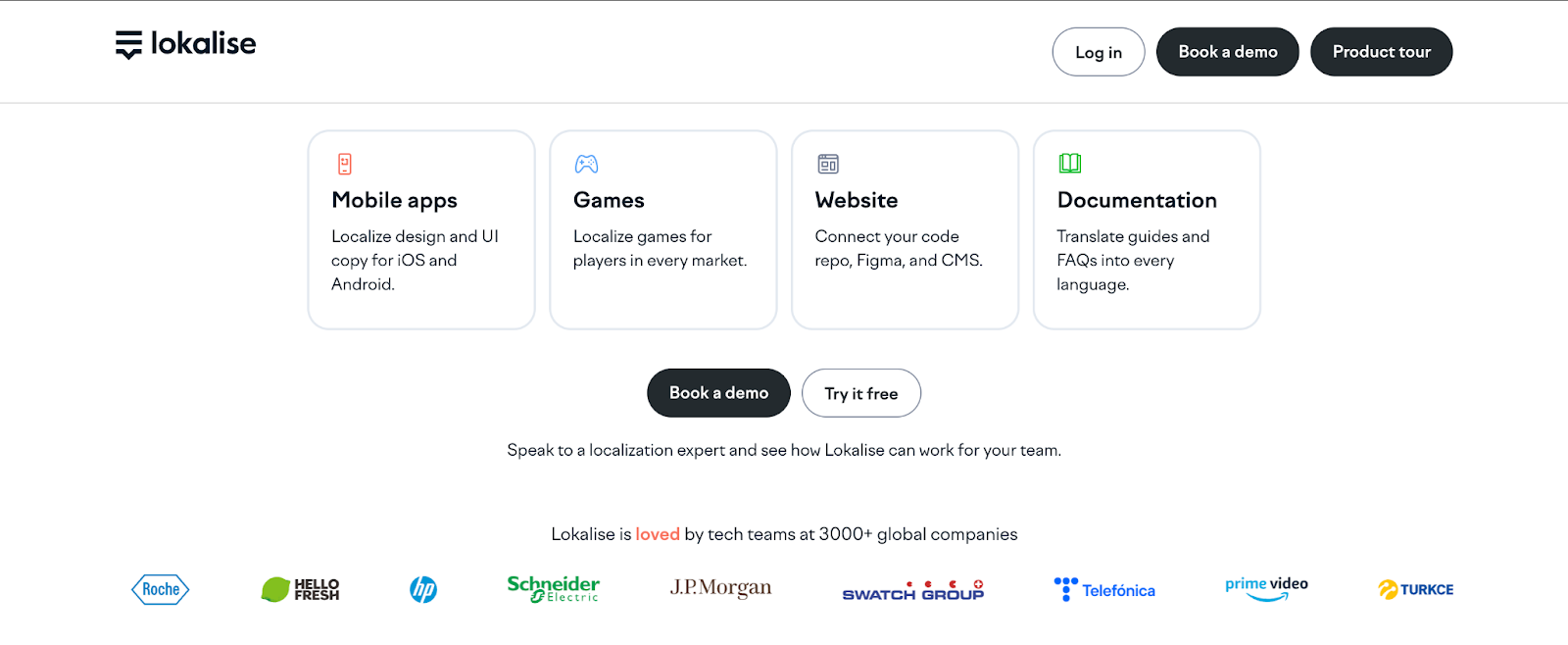
Don’t overload the hero with 3–4 competing CTAs. Pick one primary, one secondary.
- Color psychology guides perception. Datadog’s purple stands out in a crowded cloud space; Shopify’s green reinforces growth and commerce.
The job of website design elements here isn’t to delight. It’s to reduce the buyer’s anxiety and make the next step feel obvious. Here’s a simple B2B design signal framework you can follow to check if your website visual strategy communicates trust:
{{ctaBlock}}
Design Signal Framework for B2B Websites
| Signal | Buyer Question | How to Implement |
|---|---|---|
| Trust | Can I rely on you? | Client logos, compliance badges, testimonials next to CTAs (not buried) |
| Clarity | Do I get this fast? | Whitespace, clear hierarchy, consistent spacing + typography system |
| Differentiation | How are you unique? | Distinctive color palette/branding |
| Engagement | Do I see value here? | Interactive demo, tour video |
And yes, personalization matters! HubSpot found personalized CTAs convert 202% better than generic ones by using smart, dynamic messaging.
KPI to watch: Hero CTA click-through rates.
Also Read: A Complete Guide to B2B Web Design Best Practices
Blueprint principle 4 → Code your website for iteration, not just launch
Most SaaS teams build for “launch day.” Then marketing asks for a new industry landing page, and suddenly it’s a dev ticket that takes 3 weeks. That’s the cost of not thinking modularly.
At ThunderClap, we build modular CMS libraries: feature blocks, testimonial carousels, pricing tables (coded once, reused everywhere). Marketing launches in hours, not weeks. Dev focuses on performance and integrations, not content edits.
One of the common questions we get in B2B web design is choosing the right content management system for your business:
SaaS CMS Options Compared (B2B Focus)
| CMS | Pros | Cons | Best Fit |
|---|---|---|---|
| WordPress + Builder | Flexible, huge plugin ecosystem | Plugin bloat, security risks | Mid-sized B2B |
| Webflow | No-code, fast iterations | Limited backend depth | Marketing-led SaaS |
| Headless CMS | API-first, enterprise-scale | High dev overhead | Large SaaS with a complex stack |
Cloudflare shows that every 100-millisecond delay in website loading can cause a 1.11% drop in conversions. Web performance isn’t vanity; it’s revenue. If your site loads slower than your competitor’s, you’re signaling sloppiness before the first headline even registers.
How to do it:
- Code all blocks as modular components (hero, testimonial, pricing grid).
- Use Webflow for CMS + visual editing. Marketing can launch pages in hours, not weeks.
- Globalize design tokens (colors, typography, spacing) → updates sync sitewide.
KPI to watch: Time to launch a new campaign page. Elite SaaS: <1 day.
Blueprint principle 5 → Remove friction relentlessly (and then some more)
B2B SaaS conversion rates are significantly lower compared to B2C, as buying SaaS is riskier, more complex, and often involves multiple committees. That means every ounce of friction matters.
But having longer cycles doesn’t excuse poor conversion architecture. Conversions happen by climbing a ladder of offers (each reducing risk until the buyer commits). Your best bet is to offer multiple CTA paths: trial, demo, calculator.
Here are a few examples of what a bare bones offer ladder can look like.
Offer Ladder Framework
| Step | Offer | Friction | When to Use |
|---|---|---|---|
| 1 | Demo video | Low | Homepage |
| 2 | ROI tool/checklist | Low–Med | Resources, use cases |
| 3 | Instant calendar booking | Med | Pricing/comparison pages |
| 4 | Full demo/consult | High | High-intent buyers |
Once you have done an audit of your offer, here’s what else you should optimize for:
- Look at your forms: If visitors won’t even start the form, it’s not the fields (it’s the offer). We have seen that an ROI calculator with five fields often outperforms a vague “Request a Demo” with 3. Embed calendar booking right after the form submission to capture hot intent.
- Improve your free trials: Free trials without a card convert at ~18%, while those with a card convert at ~48%. Now, there are many variables you need to take into consideration based on whether you want volume or qualification.
Add live chat to your website: Intercom and Drift show why live chat works. Buyers evaluating SaaS have questions now, not in 48 hours when SDRs reply.
Don’t default to “Contact Us.” It’s vague, high-friction, and kills conversion.
KPI to watch: Meetings per 1,000 sessions.
{{specficBlog}}
Blueprint principle 6 → Treat your website like a product
The biggest lie in B2B web projects? “We’ll relaunch and then move on.”
But most SaaS websites don’t fail at launch. They fail six months later when content is outdated, modules break, or teams can’t scale new pages without dev help. If your site isn’t designed for iteration, it’s obsolete in 12 months.
The blueprint solution is simple. Treat your site like your product: modular, iterative, evolving.
As Ayush Barnwal, Founder at ThunderClap, reminds us:
“A website isn’t a project, it’s infrastructure. You wouldn’t turn off your CRM after launch, so why treat your website differently?”
At ThunderClap, here are six monthly website health checks we recommend all our clients:
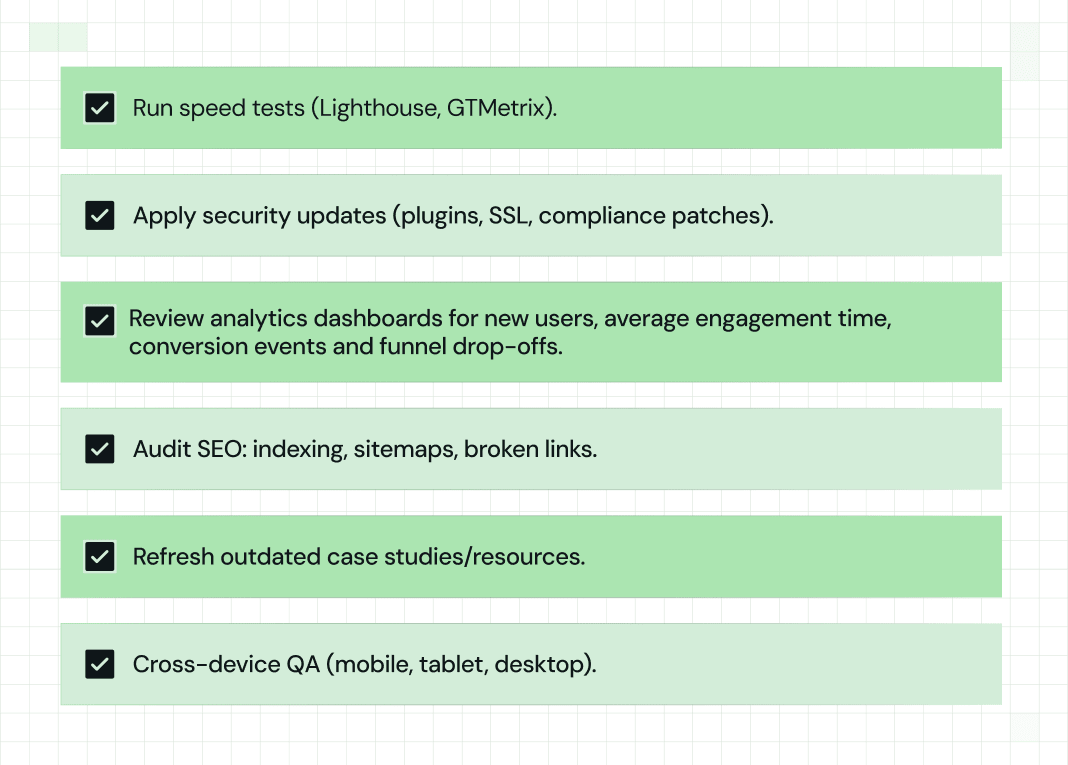
KPI to watch: Meetings per 1,000 sessions, tracked monthly. If it dips, trigger a CRO sprint.
Make your website your best SDR with ThunderClap
Most mid-market and enterprise B2B product companies face the same website challenge: their website no longer reflects who they are becoming. They’re pivoting their positioning, preparing for expansion, launching new products, or under pressure to perform at an international standard.
But their website lags behind.
At ThunderClap, we help you transform your websites into conversion-driven growth engines—accurate representations of your product, scale, and vision that finally make them stand out in your category.
Here’s what changes when you work with us:
- Instantly communicate value and positioning without confusion
- Project a premium, credible brand perception that matches your ambitions
- Scale and iterate fast with modular systems that keep your site current
- Launch a site that doesn’t just match category rivals (it beats them on clarity, UX, and design)
- Hit concrete KPIs: double demo signups, increase MQLs, lower bounce, and win awards
And we’ve seen this transformation play out across 129+ projects, including clients like Storylane, ClearlyRated, RazorPay, and Amazon. If you’re ready to make your website your best SDR, let’s talk execution.
Book a free consultation today!
{{specficService}}
FAQs
Do B2B websites need ongoing updates and maintenance?
Yes. A B2B website is a living system, not a one-off project. Without regular updates, content goes stale, compliance proof becomes outdated, and performance suffers. The best teams run weekly content or CTA tests, monthly KPI and speed audits, and quarterly UX refreshes to keep the site aligned with buyer needs.
What key features should a good B2B website have?
A strong B2B website blends trust, clarity, and conversion. That means visible compliance badges and case studies, a clear CTA ladder that guides visitors from trial to demo, and an integration hub that shows ecosystem fit. Under the hood, it needs fast load speeds and a modular CMS like Webflow so Marketing can iterate without waiting on Dev. These align with the core principles of B2B web design and development best practices.
How do I optimize my B2B website for SEO & leads?
Start with BoFU pages like pricing, competitor comparisons, integrations, and security hubs to capture in-market buyers. Optimize content for both search engines and LLMs with clear summaries, tables, and FAQs. Finally, place proof points next to CTAs and enforce a speed-to-lead SLA of under 5 minutes to prevent drop-offs. Think of this as part of your B2B web design and development blueprint for long-term growth.

Top Webflow Agencies in London for SaaS & Tech Brands
The London tech scene is booming, and with it comes the demand for exceptional digital experiences. But here’s the harsh reality: while London houses some of the world’s most innovative SaaS and fintech companies, many are held back by websites that don’t reflect their brilliance. Whether you’re a Series A startup scaling fast or an enterprise fintech looking to dominate your market, your website is either your weapon or your Achilles’ heel.
Now, let’s consider some of the specialized London Webflow agencies. These aren’t your average design shops throwing together templated solutions. The best Webflow design agencies in London understand the different challenges faced by tech brands: user journeys, B2B decision-making processes, compliance requirements, and the constant pressure to convert visitors while building trust at scale.
We’ve evaluated London’s top Webflow specialists to bring you the definitive list of agencies that get SaaS and tech. Leading our rankings is ThunderClap, which has emerged as the conversion-focused agency serving everyone from seed-stage AI startups to enterprises.
With their strategy-first approach and lightning-fast execution, they’re setting the standard for what’s possible for SaaS website design.
Ready to discover which London Webflow agency deserves your next project? Let’s dive in.
Why London’s SaaS & Tech Scene Demands Specialized Webflow Expertise
London isn’t just a financial hub; it’s Europe’s undisputed SaaS and fintech capital. From the regulatory problems of the City to the scaling demands of King’s Cross startups, tech companies here face challenges that generic web agencies simply can’t solve.
Your website is not a digital brochure. For SaaS companies, it is the first touchpoint in a B2B sales journey. For fintech, it’s where trust is built or destroyed in milliseconds. For AI companies, it’s where you translate cutting-edge technology into business value. This requires more than a pretty design. It demands strategic thinking, conversion optimization, and an intimate understanding of how tech buyers make decisions.
The best Webflow agencies in London don’t just build websites; they architect conversion engines. They understand that your homepage needs to speak to both technical decision-makers and C-suite executives, that your pricing page must handle enterprise while remaining accessible to startups, and that every element must be optimized for the metrics that matter to tech businesses.
How We Identified London’s Top Webflow Agencies for Tech Brands
We didn’t just Google "Webflow agency London" and call it a day. Our selection process was methodical, focusing on agencies that deliver measurable results for SaaS, fintech, and tech companies:
| Criteria | Why It Matters |
|---|---|
| SaaS/Tech Portfolio | Proven experience with complex B2B sales cycles and technical products. |
| Conversion Focus | Evidence of measurable results, not just aesthetic improvements. |
| London Presence | Local market understanding and time zone alignment for faster iterations. |
| Client Retention | Long-term partnerships that reflect consistent value delivery. |
| Technical Expertise | Advanced Webflow integrations and scalable architectures for growth. |
The Top Webflow Agencies in London for SaaS & Tech Brands
1. ThunderClap (The Strategy-First Conversion Agency)
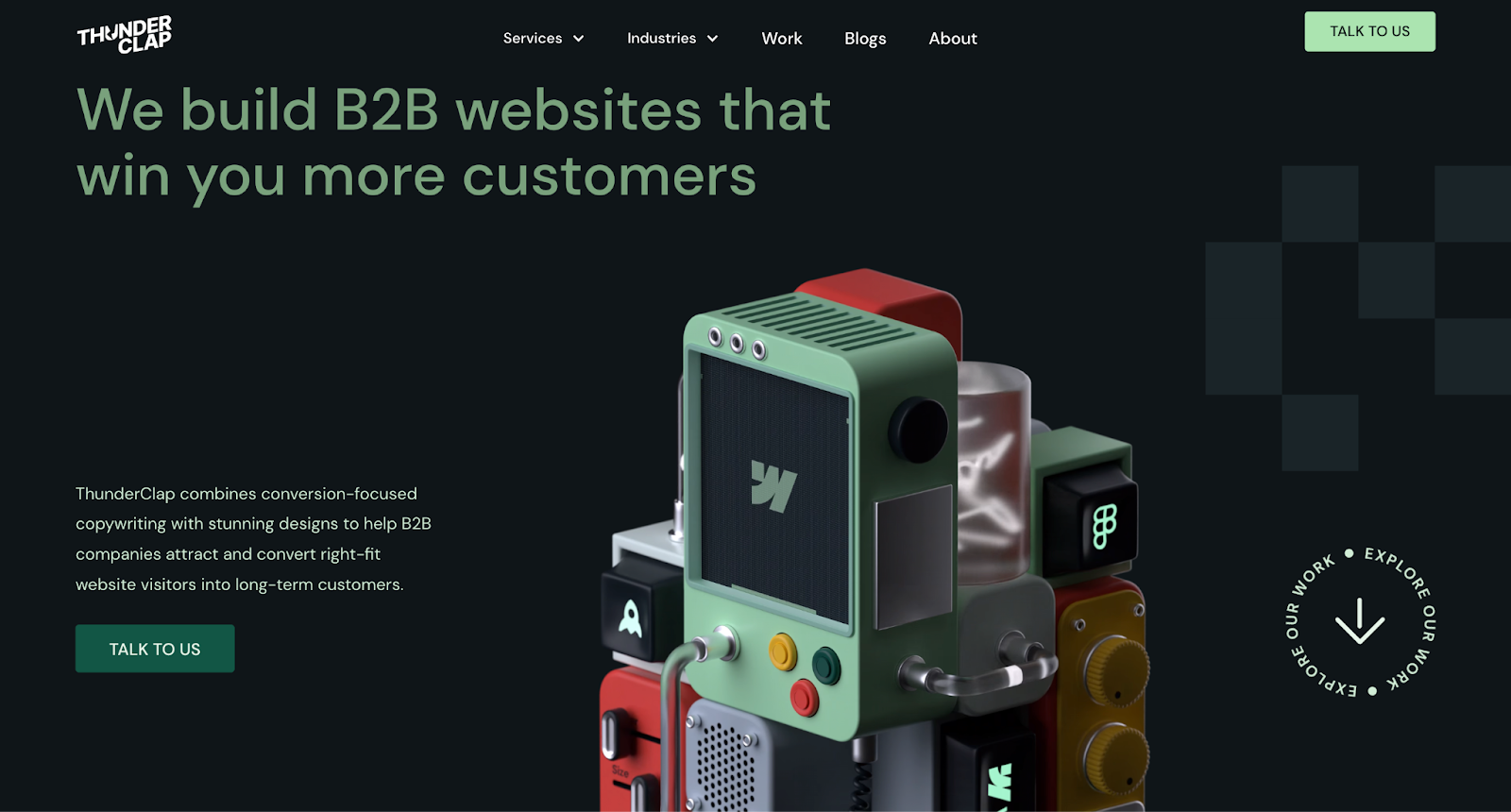
When SaaS and tech companies need websites that don’t just look impressive but bring measurable growth, they turn to ThunderClap. This isn’t your typical design agency; we’re strategic partners who understand that in tech, every pixel, every word, and every user journey element must earn its place by focusing on conversions.
What sets ThunderClap apart in London’s crowded agency scene is our obsession with results. We focus on winning customers for the clients, while also winning design awards. Our average client sees a 50% increase in lead generation, and their websites outperform industry benchmarks for engagement rates.
Why ThunderClap Dominates the London Tech Scene
ThunderClap’s approach is refreshingly direct: we start with business objectives, not aesthetic preferences. Our strategy-first methodology means every design decision is backed by data, user research, and conversion optimization principles. For SaaS companies, this means websites that guide prospects from initial awareness to qualified sales conversations. We have an in-house product marketing team that provides expertise in B2B Messaging strategy, design, dev, and everything in between.
Our technical expertise runs deep. As a Webflow Enterprise Partner, we leverage advanced CMS structures, custom integrations, and performance optimization techniques that many agencies don’t match. But it’s our strategic thinking that truly sets us apart. We understand how SaaS buyers research, evaluate, and purchase, and we tend to design experiences that align with these natural behaviors. Learn more about this process.
Client Success Stories
ThunderClap’s portfolio reads like a who’s who of successful tech companies.
For Shopline, created a website that scales across multiple markets while maintaining conversion optimization.
Storylane’s new site, built by ThunderClap, saw immediate improvements in demo requests and sales-qualified leads.
“The ThunderClap team is responsive, meets deadlines, and goes beyond expectations — it’s a solid partner for any B2B company looking to scale their brand.”
— Anand Vatsya
Product Marketing, Outbound, Storylane
{{ctaBlock}}
2. ViDesigns
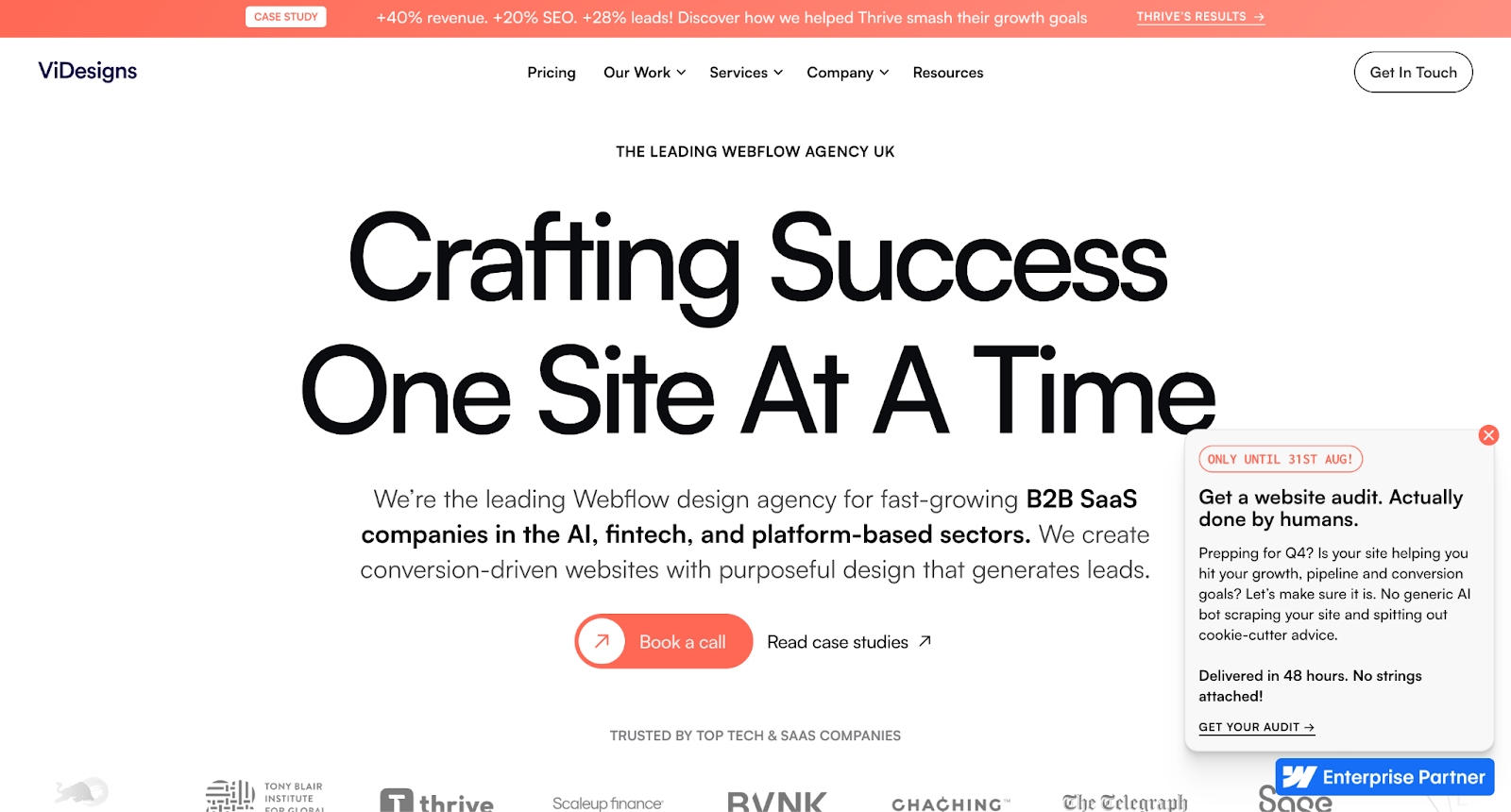
ViDesigns has built a reputation as London’s go-to Webflow design agency for B2B SaaS companies that need to move fast without compromising quality. They’ve launched Webflow projects for brands ranging from Red Bull to AI startups, but their sweet spot is clearly in the B2B tech space.
What makes ViDesigns particularly effective for London’s tech scene is their understanding of the B2B buyer journey. They create beautiful websites along with conversion paths that account for the multi-stakeholder decisions typical in SaaS and tech sales cycles.
Their project capacity is intentionally limited. They only take on 6 Webflow projects each quarter so that every client receives their full attention. This boutique approach has earned them verified client reviews.
3. RCCO

For London tech companies that need enterprise-level work with the agility of a specialized London Webflow agency, RCCO delivers at scale. Their projects typically range from Series B+ companies to enterprises that need websites worthy of their market position.
RCCO’s strength lies in their approach. They’re not just building websites; they’re creating digital ecosystems that integrate with existing tech stacks. Their recent work includes Simplestream (video streaming platform), Optable (data collaboration), and WILD (video brand platform).
What sets RCCO apart is their focus on self-management. They don’t just hand over a finished website; they ensure your team can confidently manage, update, and scale the platform without constant agency
4. Team 4

Team 4 positioned themselves as London’s specialist Webflow agency for B2B SaaS companies that understand growth comes from organic visibility, not just paid acquisition. Their tagline says it all: ‘High-POWER Webflow Websites for B2B SaaS SEO’.
Their approach combines Webflow development with SEO, creating what they call inbound engines for growth. For SaaS companies tired of relying solely on expensive paid channels, Team 4 offers an alternative: websites that rank, convert, and scale organically.
Their process begins with SEO discovery, ensuring that site architecture, content strategy, and user experience all align with search intent and buyer behavior. This isn’t just about technical SEO, it is about understanding how B2B SaaS buyers research solutions and creating content experiences that capture demand at every stage of the journey.
5. Lighthouse Digital
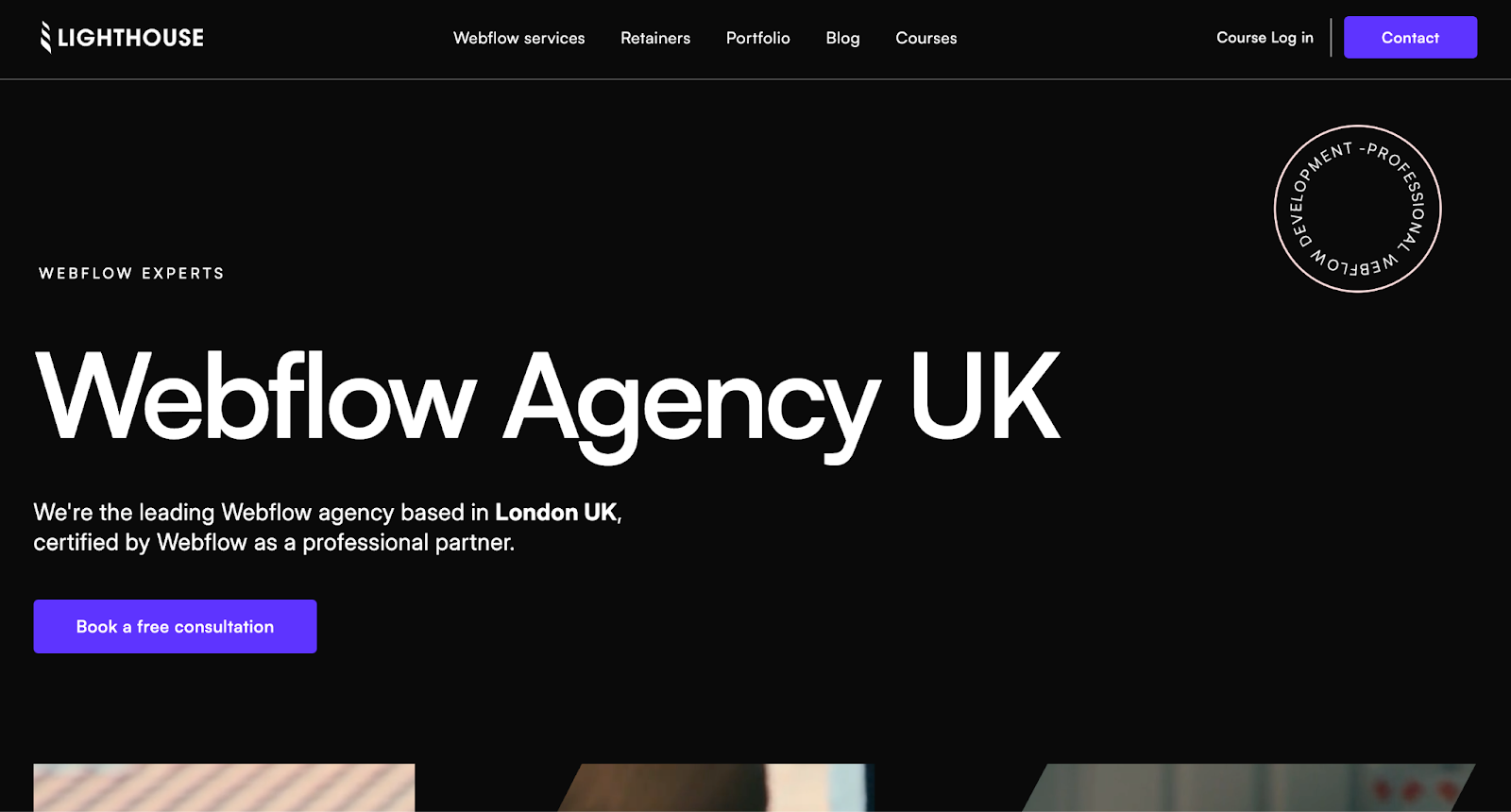
Lighthouse Digital established itself as one of London’s most experienced Webflow agencies, with a portfolio that includes major successes across the tech spectrum. They’ve developed Webflow websites for HelloSelf (£17 million in funding), Mission Zero (£21.8 million Series A), and major brands like Britvic and IGN.
Their strength lies in execution across diverse tech verticals. Whether you’re in fintech, healthtech, or enterprise software, Lighthouse Digital brings the experience of having solved similar challenges before. Their project portfolio shows success in helping tech companies achieve funding milestones and market expansion goals.
What makes Lighthouse Digital particularly considerable for London tech companies is their deep platform expertise along with business acumen. They understand that successful tech websites need to work for multiple audiences.
{{specficBlog}}
6. Paddle Creative
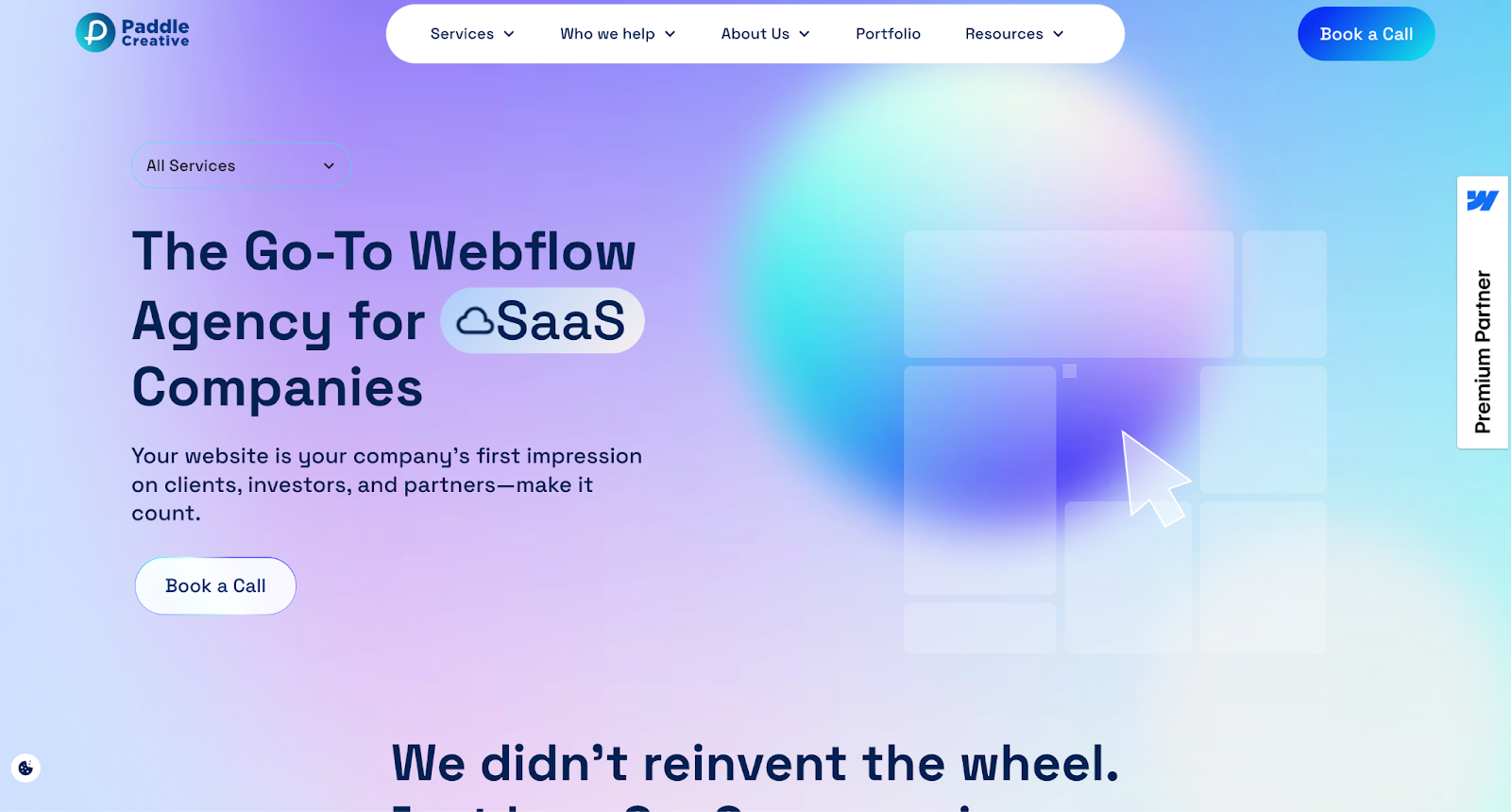
Paddle Creative specifically works around serving SaaS and fintech companies, making them a natural fit for London’s tech sectors. They have helped clients secure over £150 million in combined funding, including NatureMetrics (£25m Series B), Swap (£40m Series B), and Gaia Fertility (£23m).
Their specialization shows in their approach. Rather than generic web design principles, Paddle Creative applies frameworks specifically developed for SaaS and fintech user acquisition and conversion. They understand the regulations that fintech companies face, the compliance requirements, and the trust-building elements that are non-negotiable in financial services.
For SaaS companies, they bring deep understanding of freemium models, trial optimization, and the complex pricing presentations that B2B software companies require.
7. MakeBuild
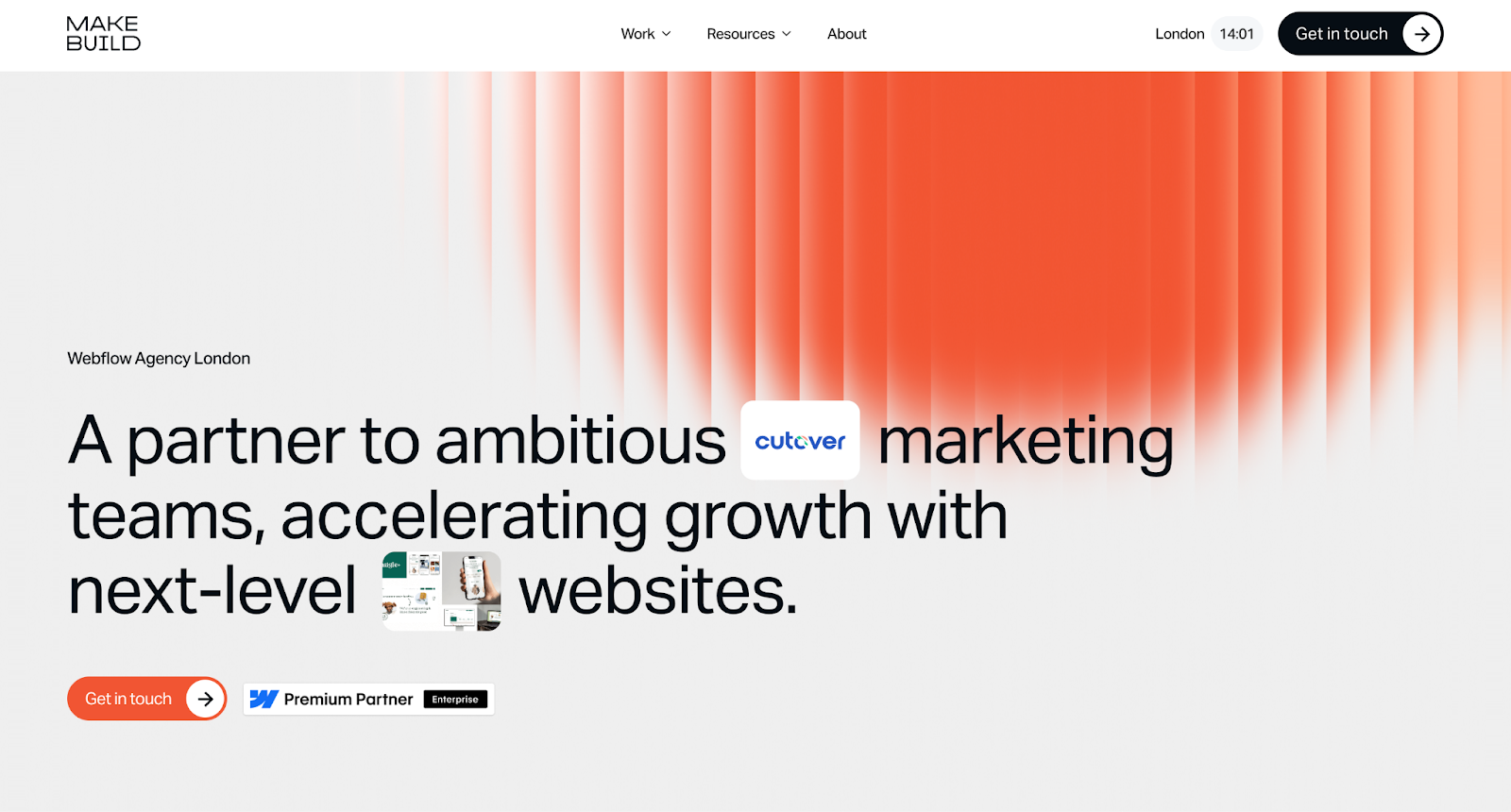
MakeBuild brings a refreshing design through making philosophy. As a Webflow Enterprise Partner based in London, they have created a reputation for tackling integration challenges while maintaining creativity that tech brands need to stand out.
Their approach sits particularly well with tech companies that value innovation over convention. Rather than endless strategy sessions and presentations, MakeBuild does rapid prototyping and iterative development. For fast-moving tech companies that need to test, learn, and pivot quickly, this methodology offers significant advantages.
Their clients highlight their ability to handle requirements while maintaining project velocity. This combination of tech and efficiency makes them valuable for London tech companies operating in competitive markets.
8. The London Webflow Agency
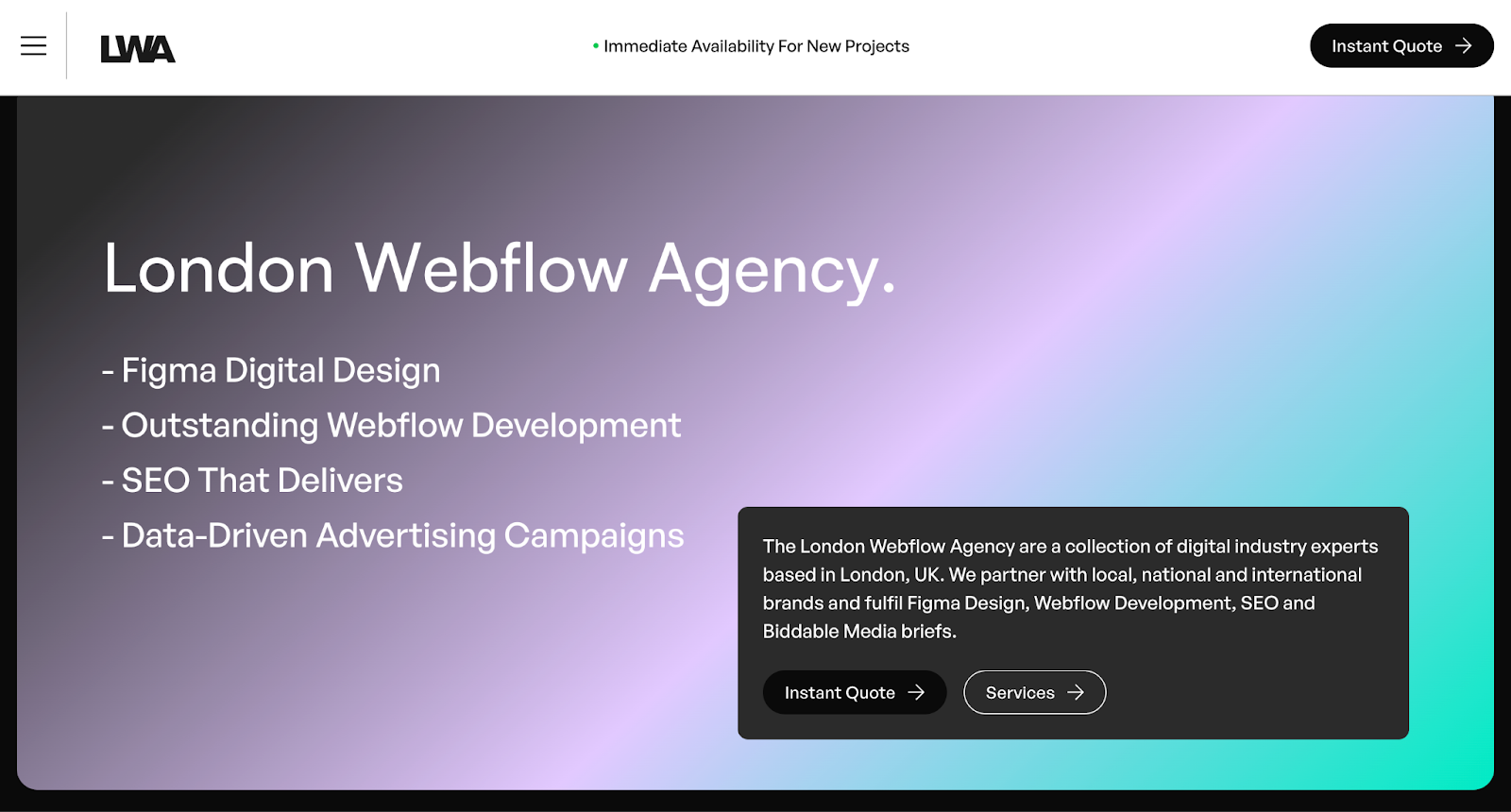
With over 8 years of Webflow experience and deep London market knowledge, The London Webflow Agency has the local expertise that many tech companies value. Their founders have been working on digital projects since the late 1990s, bringing mature perspective to modern Webflow capabilities.
Their strength lies in service delivery: Webflow development with digital marketing services including SEO, PPC, and paid social. For tech companies that prefer working with a single agency across multiple disciplines, this integrated approach is definitely worth a shot.
Their client roster includes institutions like The City of London Corporation and Tate, showcasing organizational requirements and high-profile brands.
Agency Shortlist Overview
| Agency | Project Size (Starts From) | Locations | Primary Industry | Top Clients | Notable Testimonial or Outcome |
|---|---|---|---|---|---|
| ThunderClap | £5,000 – £40,000 | London, Remote | SaaS, Fintech, B2B | Razorpay, Shopline, Elevation Capital, Amazon | “Responsive, meets deadlines, goes beyond expectations.” |
| ViDesigns | £6,000 – £20,000 | London | SaaS, Tech, Product | RedBull, Tony Blair Institute | “Collaborative, creative, goes above and beyond.” |
| RCCO | £10,000+ | London, Manchester, Remote | Tech, B2B, Enterprise | Loyaltek Group, Simplestream, Optable | “Made our dreams come true…exactly what we needed.” |
| Team 4 | £5,000+ | London | B2B SaaS, Tech | 100+ SaaS/Tech brands | “Specialists for B2B SaaS SEO and inbound growth.” |
| Lighthouse Digital | £5,000+ | Shoreditch, London | B2B, SaaS, Fintech | HelloSelf, Mission Zero, Britvic | “Sleek sites that drive results and capture attention.” |
| Paddle Creative | £5,000+ | London | SaaS, Fintech, AI | NatureMetrics, Swap, Gaia Fertility | “Becomes part of your team, delivers every time.” |
| MakeBuild | £8,000+ | London | Tech, SaaS, Corporate | Typeform, London & County Mortgages | “Brain surgery feel like a flu shot, true experts.” |
| London Webflow Agency | £5,000+ | London | Broad B2B, Public | City of London Corporation, Tate | “Local expertise, wide service scope, reliable.” |
What Makes These London Webflow Agencies Perfect for Tech Brands?
The agencies on this list share several components that make them effective for SaaS, fintech, and tech companies:
Deep Technical Understanding: They understand products and turn technical features into clear benefits. These agencies communicate effectively with both technical teams and business leaders.
Conversion Optimization Expertise: They build every page element for specific results. From homepages that filter qualified leads to pricing pages that handle enterprise deals, these agencies know how B2B tech sales actually work.
Scalable Architecture: They create Webflow sites that grow with your company. When you launch new products, enter new markets, or connect new tools, these websites handle the expansion.
Speed and Agility: Tech companies move fast, and these agencies keep up. They know your launch dates tie to funding rounds, product releases, and market windows that can’t wait for endless revisions.
Choosing the Right London Webflow Agency for Your Tech Brand
The best London Webflow agency for your company depends on your specific stage, goals, and requirements:
For Early-Stage SaaS Companies: Consider agencies that understand the challenges of establishing market presence while optimizing for conversion from day one.
For Enterprise Tech Brands: Prioritise sophisticated project management needed for high-stakes implementations.
For Growth-Stage Companies: An SEO-first approach or funding track record might align perfectly with your scaling objectives.
For Innovation-Focused Brands: Experimental approach could be ideal for companies that want to push creative and technical boundaries.
The key is finding an agency that doesn’t just understand Webflow, but understands your business model, your customers, and your competition. The best partnerships happen when agencies become extensions of your team, not just external service providers.
{{specficService}}
What’s Next for Your Tech Brand?
London’s tech scene moves fast. If your website doesn’t perform, you fall behind. Top SaaS companies aren’t just looking for sites that look good; they want sites that convert, engage users, and bring measurable growth.
The tech brands that win partner with agencies that get it. Whether you’re launching a new platform or scaling an existing product, the right Webflow design agency can turn your website into a growth engine, not just a digital business card.
The agencies on this list are among London’s best. Each has its own strengths and methods. But here’s what we’ve learned working with ambitious tech teams: the best agency isn’t always the biggest or most famous. It’s the one that understands your market, talks your customer’s language, and delivers real results.
ThunderClap stands out because we bring together strategy, technical skill, and a conversion-first approach.
We build sites that help SaaS and tech brands dominate their markets.
Your website either drives growth or it doesn’t. Make it count.
Book a free demo with ThunderClap and see how we turn websites into your strongest growth asset.

From Traffic to Pipeline: B2B Website Growth Strategy for Scaling Teams
Your traffic charts are trending up. But your pipeline charts? Not so much.
This is the story we hear from scaling B2B teams all the time. They’ve invested in SEO, refreshed their design, pushed out content, and maybe even redesigned the entire website in the last 18 months.
On paper, everything looks good. In reality, SQLs and opportunities aren’t keeping pace.
The reason is simple: most B2B websites are built to collect traffic, not create a pipeline.
They fail to guide ICP buyers from session → meeting → SQL → revenue, and this disconnect is costing them deals every quarter.
In this playbook, we’ll share the B2B website growth strategy framework we built for scaling SaaS teams at ThunderClap. We’ll back it with competitor benchmarks, pipeline math, and research that proves what works (and what doesn’t).
By the end, you’ll have a roadmap to transform your website from a marketing channel into a pipeline engine that scales with your team.
TL;DR
Most B2B websites chase traffic, not pipeline, resulting in missed sales opportunities and lost revenue. This B2B website growth strategy playbook shows you how to flip that with a pipeline-first growth framework:
- Focus traffic on BoFU pages (pricing, comparisons, security).
- Build conversion architecture (clear offer ladder + proof + speed-to-meeting).
- Enable instant bookings and smart routing to boost qualified meetings.
- Align sales handoff with buyer context for higher SQL rates.
- Track pipeline KPIs (meetings per 1k sessions, BoFU traffic share, speed-to-lead).
- Layer on personalization, CRO, and LLM-friendly content for scale.
Do this, and your B2B website becomes a pipeline engine that drives measurable ROI
What is a B2B website growth strategy?
A B2B website growth strategy is a structured plan for attracting ICP traffic and turning it into revenue. That means your site isn’t just optimized for sessions, pageviews, or bounce rate; it’s optimized to move your ICP through your funnel:
Sessions → CTA clicks → Meetings → SQLs → Revenue
It’s a pipeline-first approach that defines:
- Who you’re for (ICP clarity),
- What you want them to do (offer ladder → meeting),
- How you’ll prove it’s worth their time (proof, performance, and speed‑to‑meeting),
- How you’ll measure it (pipeline KPIs tied to revenue).
Notice what it’s not: It’s not an SEO checklist, obsessing over page speed scores, or a debate over whether the hero should have a video background. Those are executional decisions, important, but they should flow from strategy (not drive it).
Why do B2B websites struggle to generate leads?
The stakes for your website have never been higher.
- 82% of B2B buyers are willing to purchase from vendors online without ever talking to sales.
- But 88% of users say they’ll abandon a site after a poor experience.
That’s both the opportunity and the risk.
Your website is no longer just a digital brochure; it’s the first sales conversation.
Done right, it can be a pipeline engine. Done wrong, it leaks deals.
As Kiran Kulkarni, Partner & Head of Growth at ThunderClap, puts it:
“We’ve audited 70+ SaaS websites so far, and one of the most common issues we see is that page layouts aren’t optimized for conversions. Some teams only place one CTA block on a page, others use 10 different names for the same CTA, or bury users under long forms and content-heavy pages that cause drop-offs instead of helping buyers scan seamlessly.”
Here are 6 reasons why most B2B websites struggle to generate leads:
- ICP fuzziness. Messaging tries to talk to everyone and resonates with no one. They attract traffic, but not the right traffic.
- Top‑funnel traffic bias. Teams overproduce top-of-funnel (TOFU) blogs, but underinvest in bottom-of-funnel (BoFU) pages like pricing, comparisons, and security.
- Generic CTAs. Contact Us is the default call-to-action. It’s vague, high-friction, and fails to meet buyers where they are in the journey.
- Proof starvation. Case studies, ROI data, security, and integration evidence are missing or buried in footers or resource centers (nowhere near conversion points).
- Slow handoff to sales. When inbound leads fill out a form, response often takes hours (or days). That delay kills the pipeline.
- Design‑over‑data. Visual vanity wins meetings internally, not in the market. A premium design still must be measurably effective.
From traffic to pipeline: The 4-stage B2B website growth framework
Here’s the 4-stage framework we use at ThunderClap with mid-market and enterprise B2B teams to move from traffic‑centric to pipeline‑centric with a result-oriented system:
| Stage | What it means | Owners | Primary levers | Success signal |
|---|---|---|---|---|
| Sessions → Intent | Right visitors, not just more | SEO, Demand Gen | BoFU pages, branded search, partner traffic, persona-focused copy | % of sessions landing on BoFU |
| Intent → Engagement | Prospect takes the next step | Product/Content | Clear value props, scannable pages, performance | CTA click-through rate |
| Engagement → Meeting | Prospect books or requests time | Growth, RevOps | Offer ladder, calendar embed, smart routing | Meetings per 1k sessions |
| Meeting → SQL/SQO | Sales accepts and advances | Sales, RevOps | Qualification, enrichment, speed-to-lead | SQL rate, time-to-first-touch |
| SQL → Revenue | Deals created and won | Sales | Proof alignment, case studies, ROI tools | Opportunity rate, win rate |
Did you notice how each stage has owners, levers, and an observable, time‑bound KPI?
That’s how we recommend it!
Now let’s break down the primary levers and execution tactics for each of these stages.
Stage 1 → Traffic that converts (BoFU focus)
Scaling teams don’t win by publishing more TOFU explainers. They win by capturing in‑market demand with bottom‑of‑funnel (BoFU) assets that shorten time‑to‑meeting. Time and again, we see them do this by targeting in-market buyers via intent-led ads and retargeting (so paid campaigns don’t just fuel top-funnel vanity visits).
High-performers do this with:
- Comparison pages: “You vs Competitor” with head‑to‑head matrices.
- Alternatives pages: “Best Competitor alternatives” to intercept switching intent.
- Pricing: Transparent tables, value justifications, and procurement FAQs.
- Integration hubs: Verified workflows with the systems your ICP already runs.
- Security & compliance: SOC 2/ISO details, data residency, and legal review shortcuts.
Implementation & ROI tools: Calculators, timelines, and success checklists.
What should you aim for?
High-growth teams aim for 30–40% of traffic landing on BoFU pages, not just blogs.
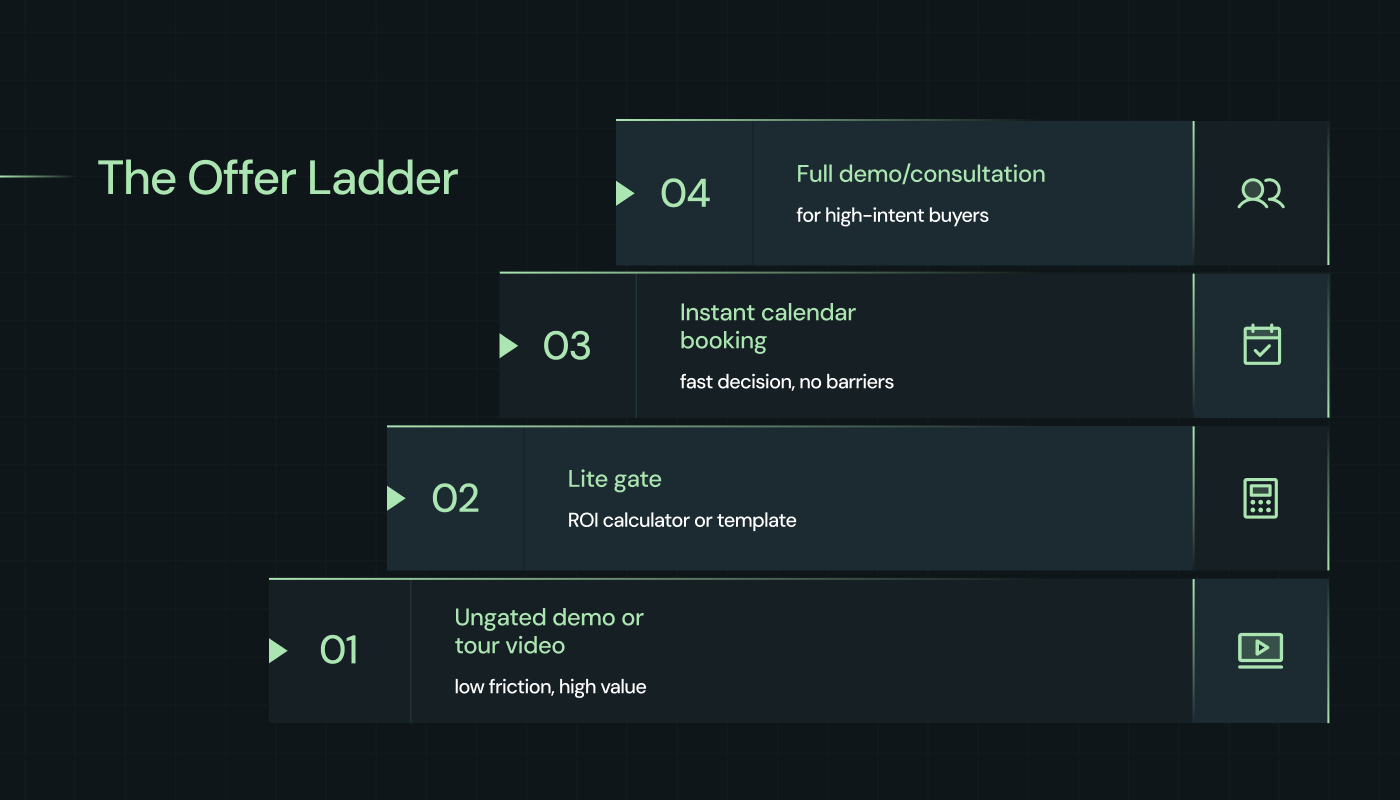
Stage 2 → Conversion architecture (offer ladder, proof, speed-to-meeting)
Once someone lands, your site needs to answer in <5 seconds: Is this for me? Can I trust them? What’s my next step?
That’s conversion architecture.
You achieve this by creating an offer ladder, a clear, progressive path that moves your visitor closer to a meeting or demo.
Here’s what an offer ladder looks like:
The goal of your B2B website strategy is to give prospects more value and less friction in each step, helping them get comfortable taking the next step on the path to conversion.
Here are a few more examples of what an offer ladder can look like.
| Offer | Effort for the visitor | Perceived value | When to use | Why it works |
|---|---|---|---|---|
| Ungated tour / 3-min demo video | Low | Medium | Early interest; home & product pages | De-risk the click. Show outcomes first |
| Template / Checklist / ROI calc | Low–Medium | Medium–High | Category researchers; mid-funnel | Show utility. Capture light data if needed |
| Industry mini-case | Medium | High | Vertical pages; ABM landers | Pair with relevant proof & logos |
| Live calendar (book a meeting) | Medium | High | BoFU pages; pricing, comparison | Eliminate back-and-forth. Route intelligently |
| Full demo / assessment | High | Very High | Ready buyers; high intent | Promise a clear give/get and timeline |
A few things to keep in mind while creating your offer ladder:
- It’s not always “fewer form fields = better.” Research shows relevance and perceived risk matter more. For high-value meetings, a couple of qualifying fields + visible proof can increase conversions.
- Social proof and trust signals (think logos, quantified ROI, compliance badges, G2 reviews) belong beside CTAs, not hidden in a resource hub.
What should you aim for?
High-performing SaaS websites convert 1.5–4% of sessions into CTA clicks.
One of the common questions we get from B2B brands is around CTAs. While there is no one-size-fits-all answer here, we did a mini-scan of five category leaders and found a clear pattern in their B2B SaaS website strategy: they blend PLG-style offers (trials, demo videos) with sales-assist CTAs (contact sales, book demo).
| Company | Primary hero CTAs | Secondary CTA | Offer mix visible | Path to meeting |
|---|---|---|---|---|

|
Get free CRM Get started free |
Get a demo See the HubSpot setup guide Learn about premium CRM |
Demo, chat, freemium, social proof below form | Form → Schedule call / Chat |

|
Try our CRM free Watch a demo |
Talk to an expert Know more Learn more |
Form, phone, product-specific sales forms | Form submit → rep outreach or Chat |

|
Get started (login with work ID) View demo (requires form fill) |
Talk with our sales team | Sales form + product tour, PLG trial | Form submit → rep outreach |

|
Free trial See the platform (no login) |
Let’s talk State of DevSecOps report |
Trial, live demo, events | Trial first, demo path via rep |

|
Start free trial | Contact sales Weekly live demo webinars |
Trial, recurring demo webinar | Trial signup or webinar reg |
Takeaway: The best B2B sites don’t force every visitor into ‘Contact Sales’. They give a choice: a low-friction path (trial/demo/industry reports) and a high-value path (meeting).
{{specficBlog}}
Stage 3 → Book qualified meetings
This is where most scaling teams bleed pipeline. Their prospects click CTAs, then hit forms, “thank you” walls, or slow SDR follow-ups. A famous MIT study found that responding to a lead within 5 minutes makes you 100× more likely to qualify them than waiting 30 minutes.
Speed‑to‑meeting is a growth lever.
- Embed calendar scheduling on thank‑you pages to convert intent while attention is hot.
- Use smart routing (territory, account owner, product interest).
- Enforce speed-to-lead SLAs. reps contact inbound leads within 5 minutes, not hours. Timely delivery is a huge conversion multiplier.
And don’t forget performance: improving core web vitals correlates directly with conversion lifts.
What should you aim for?
Elite teams achieve 30–60% conversion from form start → booked meeting when they add a form scheduler. Instant booking is the difference.
Stage 4 → Qualify into pipeline (SQLs & Opps)
A booked meeting ≠ pipeline until sales accepts it.
What to optimize here:
- Progressive profiling + enrichment: capture the essentials, enrich the rest via lead enrichment tools like Clearbit, 6sense, or Mutiny.
- Role-aware proof: give execs ROI calculators, give security teams compliance docs, give users workflow demos.
- Sales enablement alignment: SDRs/AEs who integrate enablement content into their process outperform targets 58% more often. They use the same assets the buyer saw on the site, so the conversation feels consistent.
What should you aim for?
Scaling SaaS teams convert 30–50% of meetings into SQLs and close 15–30% of opportunities. Enterprise averages 10–15%, offset by higher deal values.
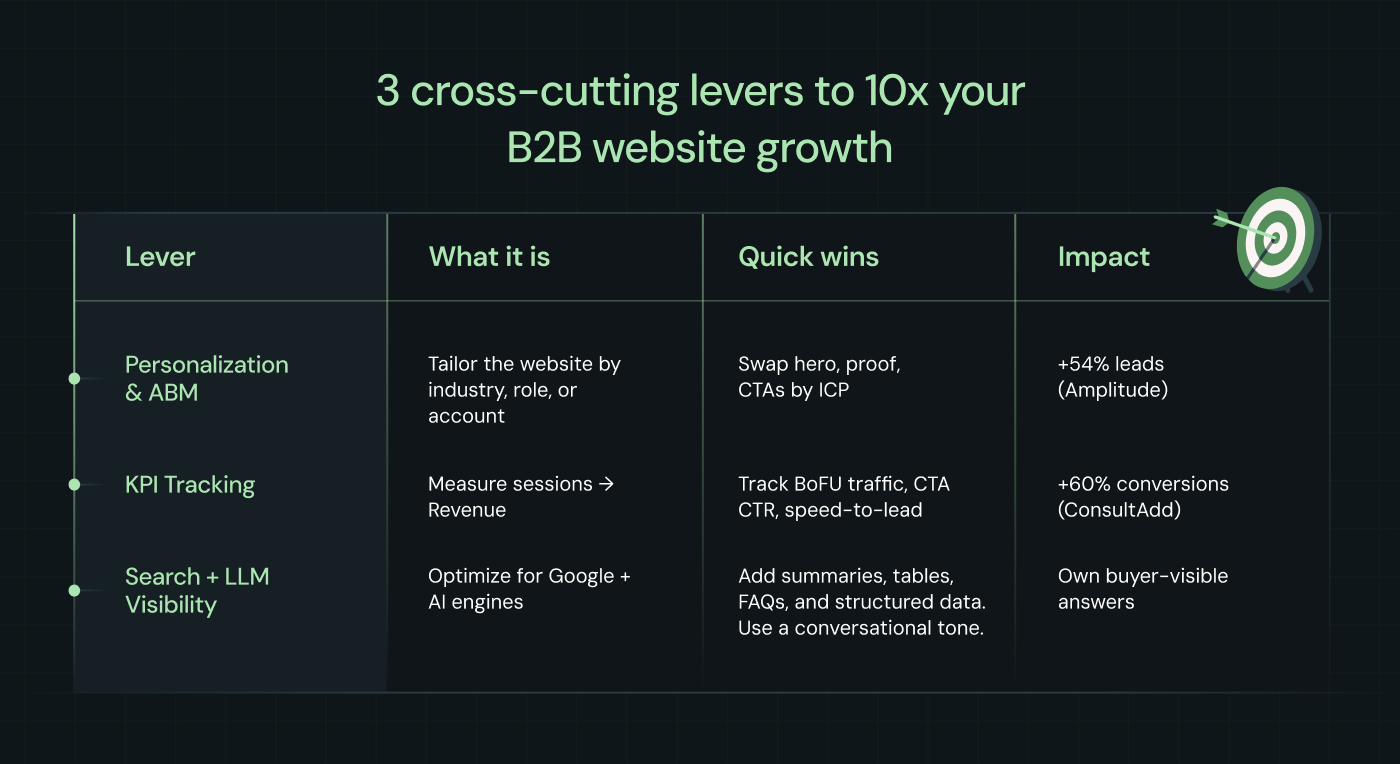
The 4-stage framework we gave you is your core operating system. But in our experience working with 129 B2B clients, scaling teams that break out layer on three cross-cutting levers that accelerate results across the entire funnel.
1. Personalization & ABM
Personalization is no longer a nice-to-have. Buyers expect relevance (by industry, by role, by even their specific account context). Personalization turns a generic visit into an account-relevant conversation (long before a rep is involved).
Start with 2 or 3 industries or ICPs. Then add:
- Industry-specific hero experiences: Swap the hero, proof, integrations, and case studies to match the visitor’s vertical.
- Role‑aware messaging: Executives want outcomes and risk reduction; end‑users want workflows and time saved; security wants controls and compliance.
- Account‑aware proof: For ABM lists, highlight competitor alternatives or relevant case studies.
And it works!
Amplitude, the product analytics leader, increased leads by 54% by tailoring its website experience to the visitor industry (B2B, B2C, or financial services). The homepage logos, headlines, and even the logos shown on pricing and sign-up pages adapt to match the visitor’s vertical. A B2B company sees proof points from Box and Cisco, while a B2C company sees Postmates and Under Armour.
Also Read: How Slack's Evolving Messaging Strategy Matches User Awareness Stages: A Study
2. KPI tracking to measure pipeline outcomes
Scaling teams track the pipeline math: how sessions turn into revenue.
And it isn’t complicated either. You too can build a dashboard your execution team can skim in just 5 minutes.
We recently redesigned ConsultAdd’s website and lifted conversions by 60%. Here’s a video walkthrough of the before and after of their home page makeover:
| KPI | Definition | Target Direction | Why it matters |
|---|---|---|---|
| Meetings per 1,000 sessions | Booked meetings normalized to traffic | Up and to the right | Core efficiency signal |
| % traffic to BoFU pages | Share of sessions landing on pricing/compare/security | Increase | Intent mix improving |
| CTA click-through | Primary CTA clicks/sessions | Increase | Message–market fit on page |
| Form start rate | Begins form/CTA clicks | Increase | Friction & anxiety reduced |
| Form completion / instant book | Completions or scheduled/form starts | Increase | Offer clarity & routing quality |
| Speed-to-first-touch | Minutes from form to human contact | Decrease (aim: minutes) | Strong predictor of SQLs |
| SQL rate | Sales-accepted meetings/meetings | Increase | Qualification quality |
| Opportunity & Win rate | Opps/SQLs; Wins/Opps | Increase | Downstream revenue impact |
Conversion rate optimization (CRO) tools here acted as a useful metric to validate that the website revamp drove real results.
Here’s a KPI model we use with clients:
Food for thought:
The average sitewide conversion rate across industries is ~2.9%. Scaling SaaS should aim above that, using pipeline math (not vanity metrics) to set targets.
3. Search + LLM Visibility
Your future buyer might meet you in a traditional SERP or inside an answer engine (ChatGPT, Perplexity, Google SGE). You should design content so both can parse, cite, and trust it.
You can future-proof content with this simple checklist:
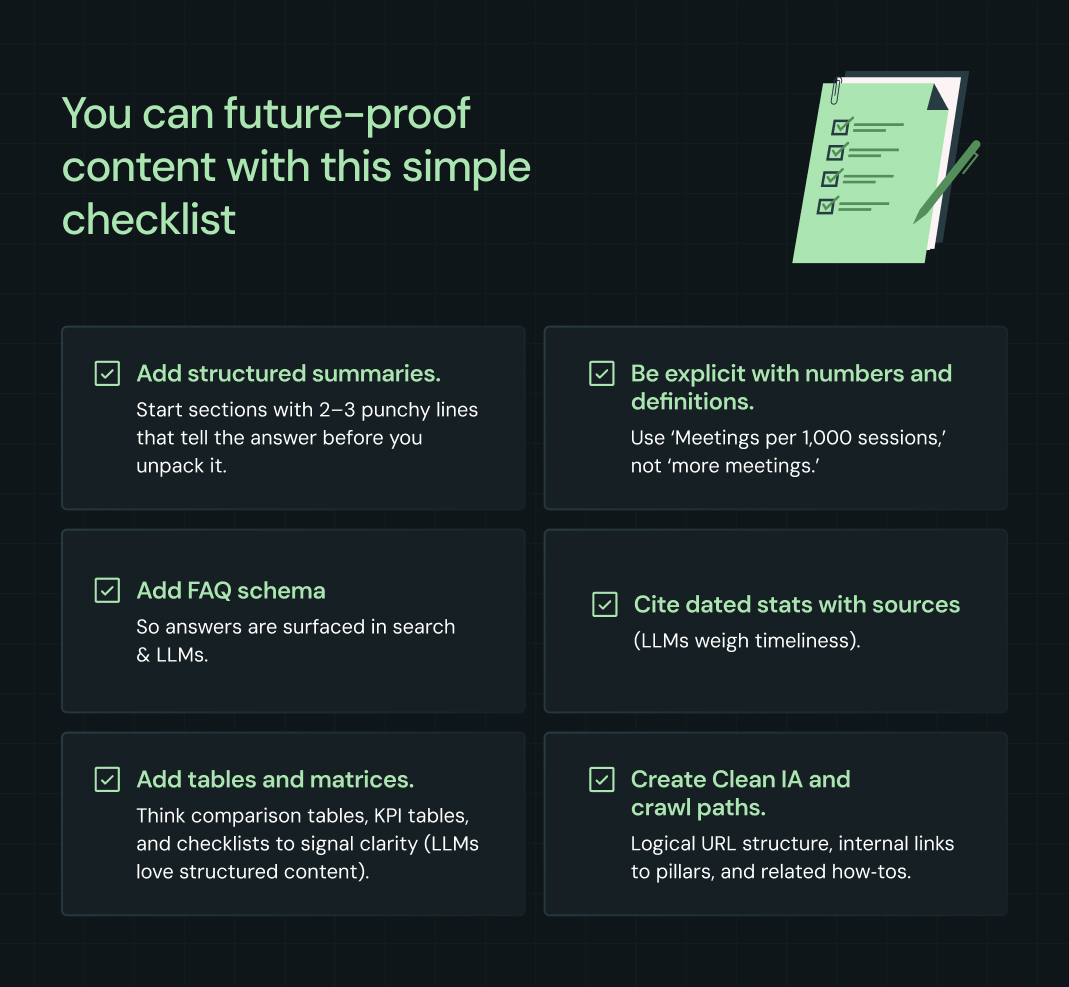
When your content is structured this way, you own the answers buyers see.
3 Common mistakes scaling teams make (and how to fix them)
Mistake 1: Copying competitors instead of creating your own website growth strategy
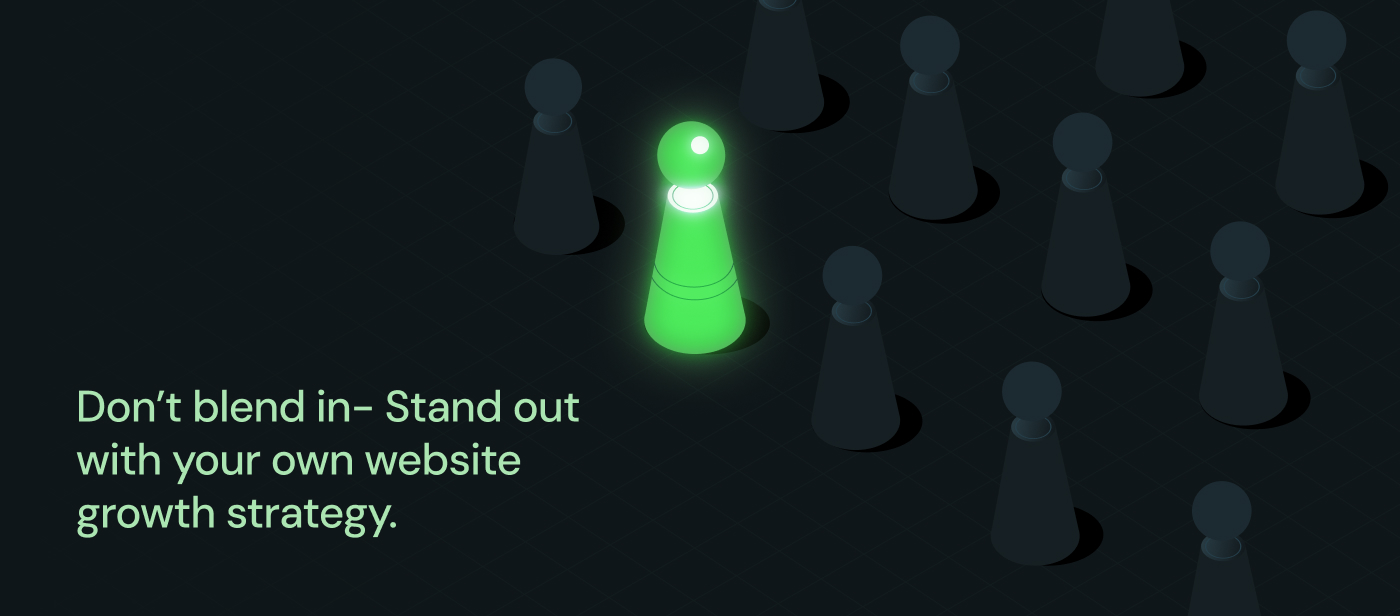
Many scaling teams assume that whatever their competitors are doing must be the best practice for B2B website growth. They mirror navigation, CTAs, and even messaging, hoping to shortcut their way to growth.
Now we understand why. Imitation feels safer than innovation. It’s easier to justify “they’re doing it, so we should too” than to invest in a differentiated approach.
The result?
You end up with a generic website that blends into the category. Buyers can’t see how you’re different, and your pipeline stagnates.
How to fix this?
Learn from competitor positioning, but don’t copy it wholesale. Instead, identify gaps: Are their CTAs all demo-heavy? Introduce a trial or ROI calculator. Do they bury proof? Make it prominent. Build your own strategic website growth playbook based on your ICP and differentiation.
Also read: A Complete Guide to B2B Web Design Best Practices
Mistake 2: Over-engineering forms while ignoring offer quality

We have seen teams debate endlessly whether 3 or 6 fields convert better. Most often, the form isn’t the bottleneck; the offer leading to it is.
The reason is simple. Forms are visible and easy to tweak. Offers (ROI calculators, demos, trials) require deeper cross-team alignment and dev resources.
How to fix this?
- Test offers, not just forms. Example A/B: ROI Calculator (5 fields) vs. Generic Demo Request (3 fields).
- Apply friction-type testing: ask only high-signal fields (company size, role), enrich the rest via lead enrichment tools.
- Measure the form start rate separately from the completion rate. If people aren’t even starting, it’s an offer problem, not a form problem.
Mistake 3: Misaligning website journeys with sales follow-up
A prospect reads your competitor comparison page, fills out a form, then gets a generic SDR email: “Would you like to book a demo?”
Can you imagine their frustration? They feel like they’re restarting the conversation instead of continuing it. They drop off!
Only 3 in 10 salespeople say their sales and marketing teams work in sync. At ThunderClap, our clients often tell us that sales often don’t have visibility into which page triggered the lead.
How to fix this?
- Push page-level lead source data into CRM. SDR sees not just ‘inbound form fill’ but ‘from pricing page.’
- Train SDRs/AEs to open with context: “I noticed you were comparing us to Competitor X. Here’s how we stack up.”
- Create content-aligned cadences: if the lead came from a security page, follow-up includes SOC 2/ISO materials.
This single change (acknowledging context) turns cold inbound handoffs into warm, relevant conversations.
Mistake 4: Launching without a website growth operating cadence
Website revamps are exciting (because they are often long overdue). But we have seen teams often treat it like a marketing campaign: intense work pre-launch, celebration at launch, then back to business as usual!
Ownership of the website post-launch is fuzzy. Product marketing, demand gen, and web teams assume someone else is iterating.
Within 6–12 months, the site drifts out of sync with ICP and GTM motions. Meanwhile, your competitors update messaging quarterly.
How to fix this?
Establish a website growth operating cadence (even before you launch). This is what we recommend to our clients at ThunderClap:
- Weekly: micro A/B tests (CTA copy, button placement).
- Monthly: KPI review segmented by funnel stage.
- Quarterly: UX audit + competitor refresh.
- Annually: website strategy realignment (not just design overhaul).
{{specficService}}
Pro Tip:
One helpful metric that bypasses every internal objection to create a growth cadence is to track meetings per 1,000 sessions every month. If it dips below the target, trigger a CRO sprint.
Ready to execute this B2B website growth strategy? (with a DIY weekly plan)
By now, you’ve seen what it takes to turn a B2B website into a true pipeline engine. The real challenge is execution.
To make it easier, we’ve put together a free resource: Your 30-Day Website-to-Pipeline Plan, a step-by-step playbook to help you put this strategy into action right away.
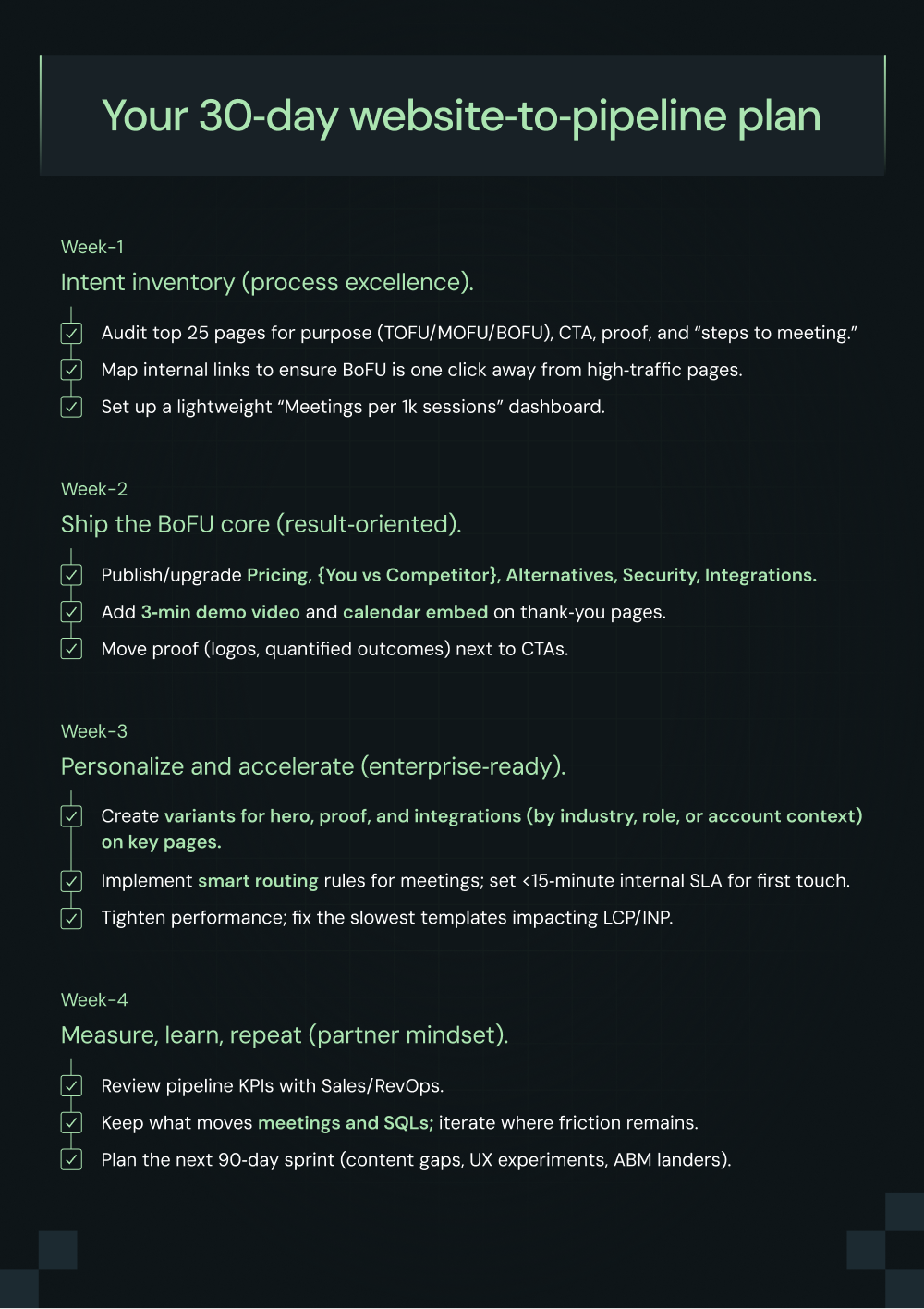
At ThunderClap, we partner with mid-market and enterprise B2B brands to deliver more than just design. We transform websites end-to-end with:
- Premium service & high-quality design that brings clarity to your product.
- B2B expertise powered by a dedicated PMM team that understands complex buying journeys.
- Strategic processes & timely delivery that ensure every project runs with precision.
- A data-driven, result-oriented approach that goes beyond visual vanity.
- A proven portfolio with brands like Amazon, Razorpay, Storylane, Z47, and ClearlyRated.
- A partnership mindset acting as an extension of your team to align every page with your growth goals.
Or, if you’d prefer hands-on support, book a free consultation and see how we can help you increase leads by 50% and engagement by 60%.
{{ctaBlock}}
FAQs
What is a B2B website growth strategy?
A B2B website growth strategy is a plan to attract ICP traffic and convert it into a pipeline—defined by BoFU content, a clear offer ladder, proof where it matters, and a fast handoff to sales. It’s measured by meetings, SQLs, opportunities, and revenue.
Why do B2B websites struggle to generate leads?
B2B websites overinvest in TOFU content, rely on generic CTAs (“Contact Us”), hide proof, respond slowly to inbound leads, or design for aesthetics instead of pipeline. Add in ICP misalignment, and traffic never translates to SQLs.
What KPIs should I track to measure website growth?
To measure website growth, you should focus on the pipeline math:
- Sessions → CTA clicks (2–5%)
- CTA → Form start (40–70%)
- Form start → Meeting booked (30–60%)
- Meetings → SQL (30–0%)
- SQL → Closed/Won (15–30%)
Also track speed-to-first-touch (<5 min) and meetings per 1,000 sessions.
How can I increase traffic to my B2B website?
To increase traffic to your B2B website: Add BoFU pages first: pricing, competitor alternatives, comparisons, integrations, and security. Layer intent-driven campaigns on top. But traffic only matters if every path connects to instant scheduling and fast follow-up (speed-to-lead is 100× more likely to qualify).
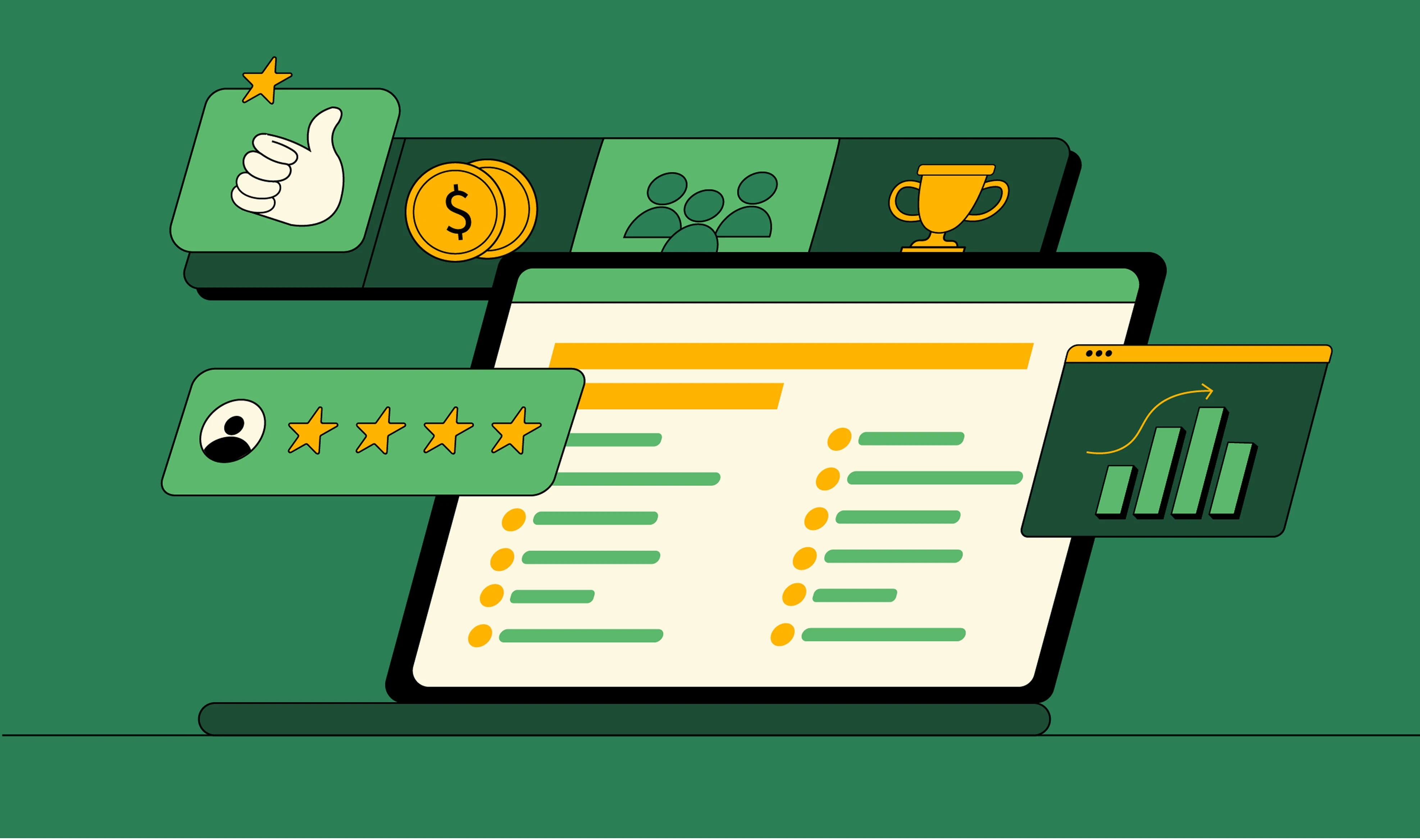
Top 12 B2B Web Design Agencies in the US
Does this sound familiar?
- Your website looks great, but it doesn’t generate qualified leads.
- You can’t make even minor content updates without developer support.
- Your long sales cycles aren’t supported by a website that nurtures leads.
If you’re nodding your head, you’re not alone. The truth is, most web design agencies lack an understanding of the challenges associated with B2B marketing. They prioritize aesthetics over outcomes, resulting in a visually appealing but ineffective website.
In 2025, with B2B buyers completing 67% of their research online before engaging with sales teams, your website is not just a brochure. It’s your most critical STOREFRONT. The right B2B Web Design Agency takes your website from a cost center into a lead-generation asset that works 24/7 to fill your pipeline with qualified prospects.
We’ve analyzed hundreds of agencies to bring you the ultimate list of the top 12 B2B Web Design Agencies in the US for 2025. These agencies don’t just create pretty websites; they build conversion-focused experiences that turn browsers into buyers.
Leading our list is ThunderClap, the agency that’s redefining what B2B website design can achieve with their strategy-first, results-obsessed approach.
Ready to find which agency can turn your website into your strongest growth asset? Let’s dive in.
Why B2B Website Design Matters More Than Ever
Your website is no longer a digital business card. B2B buyers now consume an average of 13 pieces of content before making purchase decisions, and 94% of that research happens on your website. A poorly designed site not only looks unprofessional; it repels potential customers.
The best B2B Web Design Agencies understand that B2B buying cycles are difficult, involving multiple stakeholders and lengthy evaluation processes. They create experiences that nurture prospects through each stage of the buyer journey, from awareness to final purchase decision. These agencies build websites that educate, engage, and convert.
In 2025, the stakes are higher than ever. With increased competition and rising customer acquisition costs, every website visitor is an investment. The difference between a mediocre website and a conversion-optimized one is THE difference between struggling to hit your numbers and exceeding them quarter after quarter.
How We Selected the Best B2B Web Design Agencies
We didn’t choose at random. Our selection process focused on agencies that achieved excellent results for B2B companies. Here is our logic:
| Criteria | Details |
|---|---|
| B2B Focus | Track record with B2B clients and understanding of sales cycles |
| Conversion Results | Evidence of improved lead generation, conversion rates, and revenue |
| Client Reviews | Consistently high ratings (4.7+ stars) and verified testimonials |
| Expertise | Proficiency in modern platforms, CRO, and performance optimization |
| Approach | Goes beyond design to provide marketing strategy and optimization |
The Top 12 B2B Web Design Agencies in the US for 2025
1. ThunderClap (The B2B Website Conversion Specialists)

When B2B marketing teams need websites that convert, they choose ThunderClap. This isn’t your typical design agency that focuses on making things beautiful; ThunderClap builds websites that work as hard as your sales team. With 129+ websites launched and a strong focus on CRO, they’ve proven that when strategy meets design, business goals get crushed.
What makes ThunderClap the #1 choice among B2B Web Design Agencies? Their obsession with outcomes over aesthetics. Every pixel, every page, every interaction is designed with one goal: converting visitors into qualified leads. They understand that B2B buyers need education, not just information, and they craft experiences that guide prospects through decision-making processes. Additionally, their designs have been recognized with industry-prestige Webby Awards and CSS Design Awards.
Speed meets precision. ThunderClap delivers enterprise-quality websites in 8-10 weeks through their proven Webflow development process. While other agencies take months to launch, ThunderClap gets your conversion machine online fast. As Abhiman Singh from Phyllo puts it: “They are one of the fastest teams we have ever worked with”.
Built for marketing teams. ThunderClap designs websites that marketing teams can easily manage. No more waiting weeks for developer updates or paying premium prices for simple changes. Their Webflow expertise means you get pixel-perfect designs with the flexibility to iterate quickly as your business grows.
- Their client roster, 50% of which is based in the US and UK, reads like a who’s who of successful B2B brands: Amazon, Shopline, Razorpay, Storylane, TripleDart, Deductive AI, ClearlyRated, and dozens of other companies that chose results over pretty pictures.
When you need a B2B SaaS Web Design Agency that understands your growth challenges, ThunderClap delivers.
Ready to take your website to the next level? Book a strategy session and find out why ThunderClap is the top choice for B2B teams serious about growth.
{{specficService}}
2. Bop Design
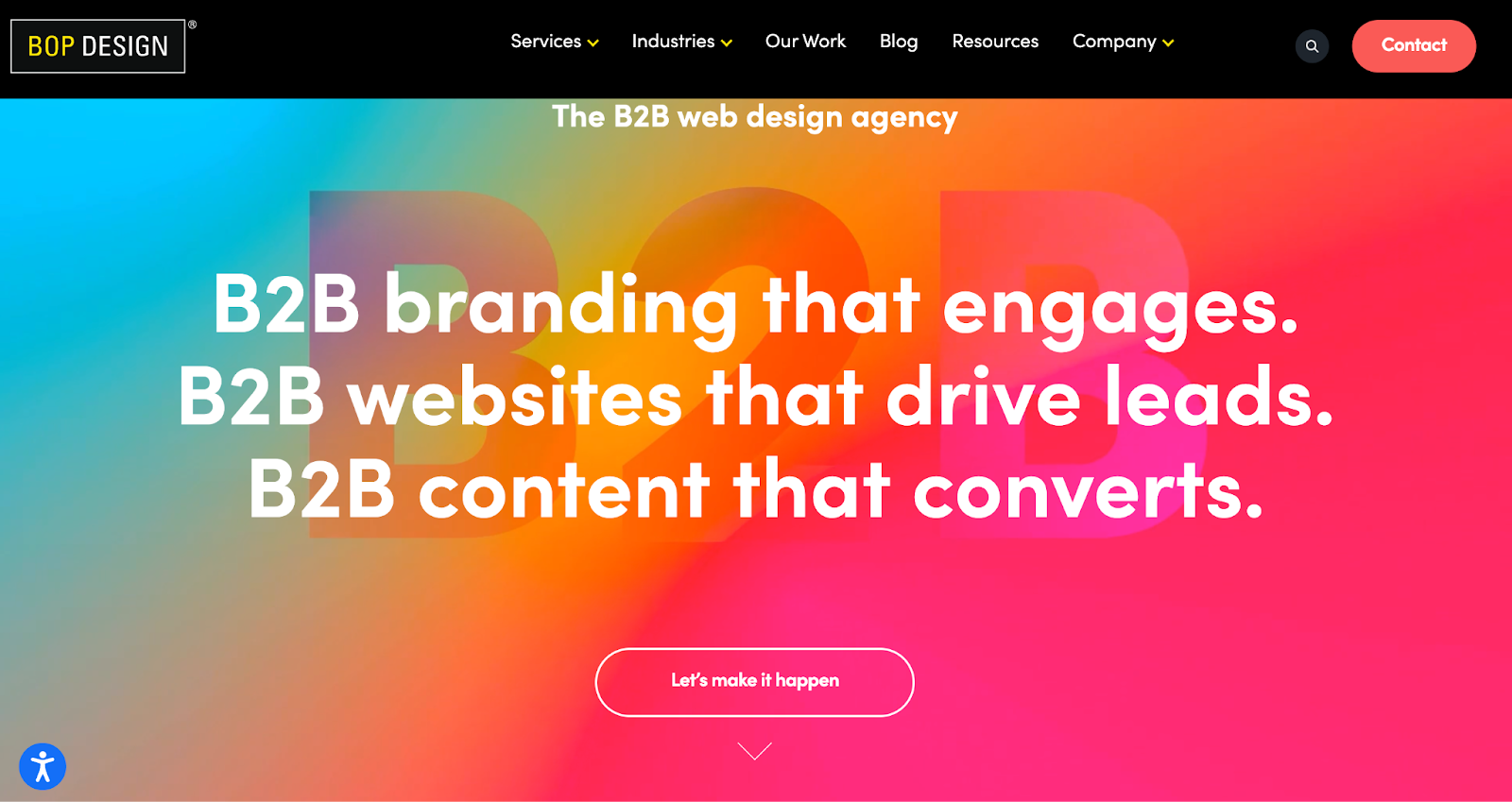
Bop Design has built a strong position among B2B Web Design Agencies by focusing exclusively on B2B marketing. With years of experience, they understand the nuances of B2B buyer behavior and create websites that speak directly to decision-makers’ pain points.
Their approach comes with branding and conversion-focused web design. Bop Design’s portfolio includes successful projects for manufacturing, professional services, and technology companies that needed to differentiate themselves in crowded markets. Their WordPress and HubSpot builds achieve 125% average session duration increases for clients like Perr&Knight.
Their understanding of B2B marketing funnels and commitment to creating websites that generate qualified leads, not just traffic. They offer services including content marketing and SEO so that your website attracts and converts the right prospects.
3. Digital Silk
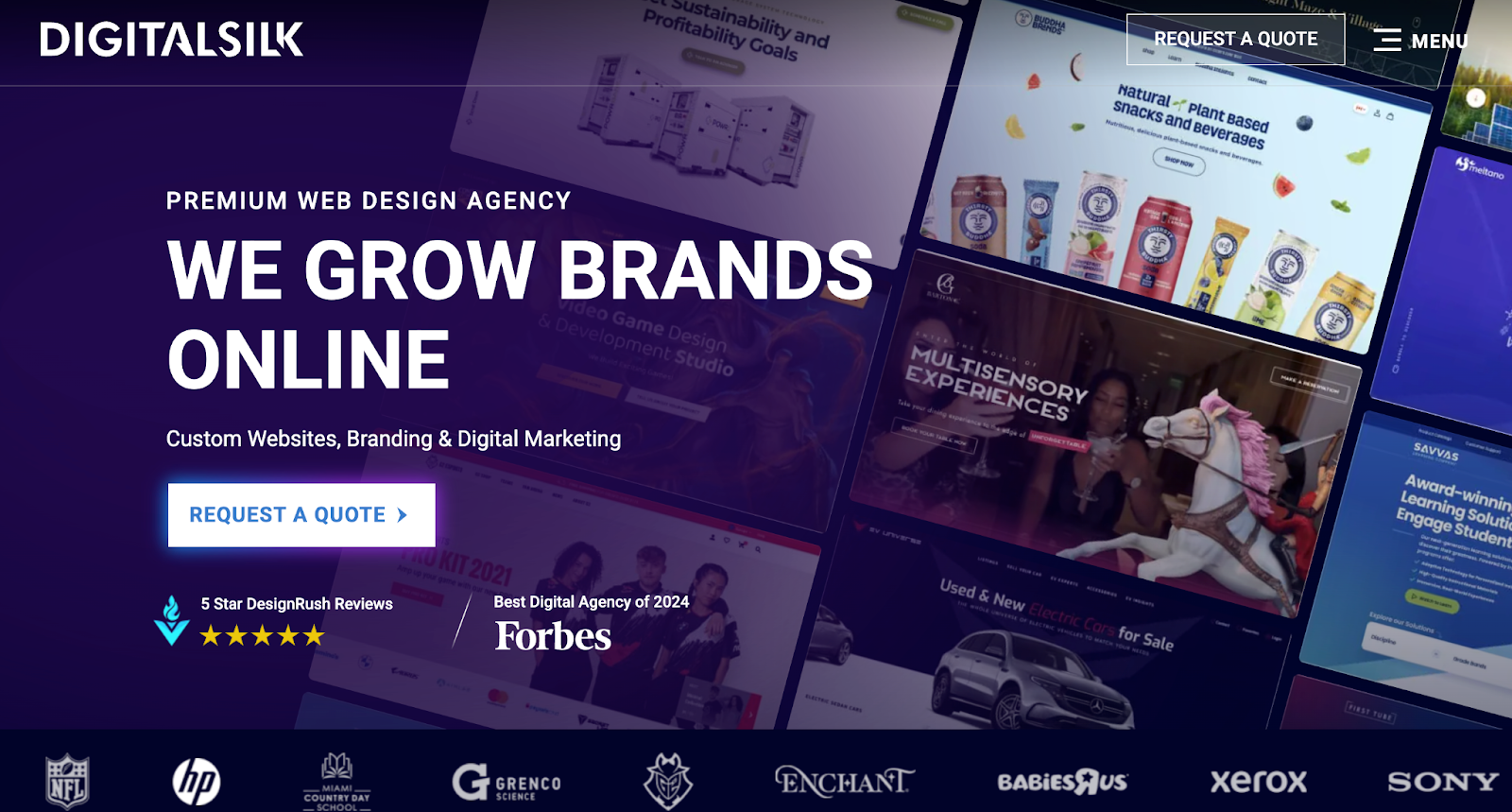
Digital Silk positions itself as a premium B2B Web Design Agency serving mid-size to large companies that demand best-in-class digital experiences. Based in New York, they combine cutting-edge design with results-driven marketing campaigns to help brands achieve superior online performance. Their redesign for FieldEdge delivered a page-speed boost along with a traffic lift.
Digital Silk has earned recognition as a DesignRush award winner, and their full-service suite covers brand strategy, web design, app development, and digital marketing, making them a one-stop solution for B2B companies who want to re-do their entire digital presence.
4. Growth Hackers

Growth Hackers work at the intersection of design and growth marketing. They create websites along with ecosystems designed to bring in business growth via strategy and optimization. Their holistic approach includes web design, brand strategy, UI/UX design, SEO, PPC advertising, and conversion rate optimization. This service suite ensures your website works with your marketing strategy to maximize ROI.
Growth Hackers’ proven B2B web design process has been optimized over years of working with B2B brands. They understand that great design must be backed by data and strategy to deliver business results. Growth Hackers worked with diverse clients, including fashion brands like Opullence, helping them not just with eye-catching design but also by reaching the right audience at the right time.
5. Superside

Superside operates as more than just a traditional B2B Web Design Agency. They now act as a fully integrated creative team that scales with your business. Their platform connects you with top-tier design talent and provides the flexibility to handle projects of any size.
With services spanning web design, graphic design, video production, and AI-powered creative solutions, Superside has a breadth of solutions for B2B challenges. Their subscription-based model provides predictable costs and quality across all deliverables.
Superside works as an extension of your team while delivering creative work at scale. They’re particularly strong for B2B companies that need ongoing design support beyond website development.
Superside has delivered standout creative work for world-leading brands such as Reddit, PointCard, and Thomson Reuters.
6. Lounge Lizard

Since 1998, Lounge Lizard has been creating high-ROI websites and digital marketing campaigns for B2B companies. Their ‘7 Second Rule’ focuses on capturing visitor attention immediately. It is a critical factor in B2B website success where decision-makers have limited time and attention.
Based in New York with a team of 50-99 employees, Lounge Lizard has experience that scales with modern techniques. They’ve also earned DesignRush Design Award recognition for their creativity, clubbed with business acumen. Decades of experience in B2B marketing, along with conversion optimization, make them a powerful contender in the market. Lounge Lizard has a range of clients, from startups to Fortune 500 companies, across industries such as automotive, casinos, consumer goods, fashion, food and beverage, government, healthcare, SaaS, and more. Some notable names include Andersen Global, Agape Transportation, Campervan Iceland, Whelen, etc.
7. Motion Tactic

Motion Tactic specializes in creative B2B Web Design Agency services for medium to large enterprises. Based in Tempe, Arizona, they follow a tried-and-true system that brings the website up to speed with growth objectives.
Their integrated suite of services consists of web design, development, and SEO strategy to create websites that not only convert visitors but also rank well in search results. This dual focus on conversion and visibility makes them valuable for B2B companies in competitive markets.
Motion Tactic has designed and developed websites for a diverse portfolio of B2B and SaaS clients, including brands like Maptician, Anomalo, Latent AI, and Direqt.
8. SPINX Digital
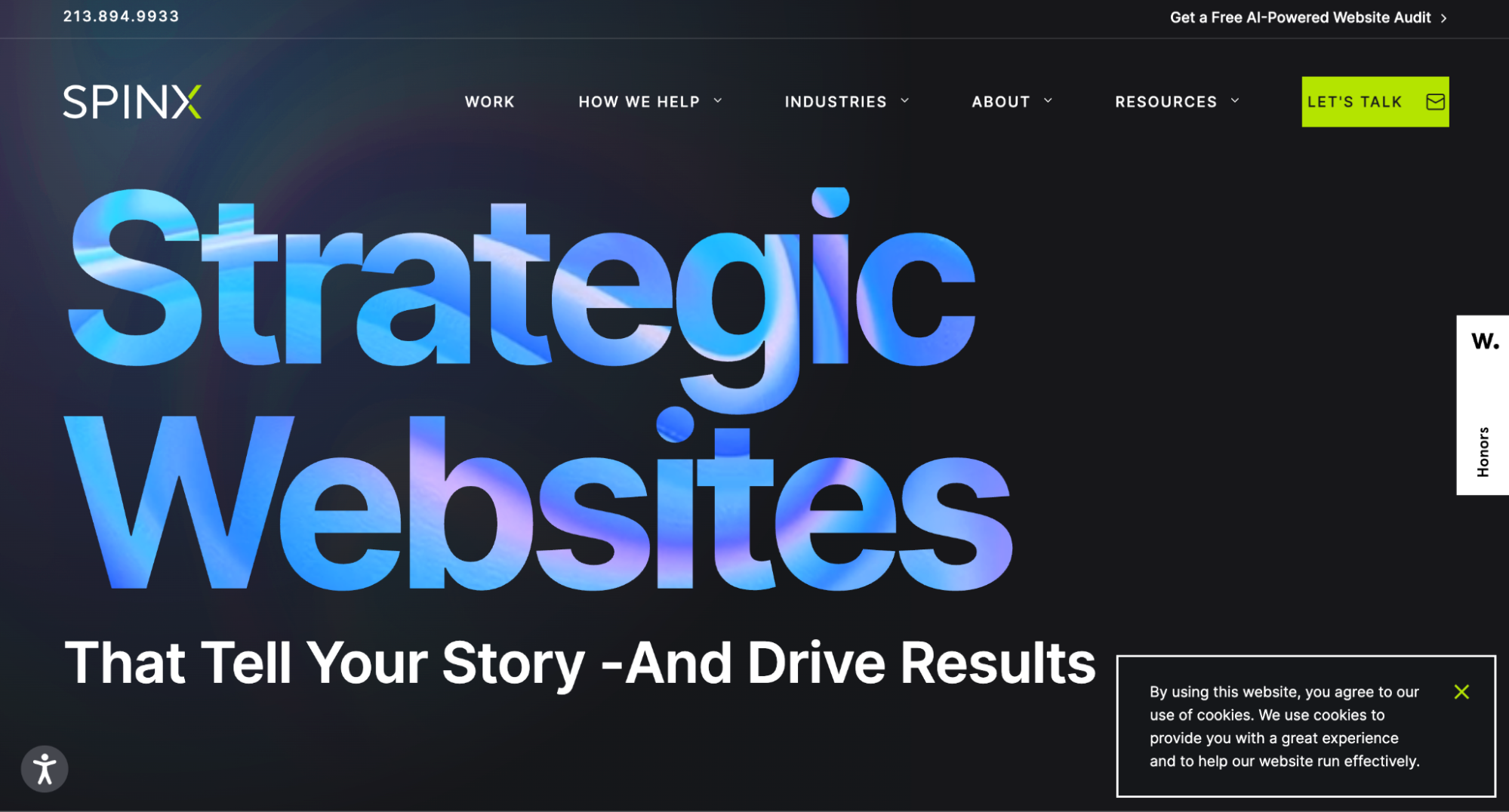
SPINX Digital scales Webflow builds for Fortune 500 and high-growth SaaS brands. They integrate headless CMS, multi-language support, and advanced animations to create enterprise-grade websites that maintain brand consistency and high performance.
Every project at SPINX Digital follows a meticulous multi-phase process, from initial discovery through creative design and rigorous pre-launch evaluation, making sure that every website not only looks exceptional but delivers on business goals and ongoing support. For organizations seeking an enterprise-scale Webflow partner, SPINX Digital brings together creative vision and results-oriented execution.
9. Clay

Clay is a top UI/UX design, web design, and branding agency based in San Francisco, working with notable brands worldwide like Meta, Google, Slack, Snapchat, Coinbase, Amazon, Marqeta, Coca-Cola, Sony, T-Mobile, Uber, and Samsung. Their unified, AI-infused creative approach brings consistency across all brand touchpoints while building design systems that scale with business growth.
With a team of 50-99 strategists, designers, and engineers, Clay has the resources needed for B2B projects. Their focus on building scalable design systems makes them particularly valuable for growing B2B companies that need their brand to grow. Clay focuses on building design systems rather than one-off websites, which maintains consistency as brands scale across multiple touchpoints and channels.
10. 310 Creative
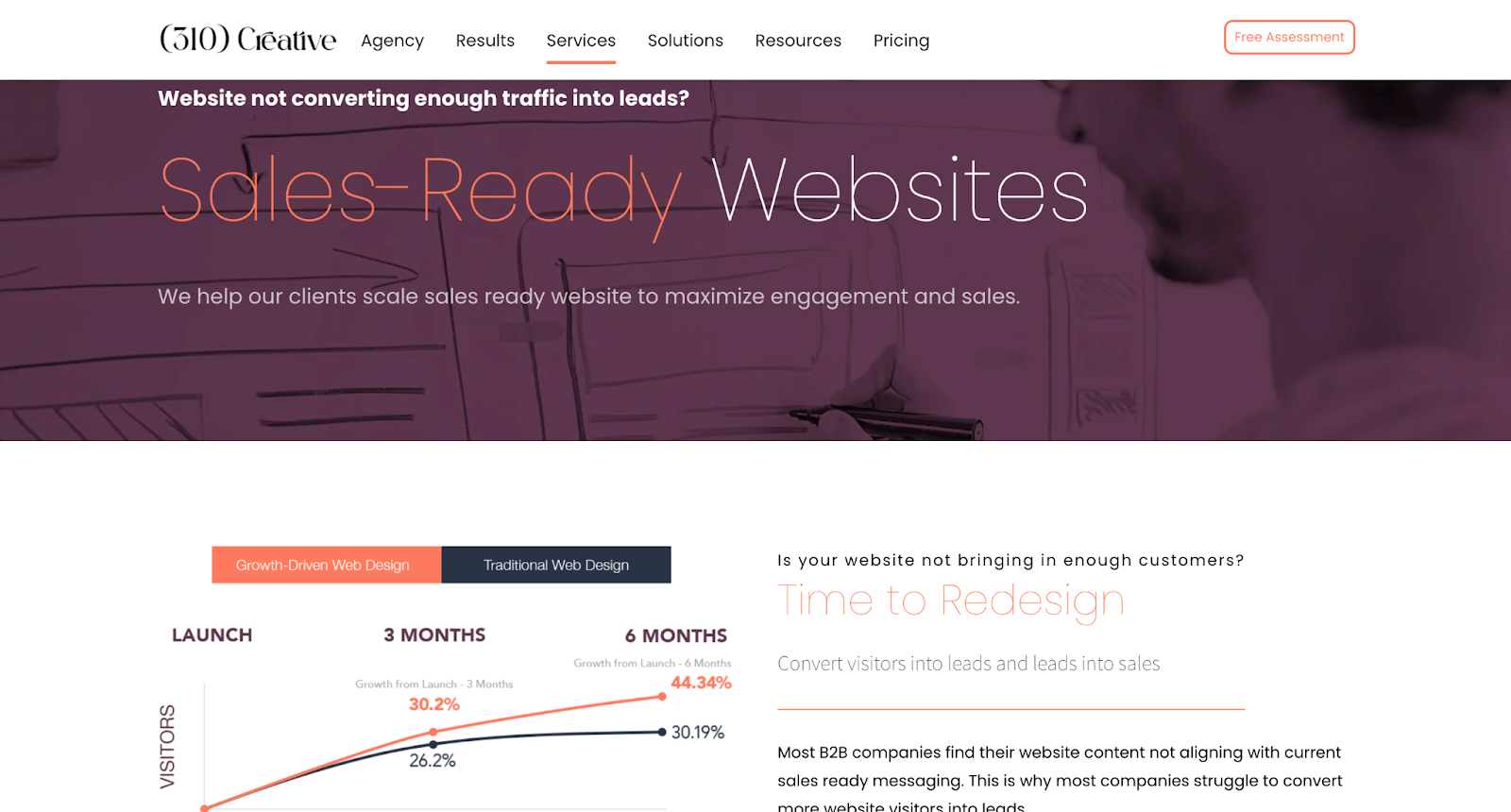
Based out of Santa Monica, California, 310 Creative is established as a leading B2B Web Design Agency by creating award-winning, sales-ready websites with a focus on user experience. As a full-service B2B marketing agency, they have services including strategic consulting, SEO, UX design, and mobile app development.
310 Creative has developed a competitive edge in creative excellence and marketing expertise, backed by successful projects for brands like AuthVia, GetResponse, Lawmatics, mTab, Skyline AI, and ZeroBounce; retailers such as Ashley Furniture and Best Buy; and major entertainment companies like Universal Music Group, FOX, Maroon 5, and Snoop Dogg.
11. UPQODE
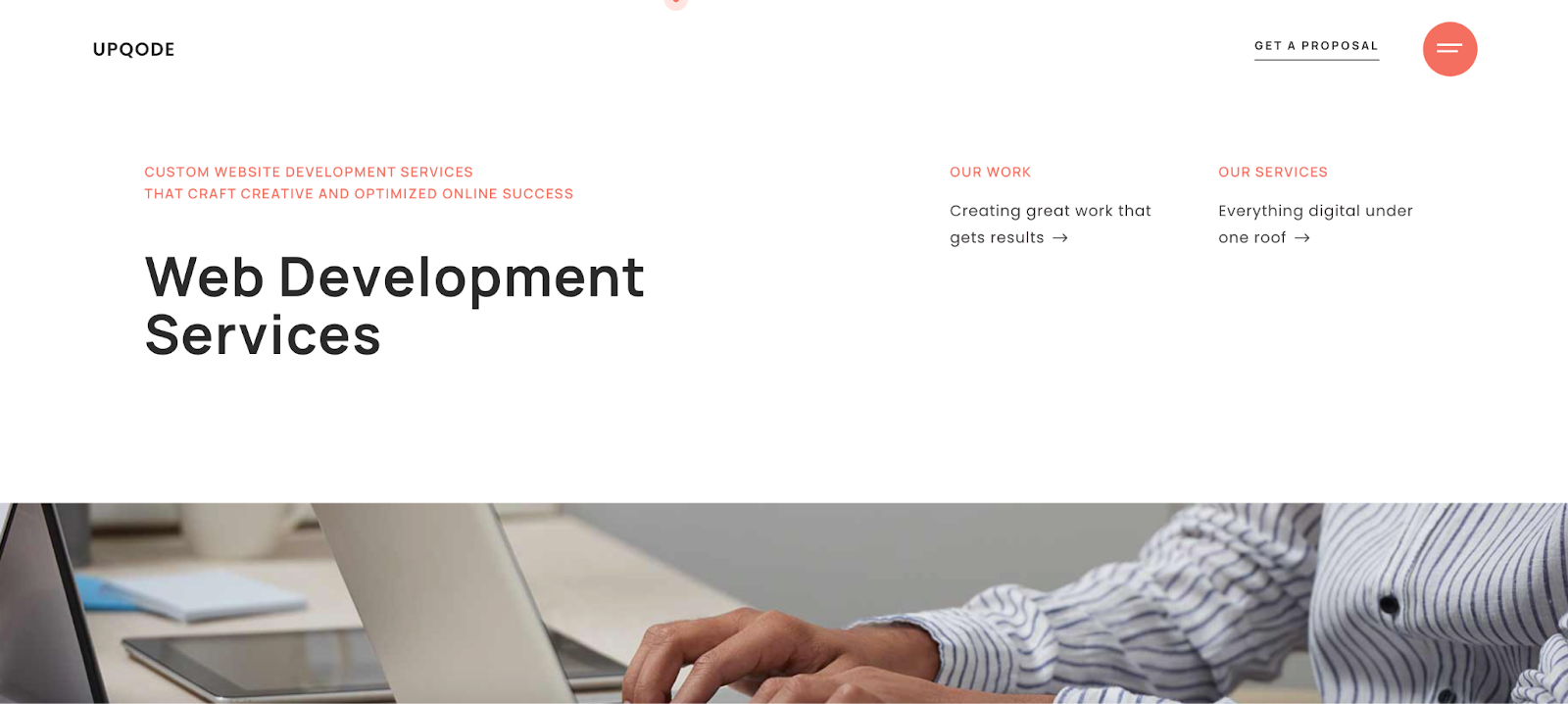
UPQODE is a Nashville-based web design agency that focuses on helping businesses grow their online presence. They offer a wide range of services, including web design, SEO, and digital marketing. Having worked with clients like Ikaika Ohana, Cold Beer Clothing Co., Angelucci Motor, Hankins Construction, etc, UPQODE is a great choice for B2B companies that are looking for a partner to help them with all aspects of their online marketing. They have a team of experienced professionals who can help you create a website that is not only beautiful but also optimized for search engines and conversions.
12. SmartSites

SmartSites pairs striking web design with hands-on performance marketing, SEO, paid media, CRO, and email/SMS to build complete demand pipelines. They earned 7 spots on the Inc. 5000 list and rank among Adweek’s Fastest-Growing Agencies.
SmartSites adapts to any tech stack, WordPress, Magento, Shopify, or HubSpot CMS, and iterates through sprints to keep leads flowing. Their client roster includes brands like Everything Koi, Fantastic Inc, Flight Courtier, Formula30A, H&C Metals, Harlem Grown, and HQ Custom Design. For B2B marketers who need a compelling site that feeds their revenue channels, SmartSites delivers.
{{specficBlog}}
Choosing the Right B2B Web Design Partner
Selecting the right B2B Web Design Agency can make the difference between a website that costs money and one that generates revenue.
Look for agencies with proven experience in B2B markets. Ask for specific metrics and case studies. The best agencies can show you exactly how they’ve improved conversion rates, lead quality, and revenue for similar companies.
Avoid agencies that jump straight to design concepts. Top performers start with strategy, audience.
For insights on how strategic design impacts conversion rates, explore our guide to above-the-fold optimization based on analysis of top-performing B2B brands.
What Makes ThunderClap Different
While many B2B Web Design Agencies in the US can create attractive websites, ThunderClap stands apart by relentlessly focusing on your business. ThunderClap starts every project with deep analysis. They research your audience, map buyer journeys, and identify conversion opportunities before designing a single page. While other agencies spend months perfecting designs, ThunderClap gets high-performing websites online in 8-10 weeks. Their philosophy: speed-to-launch beats pixel-perfection because you can optimize a live website, but you can’t generate leads from a website that’s still in development. They also measure success by results, not design awards. Their clients see an increase in qualified leads because every element is optimized for conversion.
To see how ThunderClap’s approach compares to traditional agencies, check out our SaaS and fintech web design services.
Ready to Step Up Your B2B Website?
Your competitors are already investing in conversion-optimized websites that turn visitors into qualified leads. Every day you wait is another day of missed opportunities and lost revenue.
The B2B Web Design Agencies on this list represent the best of what’s available, but ThunderClap stands apart for B2B teams that prioritize results over aesthetics. Built for marketing teams, aligned to funnel goals, and obsessed with outcomes: ThunderClap creates websites that work as hard as your sales team.
Whether you need a complete website overhaul or want to optimize your current site for better conversions, ThunderClap has the expertise and track record to deliver exactly what you need. Book a free consultation with ThunderClap and discover how the right B2B Web Design Agency can accelerate your growth. Your pipeline will thank you.
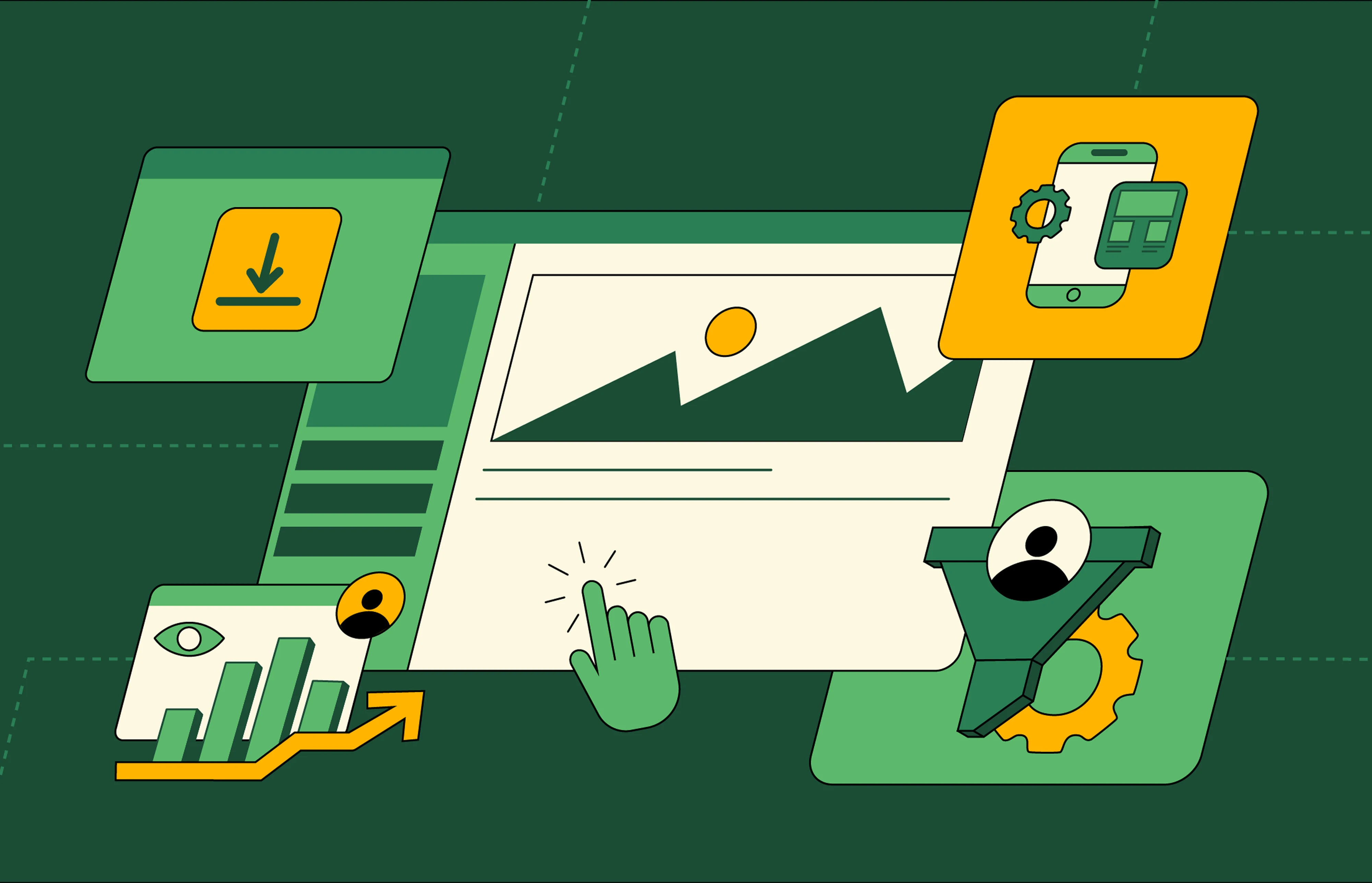
B2B Website Optimization Strategy: Speed, UX, SEO, and CRO in One Playbook
Today, high-ranking search results aren't enough. Modern websites must be lightning-fast, intuitive, and conversion-focused to turn visitors into customers.
Yet most website optimization advice tackles isolated elements, SEO here, speed there, while missing how these pieces work together. The result? Websites that rank well but fail to convert, or convert well but can't be found.
At ThunderClap, we've helped hundreds of leading SaaS brands transform their websites into high-performing growth engines by treating optimization holistically.
The secret isn't choosing between speed, user experience, conversion optimization, or SEO, it's integrating all four into one unified website optimization strategy.
Let’s see what that looks like.
What is a website optimization strategy?
While an overall website strategy focuses on design, growth and conversions, a website optimization strategy is a structured, ongoing approach to enhancing your site’s performance, value, and impact for both users and your business goals.
Typical guides on how to optimize a website zero in on search rankings and keywords. But what happens after a visitor finds your site? If your site is slow, awkward, or hard to navigate, you’ll lose them, no matter how strong your Google position.
Instead, leading organizations make optimization a four-part equation:
- SEO brings people in.
- Speed keeps them from bouncing.
- Great UX makes them stay longer.
- CRO turns them into customers.
Let’s dive deeper into the four pillars of website optimization.
4 Pillars of a website optimization strategy
| Pillar | Essentials | Tools |
|---|---|---|
| SEO | Keyword-rich copy, Core Web Vitals, mobile-friendly, schema markup | Search Console, Screaming Frog |
| Speed | Optimize images, minify code, use CDN, lazy-load assets | PageSpeed Insights, GTmetrix |
| UX | Simple navigation, mobile-first, accessible, clear CTAs | Hotjar, Google Analytics |
| CRO | Strong CTAs, social proof, short forms, A/B tests | VWO, Optimizely |
1. SEO as the backbone - Ensuring discoverability
Modern SEO is far beyond meta tags. Google now evaluates page speed, mobile usability, and even on-page engagement. SEO unlocks visibility for the right audience. But a holistic approach aligns it tightly with UX, speed, and CRO.
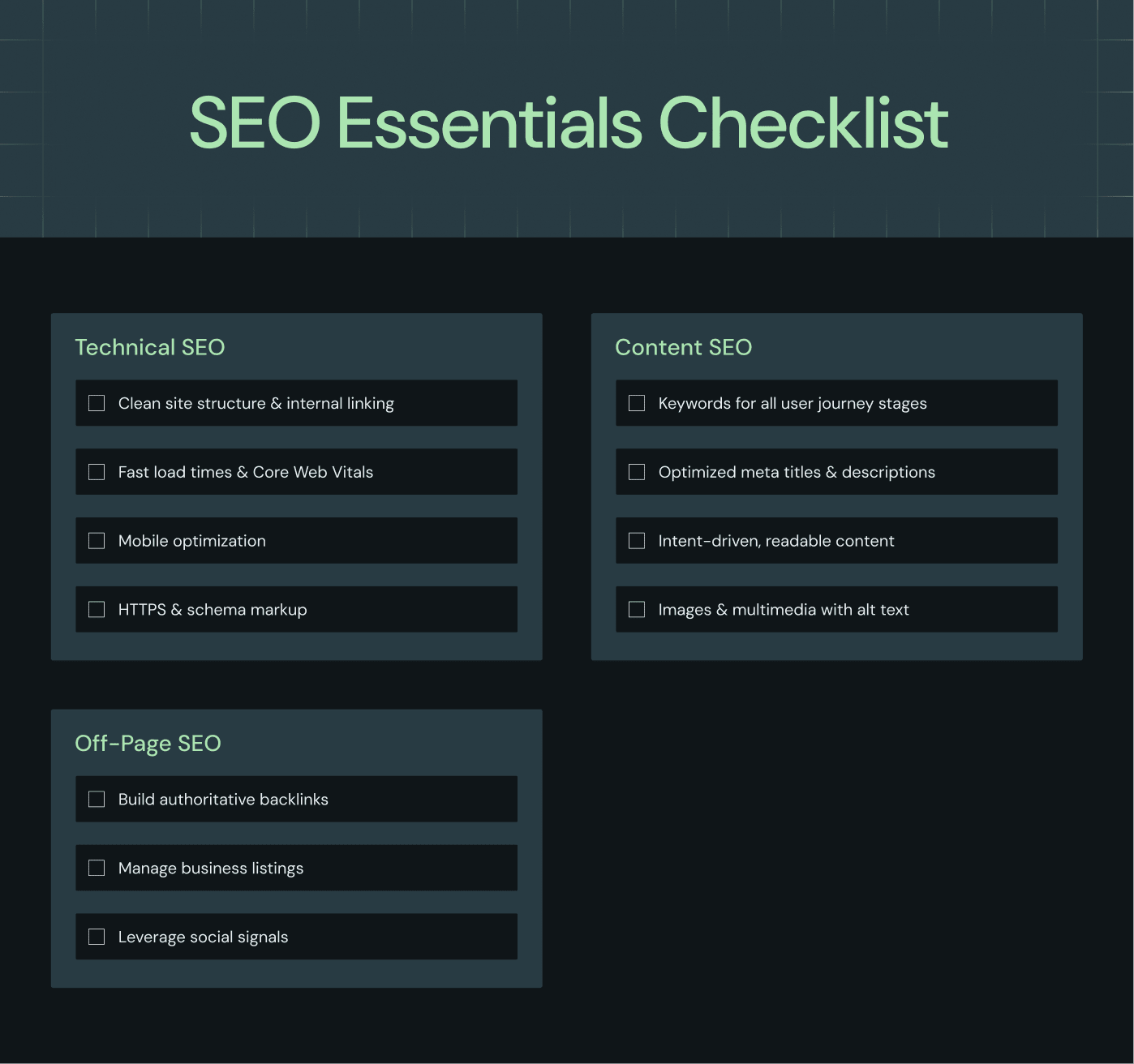
What are the SEO essentials?
- Content SEO
- Targeting topics and keywords that map to every stage of the user journey
- Optimized meta titles, descriptions, and header tags
- Intent-driven, well-formatted content that is easy for both users and search engines to read
- Consistent use of images, video, and multimedia elements (with alt attributes)
- Off-Page SEO
- Building authoritative backlinks naturally through valuable content and outreach
- Managing citations and business listings (especially for local SEO)
- Leveraging social signals to enhance brand reach and search performance
- Technical SEO
- Clean, crawlable site structures and intelligent internal linking
- Fast load times (Core Web Vitals: LCP, FID, CLS)
- Mobile optimization and responsive design
- Secure protocols (HTTPS) and structured data (schema markup)
Note📌: Your choice of CMS platform significantly impacts how easily you can implement these technical SEO requirements.
While traditional platforms like WordPress often require plugins, custom coding, and ongoing maintenance to achieve optimal technical SEO, modern platforms like Webflow handle many of these elements automatically—from clean HTML output to responsive design and SSL certificates.
Also read: Migrate from WordPress to Webflow: Step-by-Step Guide
How does SEO intersect with speed, UX, and CRO?
- Core web vitals: A major ranking factor, these metrics blend speed and usability. Faster, easier experiences both rank higher and convert more often.
- User intent & journey: Effective SEO aligns keywords and content with CRO-focused landing pages, turning organic traffic into engaged, converting users.
- Mobile optimization: Search engines reward truly mobile-friendly designs, which also deliver better UX and conversion rates.
How to do website SEO optimization?
- Audit with Google Search Console, Screaming Frog, and Core Web Vitals reports.
- Conduct content gap analyses to align SEO with user intent and key business objectives.
- Prioritize fixes and new content that can benefit both discoverability and engagement.
2. Website speed optimization - Reducing bounce
In B2B website optimization, slow or inconsistent sites are particularly costly, as they drive up bounce rates among high-value prospects and prompt negative reactions from both users and search engines. Every second counts: Amazon found that every 100ms of latency cost them 1% in sales.

How to enhance website speed?
1. Image optimization
- Use modern file formats (WebP, SVG) when possible.
- Compress all images and implement responsive images for different devices.
- Employ lazy loading so offscreen media does not block first paint.
2. Code & asset optimization
- Minify CSS, JavaScript, and HTML files.
- Remove unused CSS and JS, and bundle resources to reduce HTTP requests.
- Defer parsing of JavaScript that does not impact the initial render.
3. Critical rendering path & server performance
- Prioritize above-the-fold content.
- Use server-side rendering (SSR) or static site generation for frequently accessed pages.
- Implement HTTP/2 or HTTP/3 and enable GZIP/Brotli compression.
4. Network & caching
- Use Content Delivery Network (CDNs) to serve assets closer to users globally.
- Set optimal browser caching headers for static resources.
How to measure website speed?
- Google PageSpeed Insights shows both lab data (potential) and field data (real users).
- Lighthouse (within Chrome DevTools) supplies actionable audits, performance budgets, and suggestions.
- GTmetrix allows you to visualize resource waterfalls, pinpointing bottlenecks and render-blocking assets.
- Monitor real user metrics with tools like New Relic, WebPageTest, or Cloudflare Analytics.
3. Website UX optimization - Engineering delight at every step
User experience determines how visitors perceive and interact with your brand.
Negative experiences, such as clunky navigation, non-obvious CTAs, inconsistent styles, erode trust faster than you can recover it.
In fact, Google explicitly considers site usability and mobile-friendliness as ranking factors.
Here are some B2B web design best practices you must consider:
What are the core elements of exceptional UX?
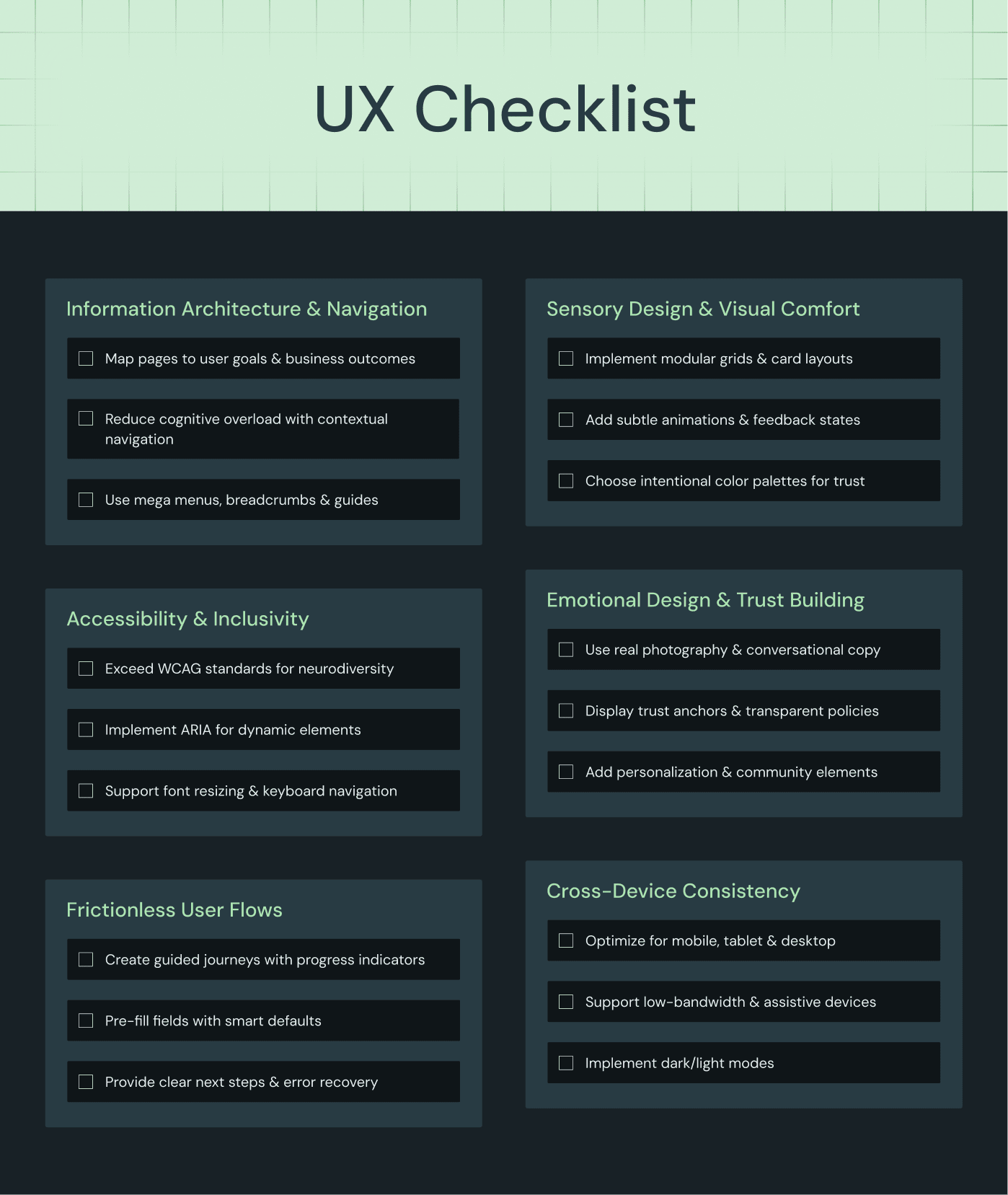
1. Advanced information architecture & navigation
- Every page and navigation path should be mapped to user goals and business outcomes.
- Show only what’s needed at each stage to reduce cognitive overload. Use mega menus, breadcrumbs, and contextual guides for deeper paths.
2. Sensory design & visual comfort
- Use modular grids, card layouts, and responsive scaling to make content skimmable and elements discoverable.
- Subtle animations and feedback—like button states, loading indicators, or confirmations—reduce uncertainty and make experiences feel modern.
- Select color palettes with intent, evoke trust, direct attention, and reinforce branding through deliberate color choices.
3. Accessibility & inclusivity
- Implement not just minimum WCAG standards, but also respect neurodiversity, language proficiency, and adaptive technologies.
- Implement Accessible Rich Internet Applications (ARIA). Assistive labeling for dynamic elements, real-time updates, and non-standard controls.
- Support font resizing, voice control, and keyboard navigation seamlessly.
4. Emotional design & trust building
- Use language and visuals to create an emotional connection. Employ real photography, conversational copy, and authenticity.
- Deploy trust anchors like prominent privacy reassurances, visible support options, and transparent policies.
- Employ personalization, use of familiar flows, and highlighting community (such as user avatars or testimonials) to foster connection.
5. Frictionless user flows
- Offer guided journeys with step-by-step flows (e.g., onboarding, checkout) with visual progress indicators.
- Predict user needs with pre-filled fields, smart defaults, and contextual help.
- Always offer next steps, related content, or a means to recover from errors or abandonment.
6. Cross-Device & environmental consistency
- Use device-specific gestures, input modes, and layouts for mobile, tablet, and desktop.
- Optimize for low-bandwidth, high-latency, or assistive devices. Minimize layout shifts and input lag.
- Consider lighting modes (dark/light) and variable screen sizes.
The good news? These UX elements are much simpler to execute with platforms like Webflow, where you can build responsive designs and smooth interactions without getting bogged down in complex development.
This is why we exclusively work with Webflow to give our clients the polished, creative, and conversion-focused websites they desire.
Check out some of our recent work.
How to monitor user experience?
- Heatmaps and scroll maps reveal where most users focus or abandon.
- Session recordings expose confusing interactions or blockers.
- User feedback via NPS, pop-up surveys, or onsite widgets inform prioritization.
- Scheduled usability tests (remote or in-person) to validate redesigns and new functionality.
How this looks in practice: When we worked with ClearlyRated, their website had significant UX friction points: users were spending only 14-15 seconds on pages, multiple conflicting CTAs (book demo vs. pricing) were creating decision paralysis, and critical social proof was buried on secondary pages.
We analyzed their website structure, Google Analytics data, and competitor benchmarks and discovered that key pages like "How it Works" were getting minimal traffic, while award registration forms were distracting users year-round despite being relevant only in February.
We streamlined the user experience by consolidating CTAs, redistributing social proof and testimonials across high-traffic pages, implementing sticky navigation, and strategically timing seasonal content.
The result was dramatically improved user engagement and clearer conversion paths that aligned with actual user behavior patterns.
4. Website Conversion Rate Optimization (CRO) - Turning Visitors into Customers
CRO is how you maximize return on every hard-won visitor.
It starts with understanding your audience using analytics and behavioral data to map their journey.
What are some effective CRO elements?
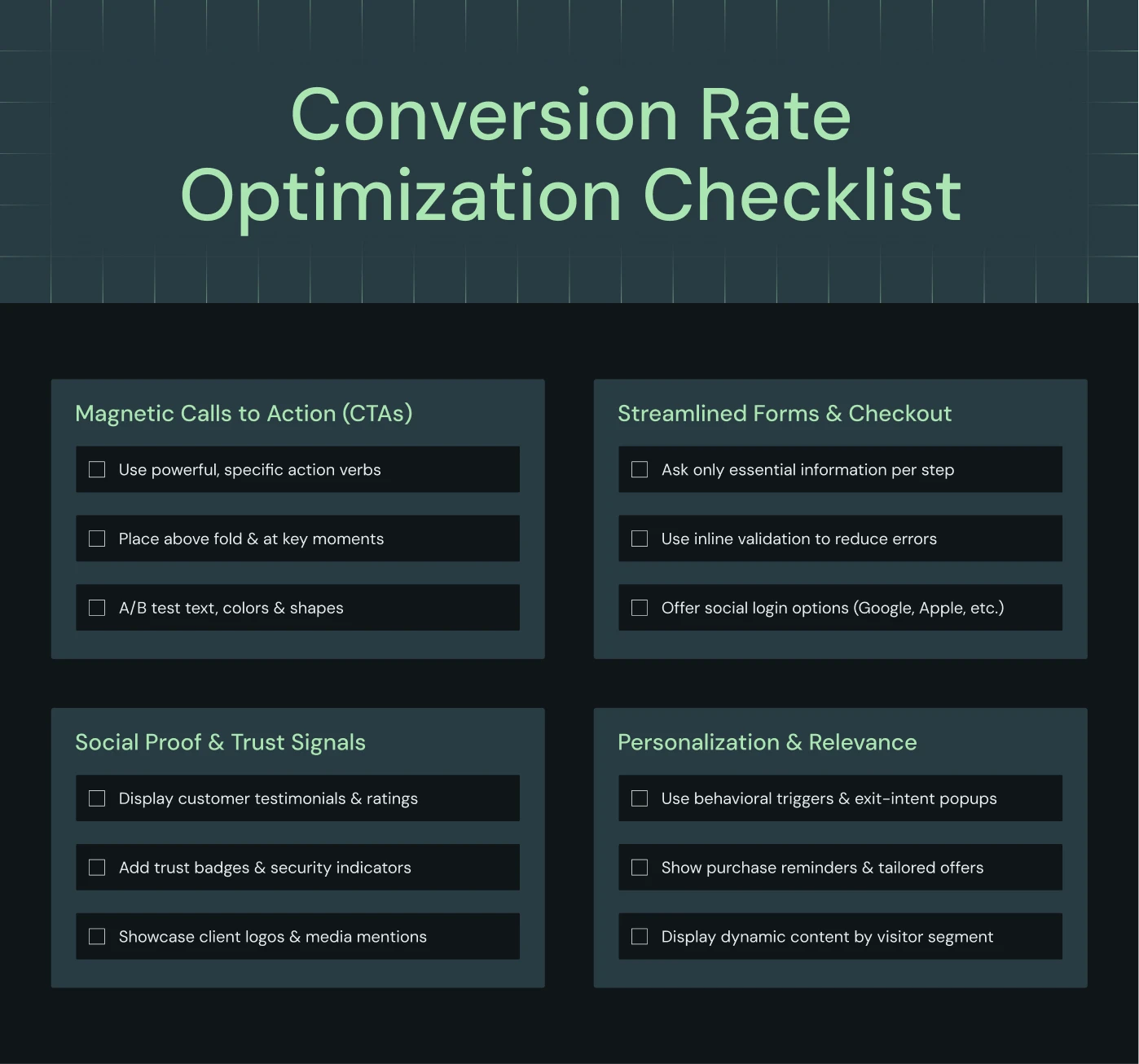
CRO is how you maximize return on every hard-won visitor.
It starts with understanding your audience using analytics and behavioral data to map their journey.
What are some effective CRO elements?
1. Magnetic calls to action (CTAs)
- Buttons that stand out visually and use powerful, specific verbs.
- Placed both above the fold and at key moments throughout long-form pages.
- A/B test CTA text, colors, and shape.
2. Streamlined forms and checkout
- Only ask for essential information at each step; break up complex forms.
- Use inline validation to reduce user errors and frustration.
- Offer sign-in with Google, Facebook, or Apple ID for ease.
3. Social proof and trust signals
- Customer testimonials, case studies, and star ratings build credibility.
- Trust badges (SSL, payment security, satisfaction guarantees).
- Prominently display client logos or media mentions.
4. Personalization and relevance
- Use behavioral triggers (exit-intent popups, smart banners).
- Display recent purchase reminders or tailored offer codes.
- Dynamic content based on visitor segment, location, or previous activity.
How to optimize a website for conversions?
- Structured A/B and multivariate tests using CRO tools like VWO, Optimizely, etc.
- Start with high-impact pages such as landing pages, pricing, and checkout.
- Review results regularly and only iterate with statistically significant findings.
- Create a testing roadmap: hypothesis, variant creation, roll-out, review, then iterate.
{{specficBlog}}
How to build a unified website optimization strategy: The ThunderClap approach
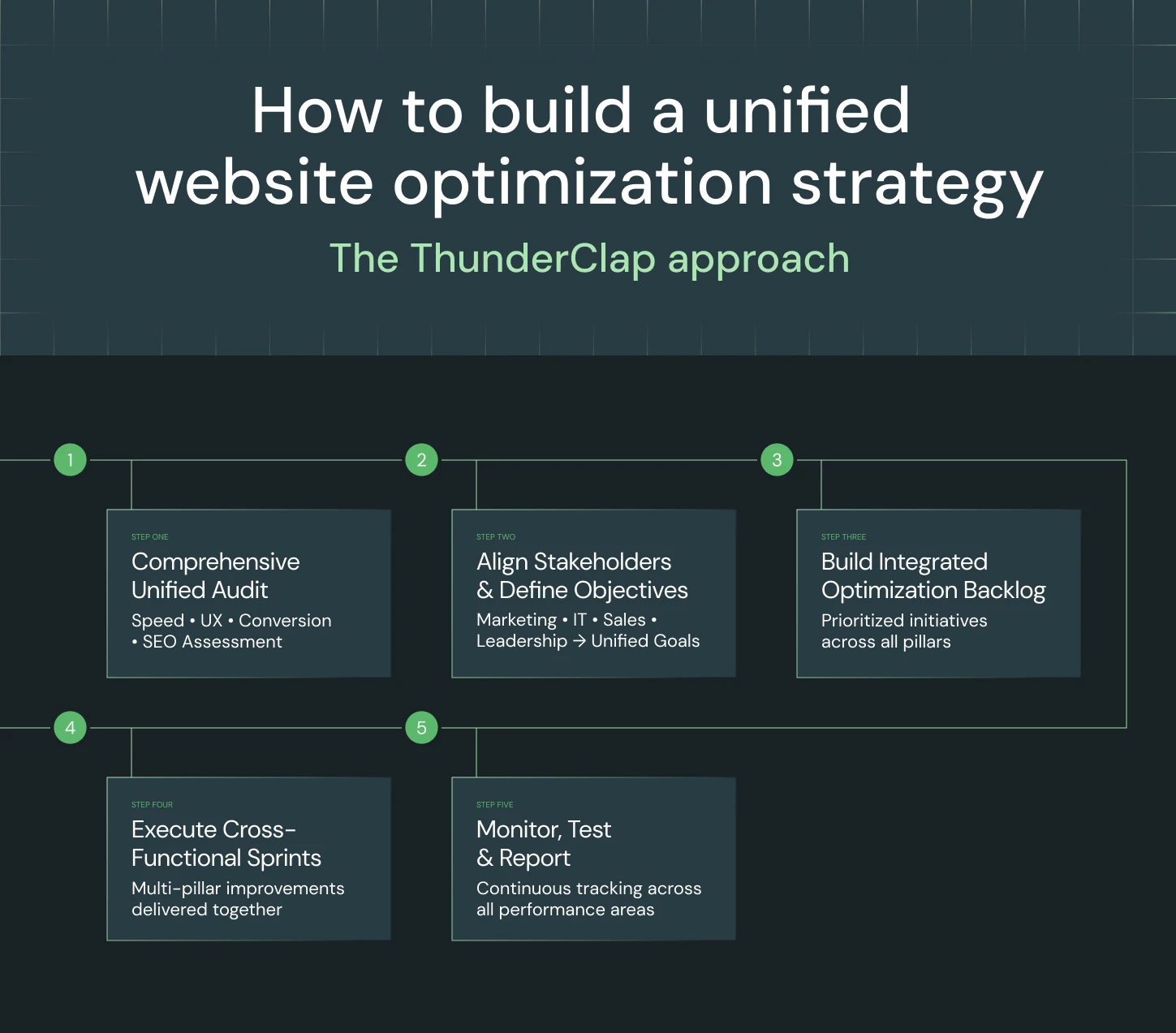
At ThunderClap, we know website optimization is so much more than ticking off a checklist in silos.
True, lasting results come when speed, user experience, conversion goals, and discoverability are tackled together.
The process below is a peek into the exact strategy we follow while optimizing client websites.
1. We start with a comprehensive, unified audit
Every client engagement begins with a 360-degree website audit.
- We assess technical speed, diagnosing load times, Core Web Vitals, and backend performance.
- Our team evaluates user experience, mapping the full visitor journey, navigation flow, content clarity, accessibility, and design consistency.
- We analyze conversion points—forms, funnels, CTAs—to identify and prioritize CRO opportunities.
By conducting this all-in-one assessment, we reveal where improvements in one area can boost results across multiple pillars, providing a strategic, prioritized roadmap for your unique business goals.
2. We align stakeholders and define shared objectives
We work closely with client teams to establish KPIs that drive real business value.
- Our onboarding process brings together decision-makers from marketing, IT, sales, and executive leadership, ensuring all priorities and success metrics are clear.
- We focus on unified objectives like maximizing qualified leads, reducing bounce rates, and boosting organic visibility, so everyone is invested in performance across the board.
{{ctaBlock}}
3. We build and manage an integrated optimization backlog
From the audit, our experts create a living optimization backlog:
- We sum up, score, and prioritize initiatives that deliver measurable impact in speed, UX, CRO, and search.
- Clients see a clear, transparent timeline of action items, with owners assigned from both our agency team and your organization as needed.
4. We execute in cross-functional sprints
Our agency team delivers optimization in focused sprints:
- Each sprint bundles tasks that affect multiple pillars like revamping a landing page for faster load time, seamless navigation, and better conversions all at once.
- Developers, designers, marketers, and CRO specialists collaborate to produce improvements that are greater than the sum of their parts.
5. We monitor, test, and report across all pillars
We don’t “set and forget.”
- After each sprint, we rigorously monitor key performance indicators using data from Google Analytics, heatmaps, user recordings, and Core Web Vitals dashboards.
- Every major change is paired with A/B or multivariate testing and clear before-and-after reporting, so our clients understand the true business impact.
Curious what this unified optimization could do for your website? Let’s talk.
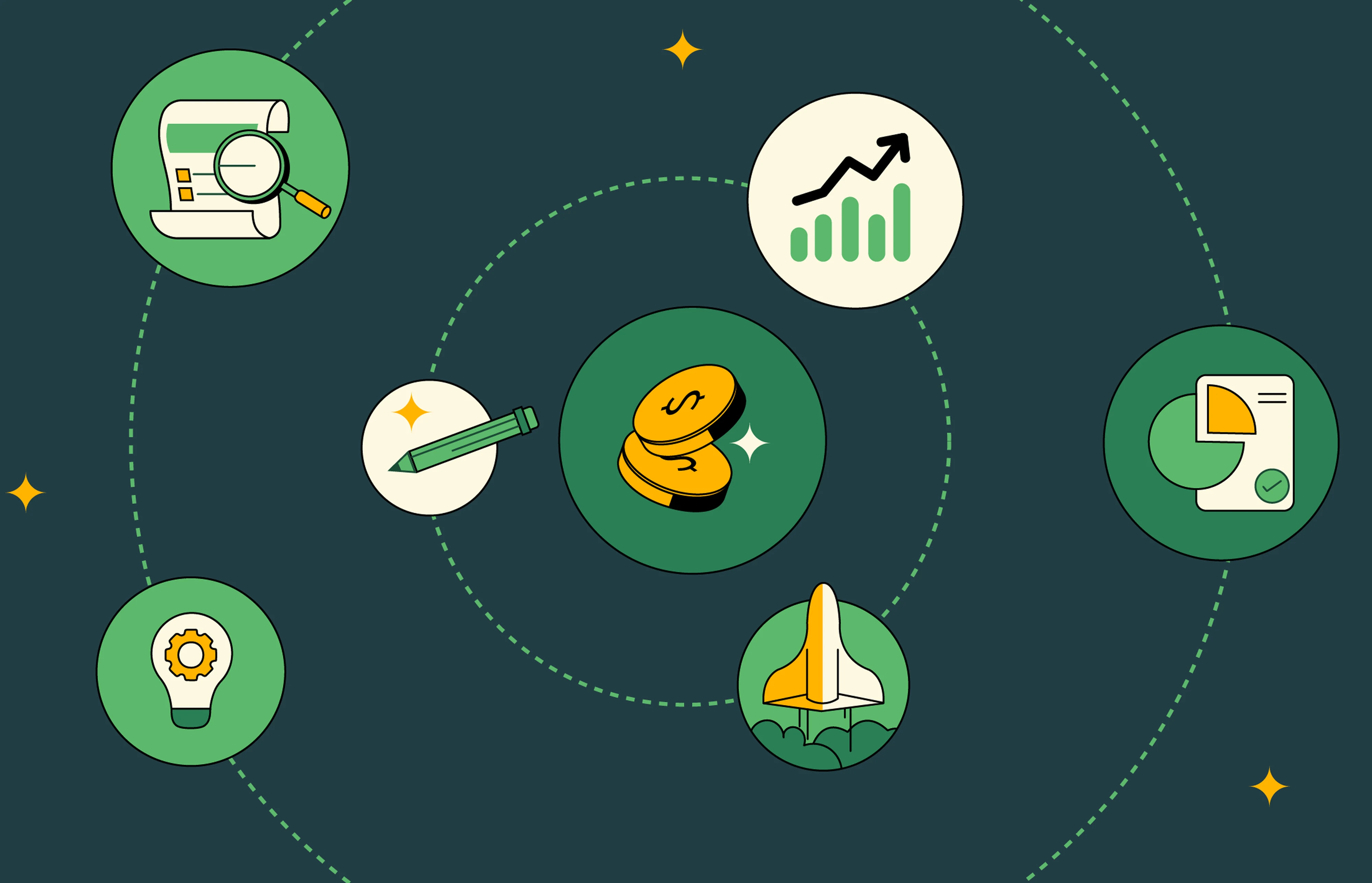
Best Conversion Rate Optimization Companies in US in 2025
If you’re searching for the best conversion rate optimization companies to transform your website performance in 2025, you’re in the right place.
The companies featured here represent the vanguard of US-based CRO expertise for 2025, offering everything from website transformation and predictive testing to AI-powered automation and guaranteed results.
This comprehensive guide reviews each conversion rate optimization company, highlighting who they serve best and what sets them apart in a crowded market.
For hands-on optimization, also check out our article on the best CRO tools.
How we chose the best conversion rate optimization agencies
- Industry reputation: Peer and client reviews, analyst insight, and awards.
- Performance data: Documented conversion lifts, ROI, and client outcomes.
- Breadth of services: End-to-end CRO capabilities, including A/B testing, UX, strategy, and technical expertise.
What does a CRO company do?
A conversion rate optimization (CRO) company specializes in improving the percentage of website visitors who complete desired actions - whether that's making a purchase, signing up for a trial, filling out a form, or any other business goal.
Core services CRO companies provide
1. Data analysis and research
Conversion rate optimization agencies start by diving deep into your website analytics, user behavior data, heatmaps, and session recordings to identify where visitors are dropping off and why.
They also conduct user surveys, interviews, and competitive analysis to understand the barriers preventing conversions.
2. Hypothesis development
Based on their research, CRO experts develop data-driven hypotheses about what changes could improve performance.
Rather than making random changes, they create strategic theories about user psychology, design elements, and messaging that could drive better results.
3. A/B testing and experimentation
CRO work also involves running controlled experiments to compare different versions of copy, web pages, forms, checkout processes, or other conversion elements. This scientific approach ensures changes actually improve performance rather than hurt it.
4. Design and development
Many CRO companies handle the technical implementation of tests, including creating new page designs, writing conversion-focused copy, and coding the variations. Full-service agencies manage everything from concept to launch.
5. Performance monitoring and optimization
CRO is an ongoing process, not a one-time fix. These companies continuously monitor test results, implement winning variations, and identify new optimization opportunities as your business evolves.
What each conversion rate optimization company is best for: At a glance
| CRO Company | Target Size | Best for |
|---|---|---|
| ThunderClap | Mid-market to Enterprise | Website transformation and brand evolution |
| Invesp | SMB to Enterprise | Scientific A/B testing and analytics |
| ConversionFlow | $1M+ Revenue | Guaranteed eCommerce conversion improvements |
| NoGood | Startup to Enterprise | Full-funnel growth marketing campaigns |
| Thrive Internet Marketing | SMB to Enterprise | Integrated digital marketing with CRO |
| OuterBox | Large eCommerce | eCommerce SEO and performance marketing |
| GoMage | Mid to Enterprise | Platform migrations and comprehensive growth |
| Fibr AI | Startup to Enterprise | AI-automated testing and personalization |
| Spiralyze | B2B SaaS | Predictive CRO with guaranteed results |
Top conversion rate optimization companies in 2025: In-depth review
1. ThunderClap

Best For:
B2B SaaS, Fintech, and VC-backed brands seeking an experienced partner for website transformation, measurable conversion gains, and ROI transparency.
Why They Stand Out:
ThunderClap is a B2B website revamp agency that partners with leading B2B companies to deliver websites that drive measurable results.
Combining industry expertise, audacious creativity, and process-driven execution, we go beyond aesthetics to create websites that align with your business goals and scale your growth.
Service highlights:
1. End-to-end website transformation:
Complete B2B website revamps that drive measurable business impact. From comprehensive audits and data-driven website strategy development to stakeholder-aligned solutions, we deliver scalable websites that grow with your business and impress decision-makers at every level.
2. Conversion-focused copywriting + UX strategy:
Strategic messaging and user experience design that converts visitors into customers. Our B2B industry expertise spans SaaS, FinTech, Recruitment, and VC-backed companies, ensuring clear value propositions and optimized customer journeys that drive lead generation and stakeholder buy-in.
3. Premium visual design + brand evolution:
Executive-level visual standards that build trust and authority. We create stunning, responsive designs with strategic visual hierarchy that positions you as an industry leader while driving conversions through optimized layouts and compelling brand storytelling.
4. High-performance Webflow development:
Lightning-fast, enterprise-grade websites built for growth. Our Webflow expertise delivers optimized performance, seamless marketing stack integrations (HubSpot, Marketo), mobile-first development, and SEO-optimized architecture for maximum visibility.
5. Seamless WordPress to Webflow migration:
Stress-free platform transitions that protect your SEO rankings and enhance performance. We handle complete content preservation, zero-downtime migration, and provide 30-day post-launch support to ensure smooth operations and immediate improvements.
Related read: 5 Common Challenges During WordPress to WebFlow Migration
6. Ongoing optimization + partnership support:
Continuous website optimization to maximize ROI through performance monitoring, conversion rate optimization, and strategic maintenance. Our partnership approach includes regular audits, content strategy guidance, and proactive technical updates to sustain growth.
Notable client projects
Storylane: ThunderClap helped Storylane revamp its visual identity to truly reflect its brand maturity and attract more enterprise customers. After the revamp, the brand witnessed a 36% increase in website impressions and a 30% boost in demo requests.
Deductive.ai: ThunderClap collaborated with Deductive.ai, a stealth mode startup founded by two ex-MAANG members, to build a cohesive brand identity. Post revamp, the website received many industry recognitions, and the engagement increased by 10x.
Z47: Z47 joined hands with ThunderClap after their rebrand from Matrix Partners to fine-tune their positioning to match an Indian audience. The brand saw a 50% increase in website engagement and a 54% increase in active users after the revamp.
What customers say
“ThunderClap dove deep into the research for our product, from strategy to design and development, all with a sharp focus on CRO. We couldn't have asked for better partners.” — (Website)
{{ctaBlock}}
2. Invesp
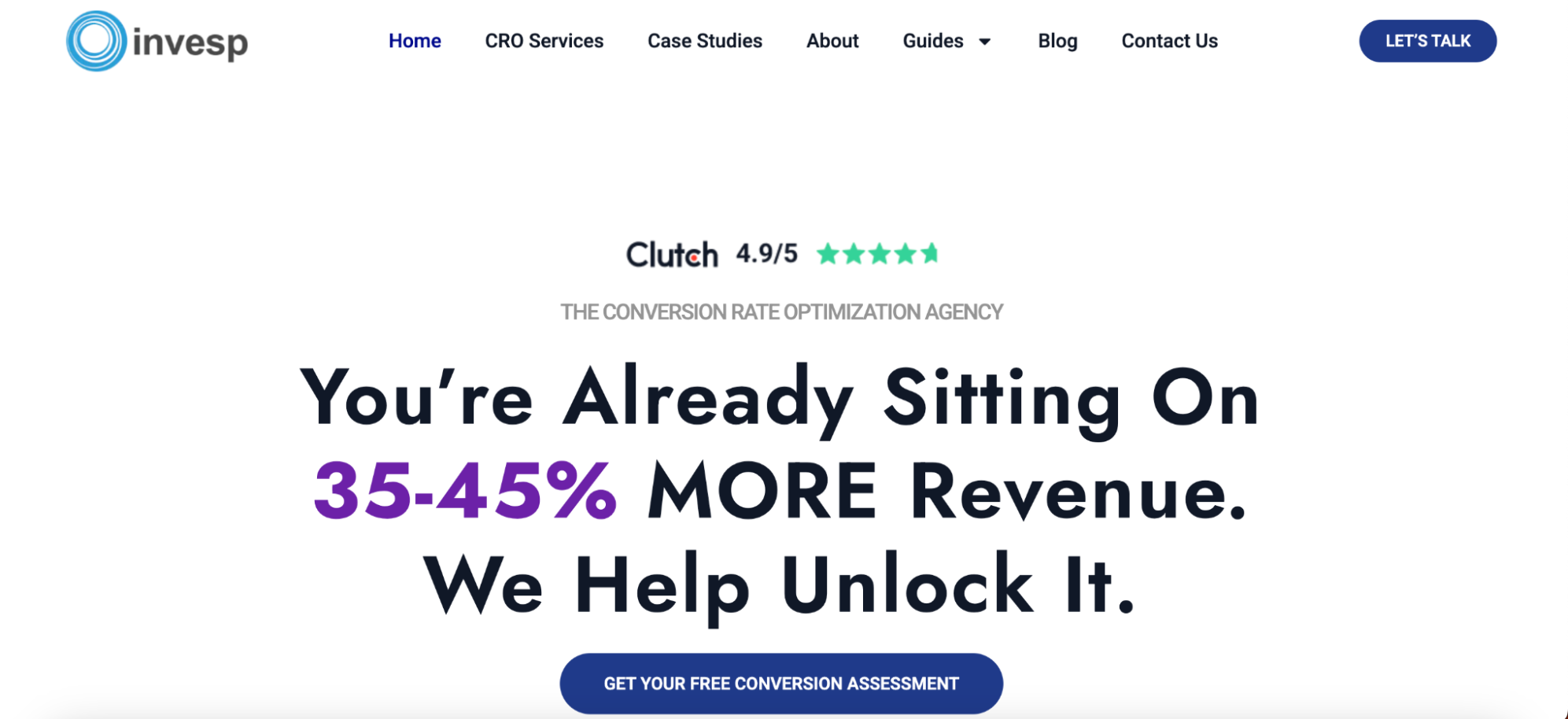
Best for
Brands (from SMB to global enterprise) that want a process-proven, data-centric approach to optimization and trust a team with more than two decades of CRO specialization.
Why they stand out
Invesp pioneered CRO agency work, specializing in scientific A/B testing and process rigor. Having launched over 36,000 tests for major brands like Nestlé, Norton, and Expedia, they are widely regarded for deep analytics, disciplined hypothesis-driven methodology, and transparent results.
Service highlights
- Comprehensive A/B, split, and multivariate testing strategies
- Use of advanced CRO platforms like Google Optimize and Optimizely
- Deep behavioral analytics including heatmaps and session recordings
- Full-funnel optimization with a focus on lead generation
- Training and enablement workshops for client teams
What customers say
“Invesp excels in delivering the goals we set and in their project management, being detailed to document work. I'm also impressed with Invesp's speed because sometimes we have emergencies and require a teammate to take on work immediately, and Invesp responds as soon as we bring up the request.” — Clutch review
3. ConversionFlow
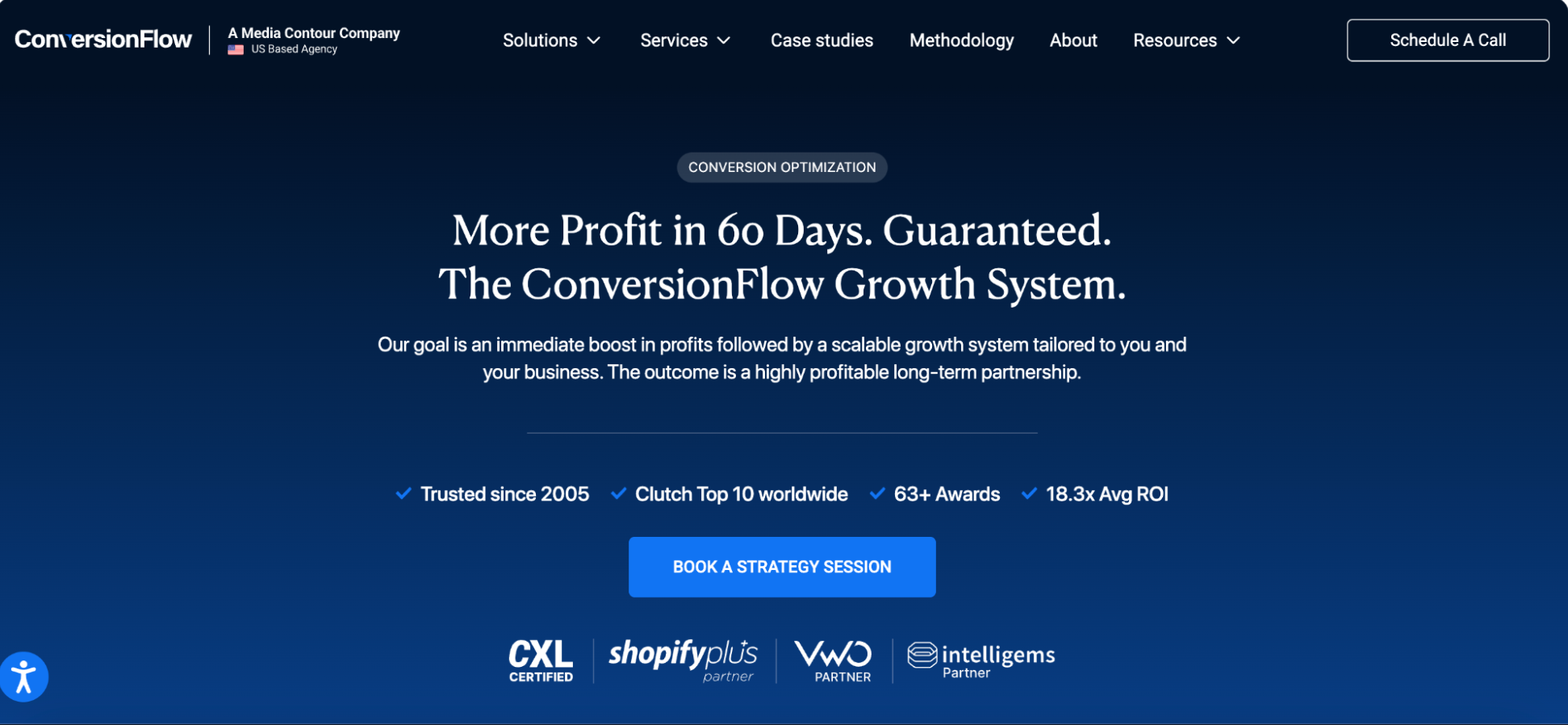
Best for
High-growth eCommerce brands doing $1M+ in revenue and 30K+ monthly sessions.
Why they stand out
ConversionFlow specializes in helping eCommerce brands "turn existing traffic into profitable revenue" through a structured approach that focuses on margin-aware wins rather than just conversion lifts.
Service highlights
- 90-day structured transformation process from profit-centric audits to scalable growth systems
- Advanced conversion optimization, behavioral research, and UX design focusing on revenue per session and reducing acquisition costs
- Guaranteed minimum 10% conversion rate lift with full money-back guarantee for qualifying brands
- Focus on "margin-aware wins i.e. increasing revenue per session, reducing acquisition costs, and optimizing product mix"
What customers say
“Completely hands off, they asked for something, we would get it to them, and then they would run with it. The learning in regards to our customers was priceless.” — Clutch review
4. NoGood
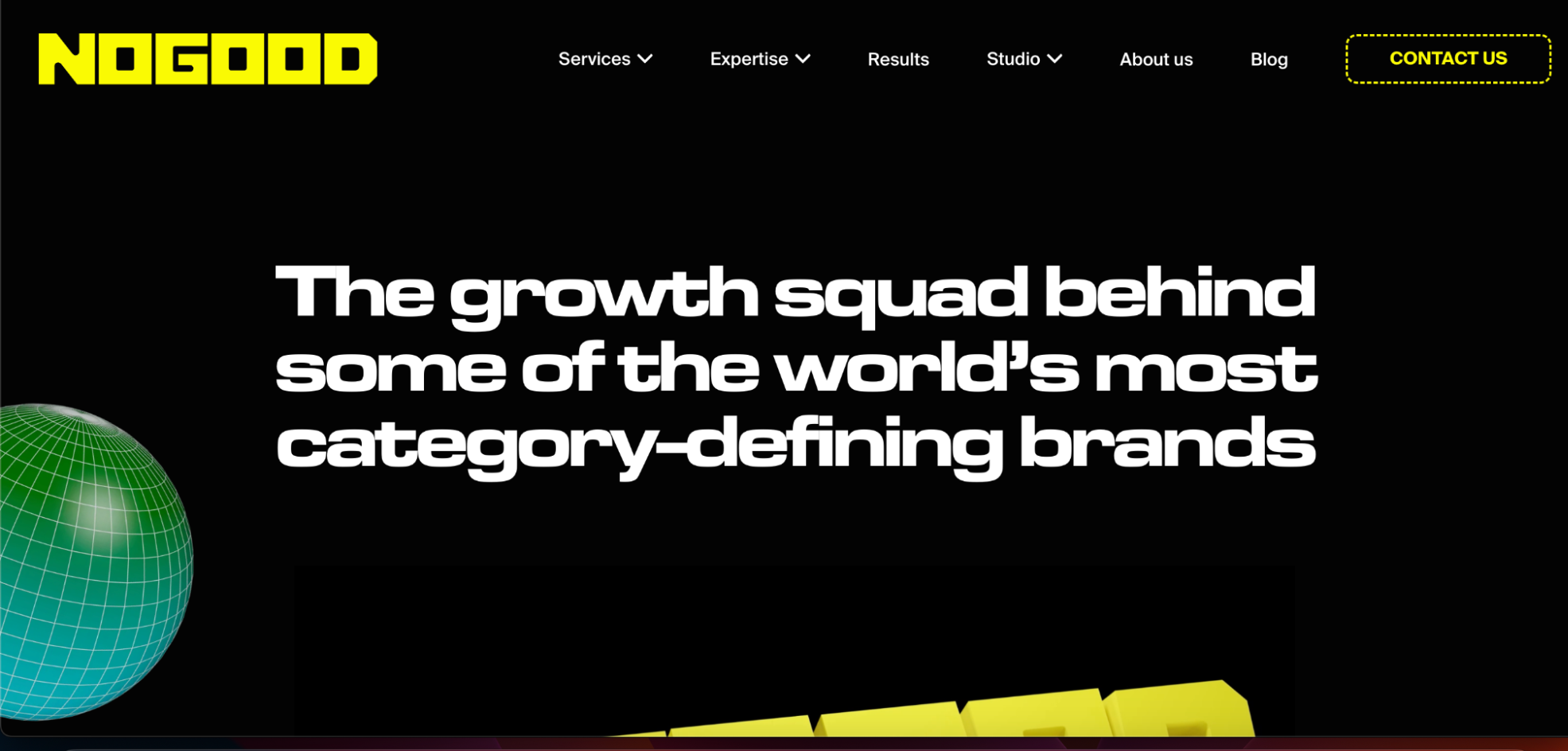
Best for
Fast-growing startups, scaleups, and established brands in SaaS, healthcare, fintech, B2B, consumer, and AI sectors seeking comprehensive growth marketing beyond traditional agency approaches.
Why they stand out
NoGood combines agile marketing operations with full-funnel CRO: from top-of-funnel traffic acquisition to paid media and post-signup onboarding. Its sweet spot is B2B/SaaS, where agility, rapid experimentation, and analytics are non-negotiable.
Service highlights
- Full-funnel growth marketing spanning social ads, paid search, SEO, content marketing, and performance branding
- Proprietary analytics and AI technology integrated into all growth strategies
- Purpose-built growth squads tailored to specific client challenges rather than standardized packages
- Team of growth leads, creatives, engineers, and data scientists who help unlock rapid growth
- Cross-industry expertise with specialized knowledge in multiple verticals
What customers say
“Their growth marketing initiatives around paid media, specifically understanding new platforms and knowing the latest trends to capitalize on, have been really impressive. Their team is full of experts, and they are consistently learning. NoGood also works very quickly.” — Clutch review
Also read: 20 Proven SaaS Conversion Optimization Hacks to Boost Your Sales
5. Thrive Internet Marketing Agency

Best for
Companies seeking an all-in-one digital marketing partner that integrates CRO with SEO, PPC, and reputation management to drive sustained growth.
Why they stand out
Thrive has 20 years of digital marketing expertise and has generated 2.4M conversions for SEO clients and over $14.6 million in revenue for eCommerce businesses.
Service highlights
- Holistic audits encompassing CRO, SEO, and technical site performance
- A/B testing coupled with content and UX optimization
- Multi-channel campaign integration aligning PPC, SEO, and social media efforts
- Dedicated project teams with proactive communication
- Additional services including local SEO, email marketing, and web hosting
What customers say
“Thrive has delivered some excellent results, and our site traffic has undoubtedly increased. Since working with them, we’ve seen a 40%–50% uptick in leads, and our leads have been 70%–75% more relevant.” — Clutch review
6. OuterBox
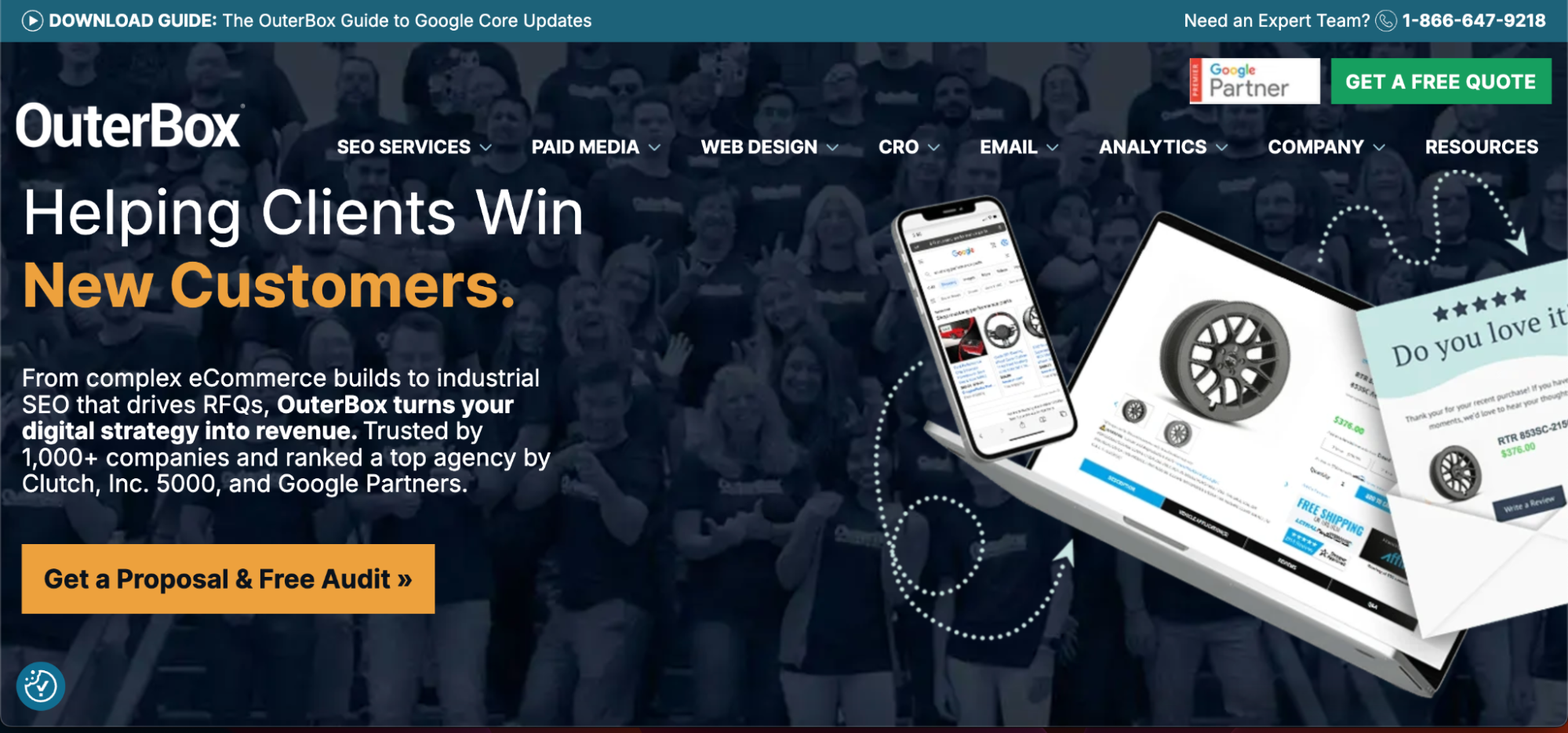
Best for
Large eCommerce retailers and established online businesses seeking comprehensive SEO services and performance marketing, particularly those with substantial budgets for long-term optimization campaigns.
Why they stand out
OuterBox blends CRO with SEO and UX design, delivering technical precision and high conversion rates for complex, high-traffic websites. Their 20+ years in e-commerce and B2B make them a trusted choice for sustained growth.
Service highlights
- Specialized eCommerce SEO services with proven ranking results
- AI SEO Services and Generative Engine Optimization (GEO) for next-generation search
- Google Ads management and PPC services integrated with SEO strategy
- Email marketing services and conversion rate optimization for eCommerce
- Custom eCommerce website design and development for large retailers
- Project investments typically ranging from $30,000 to $340,000 depending on scope (Based on Clutch reviews)
What customers say
“OuterBox has been managing our PPC strategy for 20+ years. They consistently deliver 2 or 3X the money invested into the program.” — Clutch review
{{specficBlog}}
7. GoMage
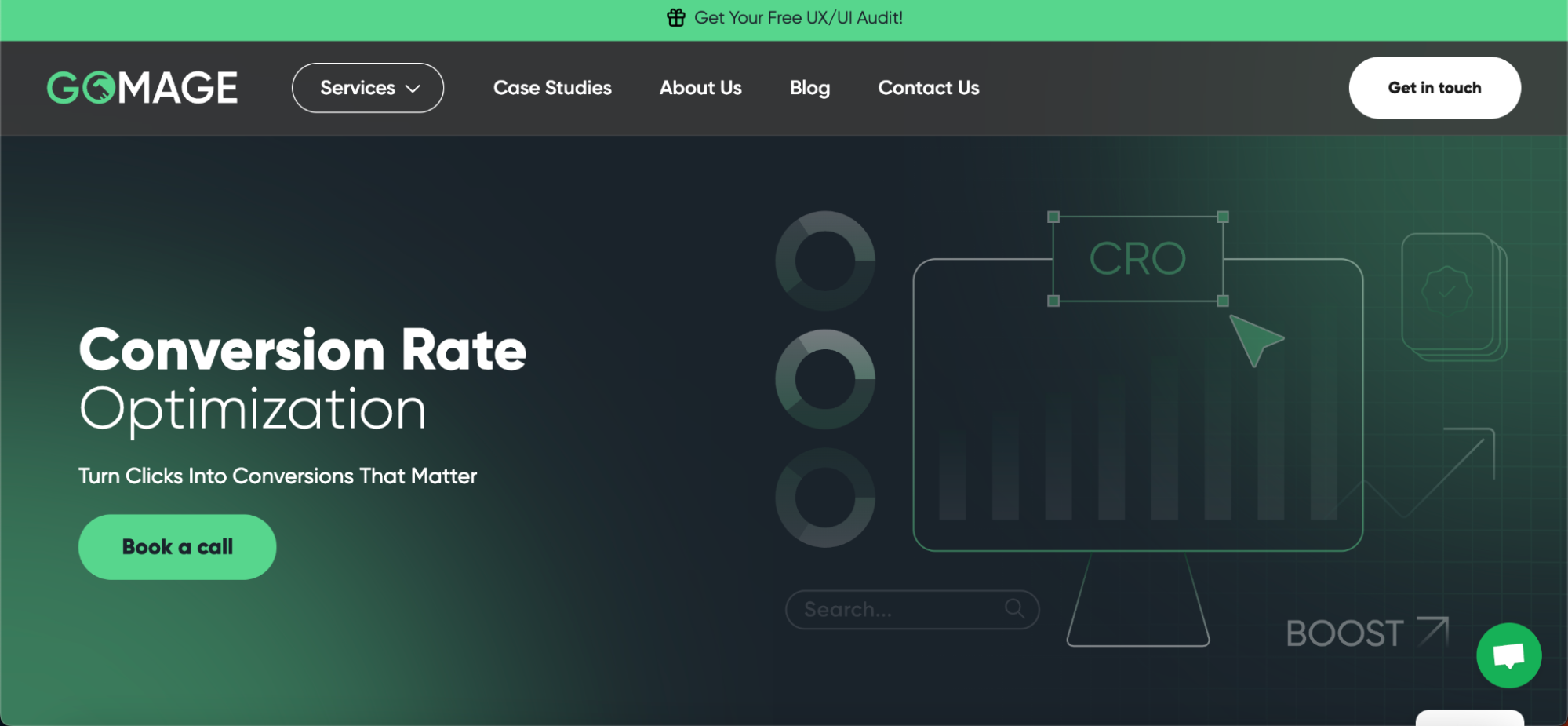
Best for
E-commerce brands, especially in Magento and Shopify ecosystems, aiming for significant revenue growth through advanced CRO.
Why they stand out
GoMage specializes in delivering measurable revenue uplifts through a systematic, technical approach to funnel optimization. Their strong focus on checkout optimization and product discovery enhances both user experience and conversions.
Service highlights
- Comprehensive funnel analytics and KPI tracking integrated with e-commerce platforms
- High-velocity A/B and multivariate testing for rapid insights
- Checkout flow improvements and product recommendation optimization
- Technical QA ensuring test accuracy and seamless implementation
- Data-driven UX and interface enhancements focused on increasing average order value
What customers say
“They’ve been amazing for us. GoMage's dedication and technical knowledge have been great. It’s been a good experience.” — Clutch review
8. Fibr AI
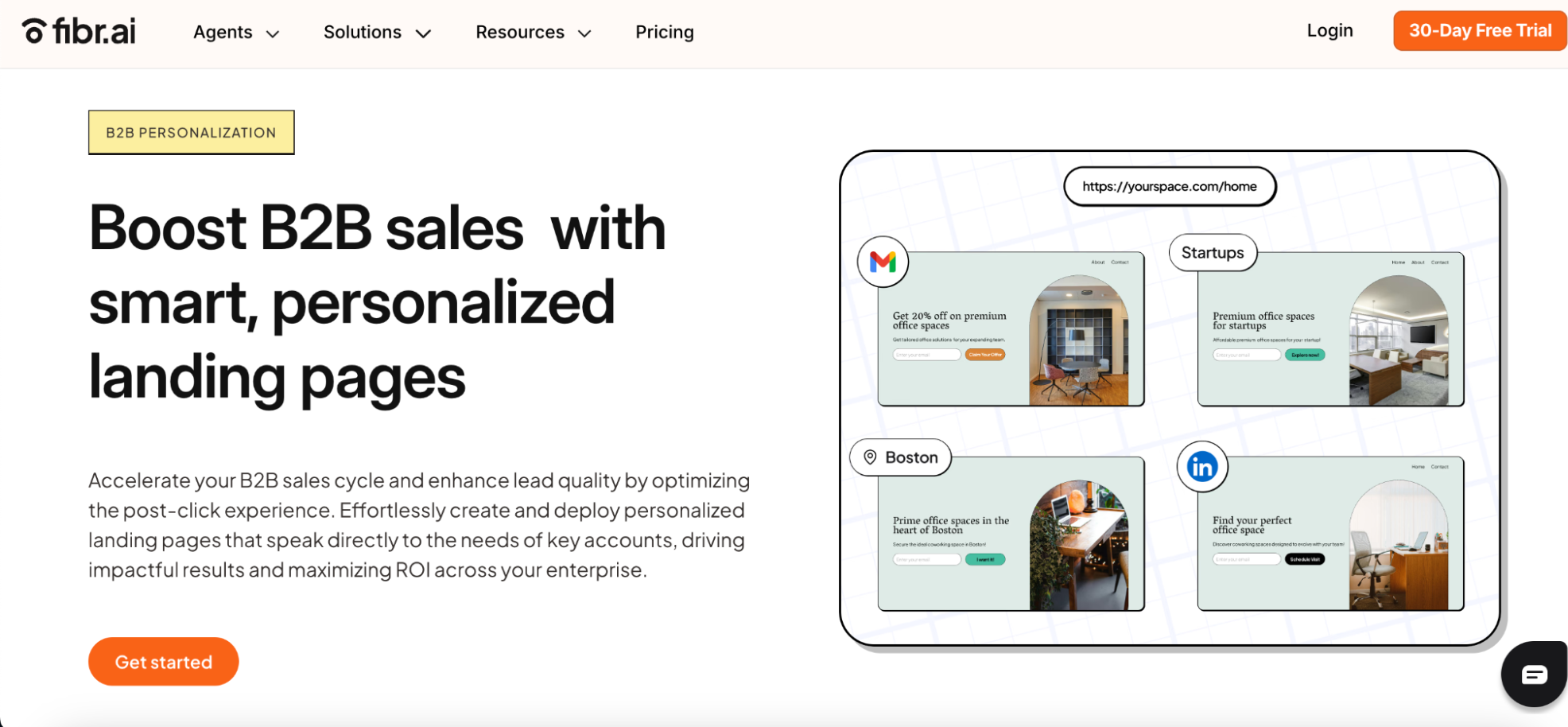
Best for
SaaS and digital-first companies seeking scalable, AI-automated conversion rate optimization with minimal manual effort.
Why they stand out
Fibr AI leverages autonomous AI agents to continuously experiment, personalize, and optimize websites without requiring intense human intervention. They provide three specialized AI agents: LIV (Personalization), MAX (Experimentation), and AYA (Web Performance) that work together to create self-optimizing websites.
Service highlights
- AI-driven autonomous A/B testing and personalization
- Real-time web health monitoring and issue detection
- Continuous multivariate experiments with data-driven landing page adjustments
- Deep integrations with CRM and marketing platforms for seamless data flow
- Low resource overhead allowing for rapid test deployment and iteration
What customers say
“Fibr AI’s real-time personalization engine has been a game changer for us. We used it to personalize landing pages based on traffic source and visitor behavior, and we saw a noticeable bump in conversion rates—almost 18% lift on one of our main funnels.” — G2 review
9. Spiralyze

Best for
B2B SaaS companies seeking evidence-based conversion optimization with guaranteed results through predictive CRO technology and full-service implementation.
Why they stand out
Spiralyze is another B2B CRO agency that uses a proprietary system to analyze successful A/B test results from over 78,000 websites to identify proven conversion tactics.
Their machine learning technology then predicts which of these winning strategies will work best for your specific site, allowing them to achieve significantly higher success rates than traditional testing approaches.
Service highlights
- Full-service team of 170 specialists handling all aspects from design and copywriting to development and analytics
- Performance-based pricing model with guaranteed 30% conversion improvement within 90 days
- Fast implementation with first tests launched within 2 weeks
- Industry-specific expertise across 17+ verticals including FinTech, DevOps, and MarTech
What customers say
“I have worked with Spiralyze now for about 5 years as a client with 2 different brands and they are top notch. They are thought leaders in the CRO space with an extremely dedicated client success team.” — Google Business review
Ready to transform your website performance?
Choosing the right CRO partner can be the difference between a website that simply looks good and one that drives measurable business growth. Each of the agencies in this guide brings unique strengths - from website transformation to predictive testing methodologies to performance guarantees.
The key is finding an agency that aligns with your specific needs, industry, and growth stage. Consider factors like their track record in your sector, their approach to testing and optimization, pricing models, and the level of support they provide throughout the process.
Ready to see what's possible for your website? If you're a B2B SaaS, FinTech, or VC-backed company looking for a strategic partner to transform your website performance, ThunderClap specializes in delivering measurable conversion gains with full transparency on ROI. Book a demo to discover how website transformation can accelerate your business growth.
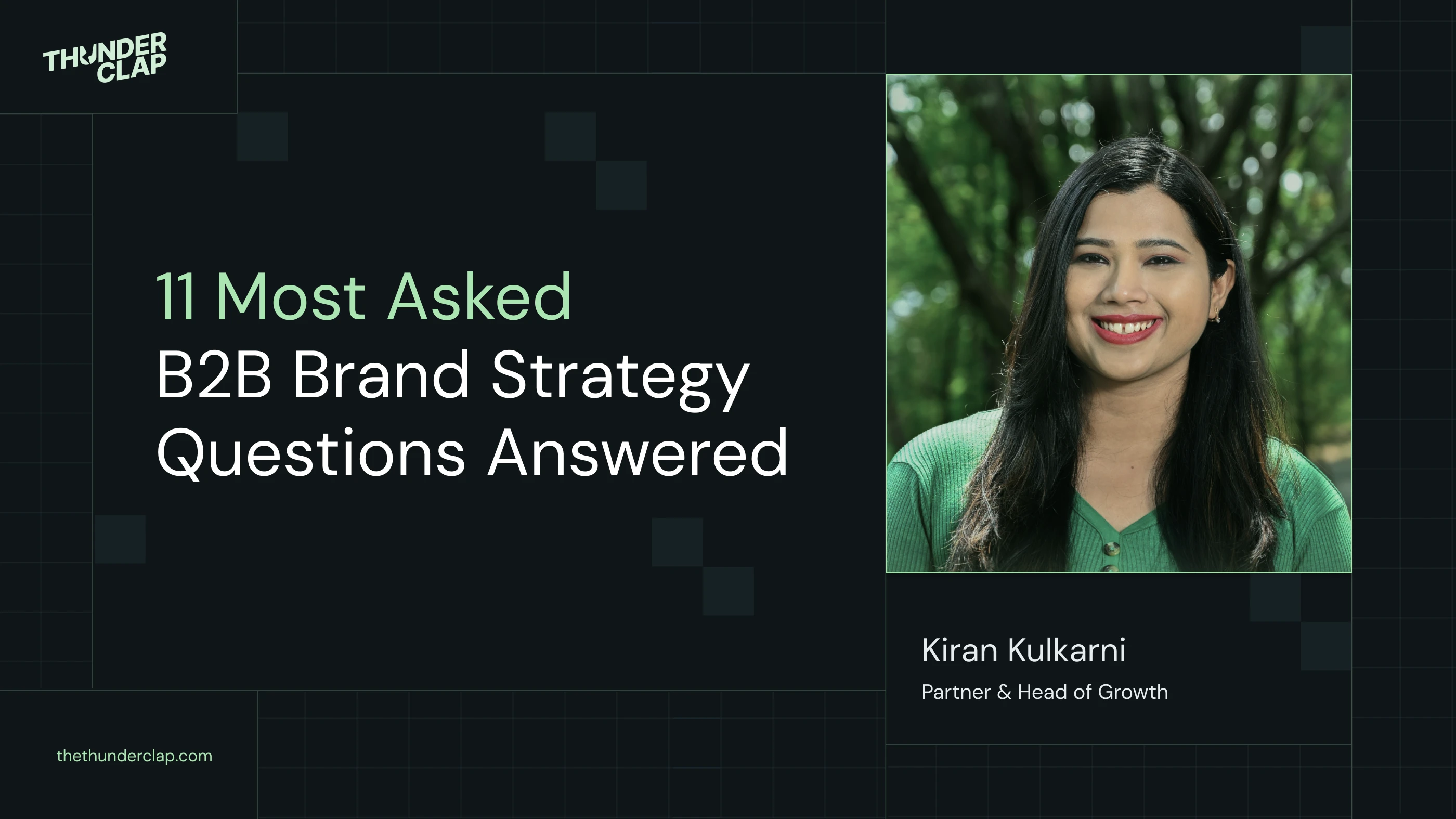
11 Most Asked B2B Brand Strategy Questions Answered
An exclusive conversation with Kiran Kulkarni, Partner & Head of Growth at ThunderClap, on building brand strategies that drive real business results.
Thunderclap is an award-winning B2B website revamp agency has helped over 129 B2B companies—from fast-growing startups to enterprises like Amazon, Razorpay, and Storylane build websites that drive measurable results.
We sat down with Kiran to discuss what it really takes to build a B2B brand strategy that creates a sustainable competitive advantage and why most companies might be approaching it wrong.
Let’s get started!
1. Many B2B leaders still see branding as a 'nice-to-have' rather than a business necessity. What's your take?
Kiran - “This mindset is exactly why so many B2B companies get trapped in endless pricing wars. When you compete solely on features and price, you're essentially commoditizing yourself. And commodities always get squeezed on margins.
The companies that break free from this cycle understand that brand isn't about having a prettier website, though that helps. It's about owning a distinct position in your prospects' minds that makes you the obvious choice when they have a problem you solve.
I've watched this transformation happen firsthand. Take our client ConsultAdd we helped them boost website enquiries by 60% not just through design, but by clarifying their brand positioning and making their value proposition crystal clear. When prospects understand exactly why you're different and better, price becomes much less of an issue.”
2. "What is a B2B brand strategy, and how does it differ from tactics like content marketing or demand generation?"
Kiran - “I see this confusion all the time. A B2B brand strategy is your master plan for how you want to be perceived, remembered, and chosen in the marketplace. It's the strategic foundation that everything else builds on top of.
Think of it this way: Content marketing is what you say. Demand generation is how you reach people. Your website is where they experience you. But brand strategy? That's who you are in the market's mind and why you matter.
Here's what I tell our clients at ThunderClap: Your B2B brand marketing strategy needs this strategic foundation. Without it, your content becomes random noise, your demand generation attracts the wrong people, and your website (no matter how beautiful) won't convert because visitors don't understand your unique value.
We see this when companies come to us wanting "just a website redesign." But if we don't first clarify their positioning and value proposition, we're just putting a fresh coat of paint on a confused foundation. That's why our process always starts with brand or website strategy before we touch any design work.
Take ClearlyRated, for example. They came to us for what they thought was a simple website refresh. But during our brand audit, we discovered some interesting opportunities.
They had multiple CTAs that were creating decision paralysis for visitors, and their value proposition around making feedback actionable wasn't coming through clearly enough.
Once we clarified their brand positioning around being the trusted voice for employee feedback and consolidated their multiple CTAs, everything clicked.”
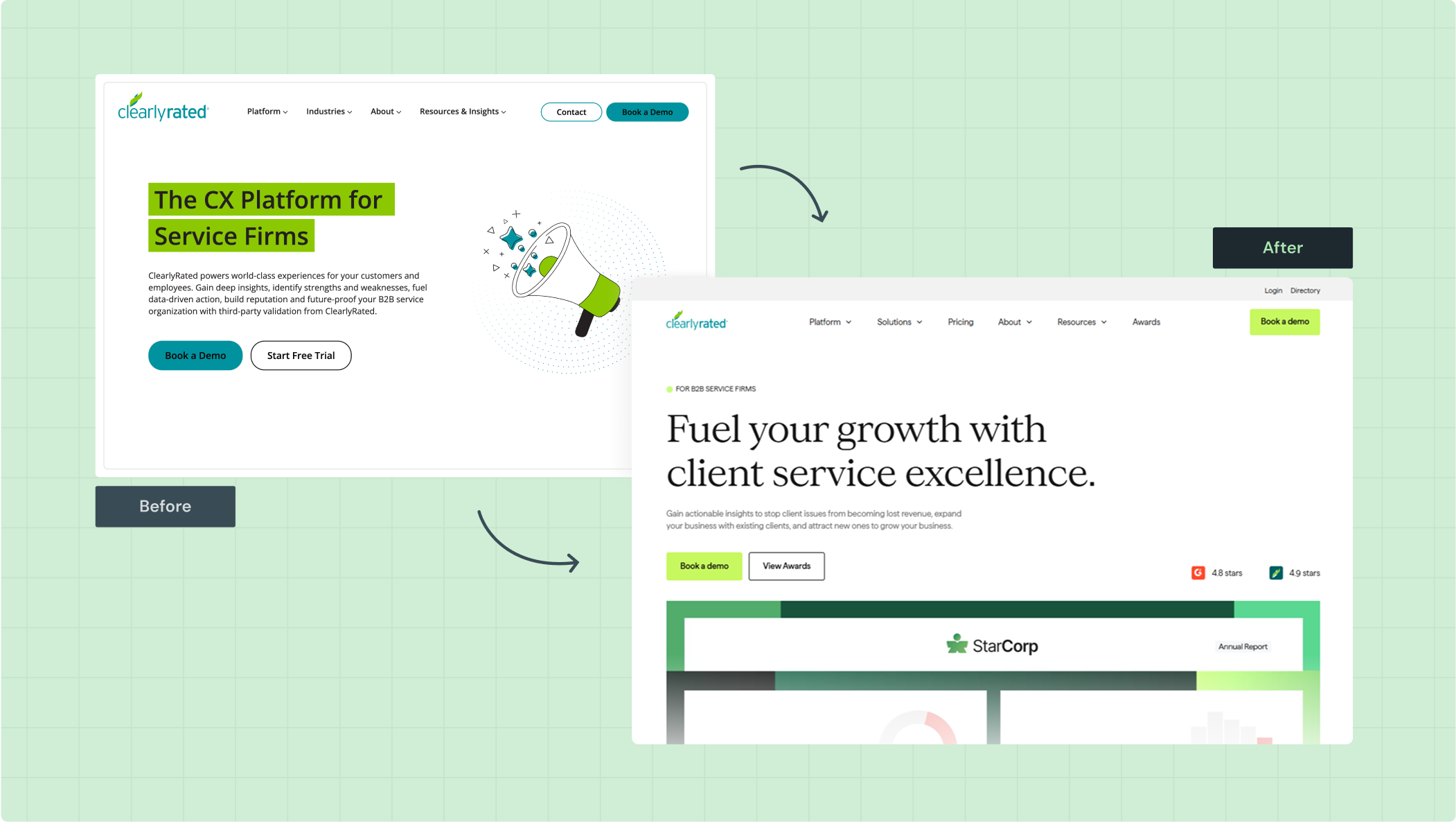
Also read: 5 B2B Branding Strategies with Examples from Top Brands
3. "How do you differentiate your brand when everyone claims to be 'innovative' or 'industry-leading'?"
Kiran - “You're absolutely right, generic positioning is everywhere. ‘Best-in-class,’ ‘cutting-edge,’ ‘revolutionary’ - these words have lost all meaning because everyone uses them.
The key is finding your ‘unique POV.’
Most B2B companies define their competition too narrowly. They look at direct competitors and try to be incrementally better. But the real competition isn't just other software companies, it's the status quo.
When we work with clients at ThunderClap, we help them identify the bigger transformation they're enabling. Take Storylane, for example. Their journey with us started with their website 'not having a personality' in the words of Madhav, their Head of Marketing. Now, the brand book we've built for them serves as a foundation for everything memorable they're trying to do.
Even though they're newer to the game compared to established players like Navattic and Walnut in terms of revenue, they've been able to create a highly differentiated brand through unconventional initiatives like Demo Dundies, Demo-led SEO, and other creative campaigns that make them stand out in the interactive demo space.
The breakthrough comes when you stop trying to be incrementally better and start reframing the problem entirely.
4. "How do you get leadership buy-in for bold positioning that challenges industry norms?"
Kiran - “You speak their language: revenue impact and competitive advantage. Every marketing leader we’ve worked with cares about shorter sales cycles, higher win rates, and the ability to command premium pricing. Those are exactly the business outcomes that strong brand positioning delivers.
But here's what I tell leadership teams: Brand building is like compound interest. You can't expect immediate results on a performance marketing timeline.
If you're measuring brand ROI in quarters, you're going to be disappointed and likely kill good initiatives too early.
What we do at ThunderClap is run dual tracks.
We keep short-term demand generation and conversion optimization running to hit immediate goals while building the long-term brand foundation. We track leading indicators like brand awareness, and consideration metrics alongside conversion numbers.”
5. “Let's get tactical. What does the actual process of building a B2B brand strategy look like?”
Kiran - “At ThunderClap, we use a five-layer approach that we've refined over hundreds of web redesign and rebrand projects.
Layer 1: Market Reality Audit
This is brutally honest market analysis. Who are you really competing against? What do prospects actually think about when they have the problem you solve? What's the cost of inaction? What are the switching barriers?
Most companies skip this step and base their strategy on internal assumptions. That's why their positioning misses the mark completely.
Layer 2: Strategic Positioning
This is where you define your unique angle. What transformation are you enabling? What's your "enemy"? What future are you trying to create?
Take Deductive, for example. They started with generic positioning around turning telemetry data into a 'Thinking Machine' and having 'the most brilliant engineer at your fingertips.'
We made it more outcome-focused and super relevant to developers now they own 'No More Root Causing in the Dark' and position themselves as the solution that 'pinpoints root causes with the precision of an experienced engineer
Layer 3: Message Architecture
Once you know your position, you translate it into clear, compelling messaging. This includes your core value proposition, supporting pillars, proof points, and objection handling framework.
Layer 4: Brand Personality & Voice
How do you want to sound? What personality traits should you embody? This should align with your audience's preferences and reinforce your strategic position.
Layer 5: Digital Activation System
This is where strategy meets execution. Your website becomes the primary vehicle for expressing your brand strategy. Every page, every interaction, every conversion point should reinforce your positioning.
This last layer is crucial, and it's where most agencies stop at just ‘making things look pretty.’ We optimize for both brand expression and conversion performance.”
As Ankita Chaturvedi, GTM Expert at Shopline, put it: "ThunderClap dove deep into the research for our product, from strategy to design and development, all with a sharp focus on CRO. We couldn't have asked for better partners."
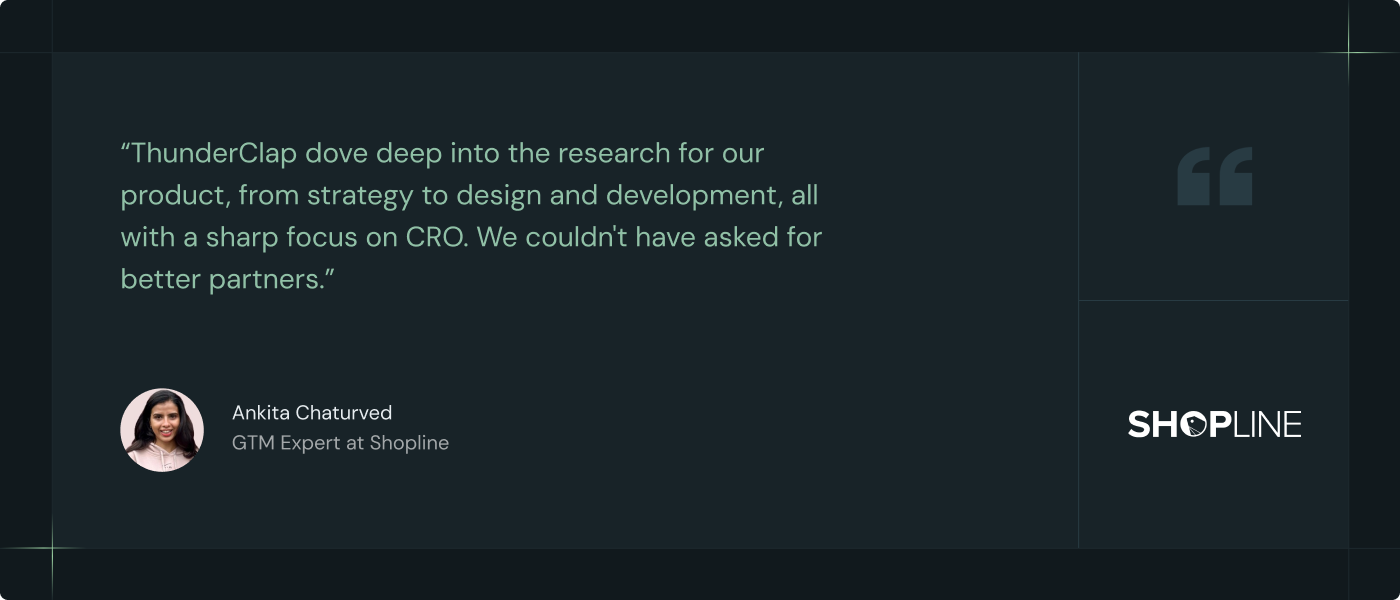
6. “Speaking of measurement, how do you track the ROI of brand investments?”
Kiran - “This is where most B2B marketers get stuck. They try to measure brand impact the same way they measure performance campaigns, and it doesn't work.
At ThunderClap, we track what we call the "Brand Performance Triangle":
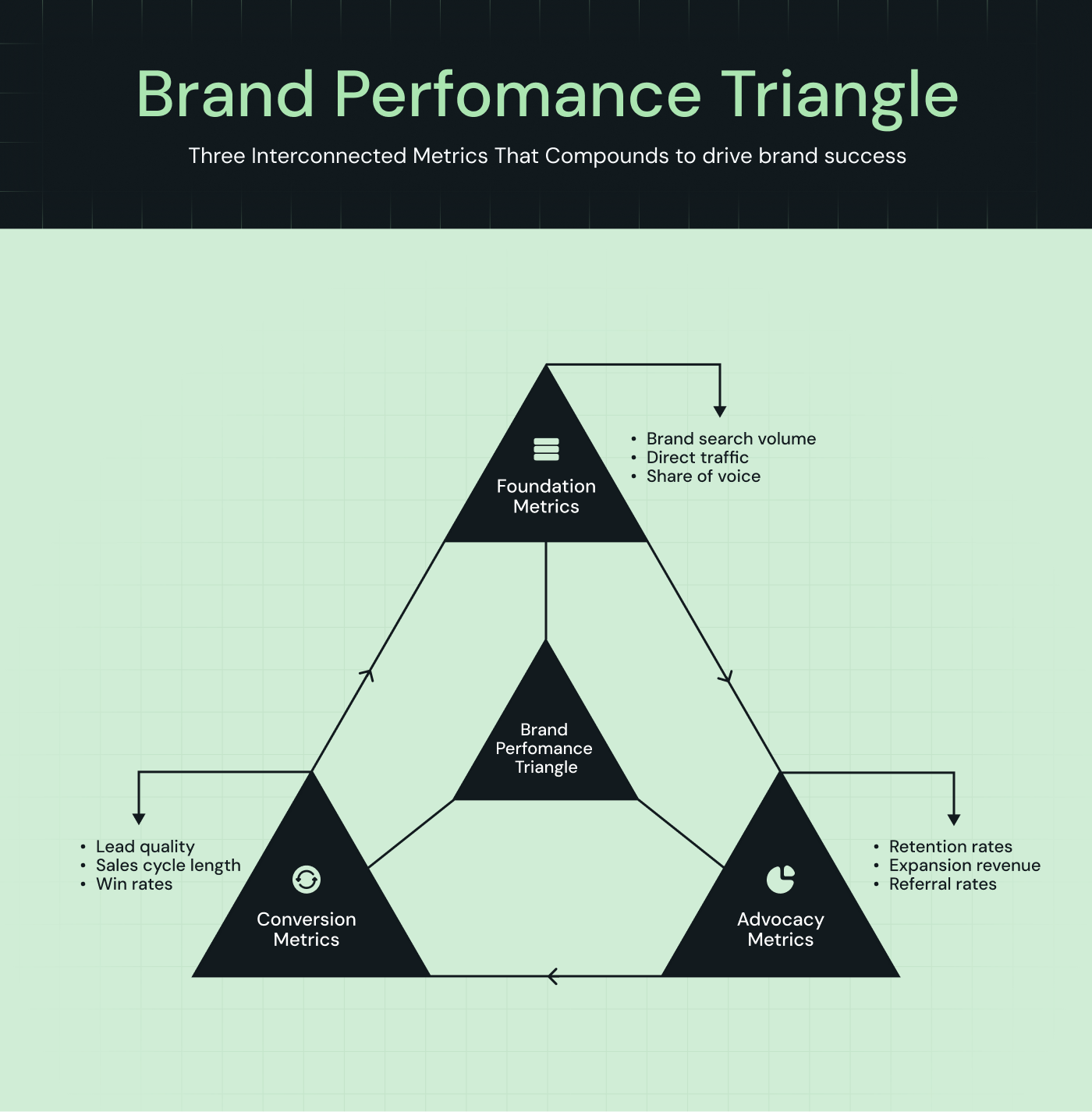
- Foundation Metrics: Brand search volume, direct website traffic, social media mentions, share of voice in industry conversations. These are core components of any effective B2B brand awareness strategy, indicating whether your positioning is breaking through.
- Conversion Metrics: Inbound lead quality, sales cycle length, win rates, average deal size, customer acquisition cost. These show if your brand is actually driving business results.
- Advocacy Metrics: Customer retention rates, expansion revenue, referral rates, employee advocacy on social media. These show if your brand creates lasting value.
The magic happens when these metrics compound. Higher awareness drives better consideration, which drives stronger advocacy, which drives more awareness. It's a flywheel effect.”
7. “What about smaller B2B companies? Can they compete with established brands on limited budgets?”
Kiran - “Absolutely. Smaller companies often have advantages that bigger brands can't match - speed, authenticity, the ability to take bold positions without committee approval, and experimentation without the fear of going wrong. That's one of the advantages we have at ThunderClap.
The mistake smaller companies make is trying to compete on the same playing field as established brands. Don't try to outspend them on advertising or content volume. Instead, outposition them.
Here's what I recommend: Find a specific niche where you can be the definitive expert.
This focused approach is often more effective than broad B2B brand awareness strategies that larger companies use, allowing you to dominate mindshare in your chosen segment.
{{specficBlog}}
8. “Let's talk about common mistakes. What are the biggest branding errors you see B2B companies making?”
Kiran - “The biggest mistake is treating branding as a design project rather than a business strategy. I see companies spending months perfecting their logo while their value proposition remains unclear and their website messaging is confused.
Another major error in any B2B brand marketing strategy is the "appeal to everyone" trap. They're so worried about alienating prospects that they end up with generic messaging that excites no one. Strong brands have clear boundaries. One of my favorite examples of this is
I also see companies changing their brand strategy every six months based on short-term performance. At ThunderClap, we tell clients upfront: brand building requires patience and consistency. You can't expect to see transformational results in the first quarter.
But perhaps the most costly mistake is the "website as brochure" mentality. They treat their website as a digital business card instead of a conversion engine. Your website should be the primary expression of your brand strategy and your hardest-working salesperson.
When we redesign websites for clients, we're not just making them prettier, we're optimizing every element for both brand expression and conversion performance. You can check out some of our latest work.
Finally, there's the "set it and forget it" approach. Your brand strategy needs to evolve as your company grows and the market changes. But evolution doesn't mean reinvention every quarter—it means thoughtful adaptation while maintaining your core identity.”
9. “How do you translate your brand strategy into a cohesive digital experience?”
Kiran - “Our brand strategy should be the foundation that informs every digital touchpoint, but it can't just be theoretical—it needs to drive measurable business outcomes.
At ThunderClap, when we work with clients, we don't just create brand guidelines that sit in a folder. We translate that strategy into a cohesive digital experience where every element works together to guide prospects toward conversion.
Take Rezolv, a fintech platform we worked with, for example. When they approached us, they had a working product but no logo, branding, or website.
While they had deep technical knowledge of payment collection solutions, they needed help explaining their complex product in simple terms to banks and financial institutions.
We developed their complete visual identity from scratch, crafted their website strategy and messaging, then designed and developed their site to translate their technical sophistication into clear, digestible communication.
Every element from the clean typography to the simplified product illustrations reinforced their positioning as the authoritative yet approachable solution for modernizing payment collections. The result was a cohesive brand experience that helped them successfully raise significant funding.
10. “Looking ahead, how do you see B2B branding evolving?”
Kiran - “I think we're entering an era where authenticity and substance matter more than ever. B2B buyers are incredibly sophisticated now. They can spot generic positioning and empty promises from a mile away. The brands that win will be the ones that have something genuinely valuable to say and the courage to say it clearly.
But here's what's equally important - the way something is communicated. B2B has been boring for a very long time.
A strong B2B brand strategy that creates good recall will always give you competitive advantage. This becomes your defensible leverage when everyone else is competing on features and price.
Finally, I think AI and automation will make authentic human connections even more valuable. As more interactions become automated, the human touchpoints become more important.
Brands that can create genuine connections through their positioning, their content, and their customer interactions will stand out more than ever.”
11. “Any final advice for B2B leaders thinking about their brand strategy?”
Kiran - “Start with why you exist beyond making money. If you can't articulate why the world genuinely needs your company, you'll struggle to build a compelling brand. Your purpose has to be bigger than your product.
Be patient but persistent. Brand building is a marathon, not a sprint. But when you get it right, it creates a sustainable competitive advantage that's incredibly hard to replicate.
Don't separate brand strategy from business strategy. Your brand should be an expression of your business strategy, not a marketing afterthought. At ThunderClap, our most successful clients are the ones where the CEO and leadership team are actively involved in the brand strategy process.
And remember: Your brand is what people say about you when you're not in the room. Make sure they're saying something worth repeating.”
{{ctaBlock}}
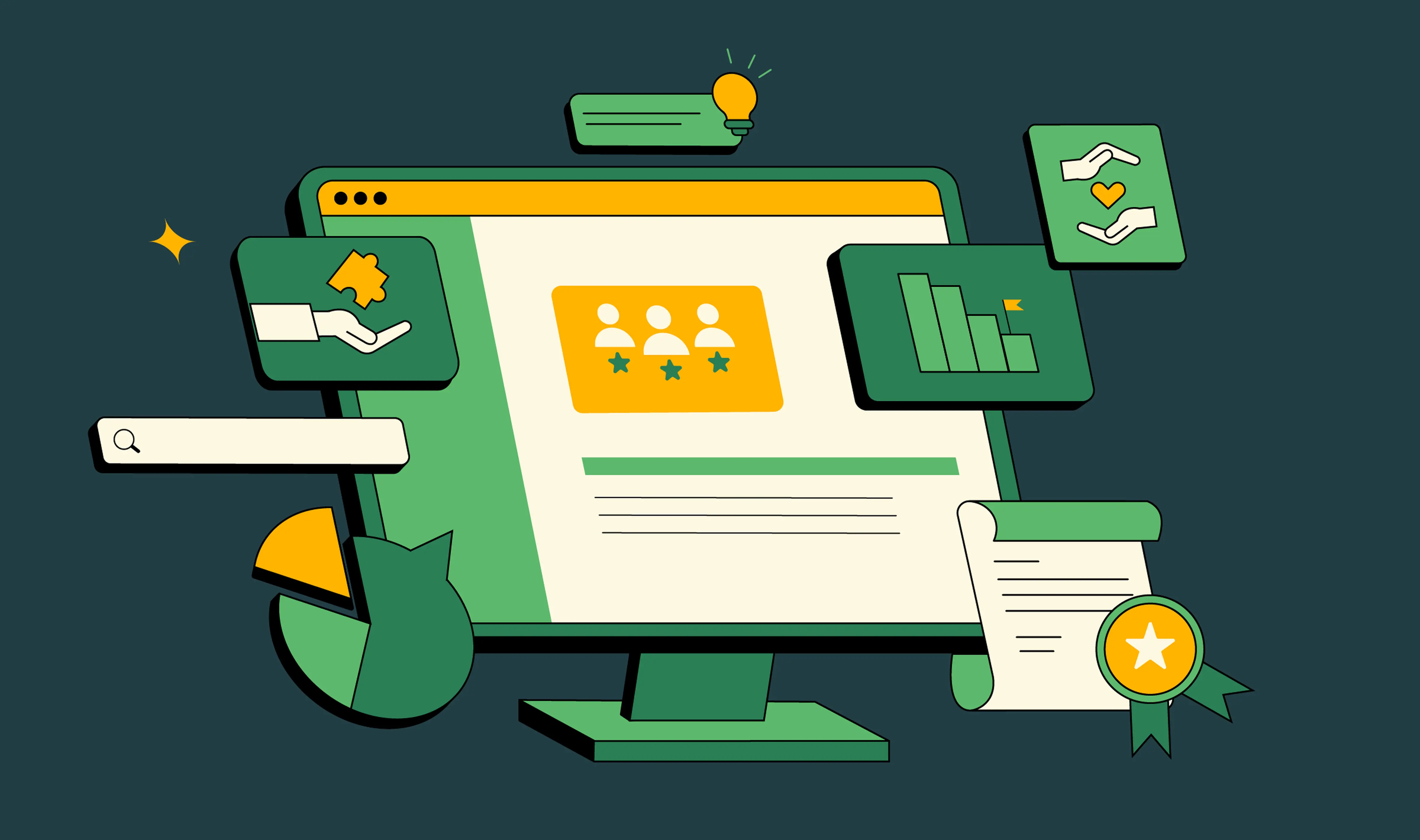
Outsourcing Webflow Maintenance vs. In-House Management: Which is Better?
3 guesses about you, just based on the fact that you landed on this blog:
1. You finally busted the myth that WebFlow websites don't need maintenance.
2. You're on the fence about whether to outsource WebFlow maintenance or manage it in-house.
3. You're looking for a no-BS guide that helps you choose the right model.
If that sounds like you, this blog is for you. Here we discuss whether outsourcing WebFlow maintenance is better than in-house management based on 6 parameters: cost, expertise, scalability, availability, risk monitoring, and time to market.
But first, let's cover the basics:
What is WebFlow maintenance?
WebFlow maintenance is the process of keeping your WebFlow websites updated, secure and primed for peak performance and conversions. During WebFlow website maintenance checks, you run:
- Security Checks: To scan for potential threats and ensure that in-built security features, such as two-factor authentication, SSL encryption, and DDoS protection, are functioning properly.
- Content Audits: To ensure that both static pages (such as About and Pricing) and dynamic ones (like Blogs and Case Studies) always showcase the latest and most relevant content.
- SEO Audits: To catch broken links, missing ALT texts, meta tags, and avoid domain expiry.
- Accessibility Checks: To ensure you comply with the web accessibility guidelines and provide a seamless user experience.
- Backup and Recovery Audits: To confirm WebFlow's built-in backup is reliable and ensures quick recovery after errors or cyber threats.
Does WebFlow even require maintenance?
Contrary to some popular Reddit Threads, WebFlow websites do require maintenance. However, the effort and time one should invest in WebFlow maintenance is minimal compared to other website builders like WordPress.
Qamar Aziz, ThunderClap's Webflow Lead & GSAP Developer, has to say about the need for WebFlow website maintenance:
"A Webflow website is like a living system, without regular maintenance, even the most beautifully designed site can suffer from broken links, outdated content, performance issues, or missed growth opportunities. Ongoing maintenance ensures your website stays fast, secure, and aligned with your business goals."
Outsourcing Webflow Maintenance vs. In-House Management: A Comparison
Now that we've pushed the question of whether you need Webflow maintenance out of the way, let's zero in on how outsourcing stacks up against in-house management across cost, expertise, scalability, availability, speed, and risk monitoring.
1. In-House Vs. Outsourcing WebFlow Maintenance: Which Costs More?
Outsourcing is a cost-effective option compared to in-house WebFlow maintenance. Here's why:
- No additional costs, pay only for the service: When you outsource WebFlow maintenance, you only pay for the service. On the other hand, hiring in-house WebFlow specialists requires you to cover their onboarding and training in addition to their salaries.
- No need to invest in a maintenance tech stack: WebFlow maintenance agencies come with an advanced set of tools to ensure your website is optimized for performance, user experience and conversions.
- Maintenance never becomes a second priority: Outsourcing WebFlow maintenance gives in-house teams the liberty to focus on core priorities without feeling guilty about sidetracking website maintenance.
2. In-house vs. Agency: Who's More Skilled at Managing Webflow Websites?
Short answer, WebFlow agencies. Here are some factors that make them more competent at managing WebFlow websites than your in-house team:
- Proven expertise in your industry: WebFlow maintenance agencies like ThunderClap have proven experience in select fields like SaaS, venture capitalists, e-commerce, etc. This means they are well-versed in the industry's trends and best practices, and can replicate similar results for you in no time.
- Experience handling WebFlow websites: WebFlow partner agencies are vetted by WebFlow and trained to stay on top of new WebFlow features and updates. This means issues your in-house team might take weeks to fix are usually handled by agencies in hours with their battle-tested workflows.
- Access to a panel of specialists: In-house website maintenance is usually performed by one or two generalists who manage 5 other tasks between this. On the other hand, agencies come with a dedicated panel of specialists, including designers, strategists, developers and SEO and CRO experts, ready to take action on demand.
{{specficBlog}}
3. In-House vs.Outsourcing: Who Handles Webflow Scaling Better?
WebFlow websites are built for scalability. But knowing how to use features like Components, Global Styles and Symbols strategically to build scalable websites is a skill not many possess. And that's where WebFlow maintenance agencies outshine in-house maintenance teams, making them a better alternative:
- Implements a strategic design system: WebFlow agencies are trained to think long-term from the very beginning. They focus more on building a website architecture that can seamlessly accommodate new pages and products. Your in-house team often lacks this strategic design thinking unless they are certified WebFlow experts and may end up building siloed one-off pages.
- Handles maintenance for multiple websites: Handling maintenance for multiple websites is not a big deal for agencies as they have predefined workflows, playbooks and a dedicated team in place. However, your in-house team may find it difficult, especially if they are juggling multiple tasks at once.
- Proper documentation and better handoffs: Agencies equip you with component libraries, workflows, and design systems to make future scaling easier (with or without their support). You won't always get this level of clarity with your in-house team, especially when there's no defined process or need for handoffs.
4. In-House vs. Outsourcing Webflow Maintenance: Which Team Is More Available?
While in-house teams may seem more available from the outside, this isn't usually the case. Here are the reasons why agencies are more reliable:
- Functions as per service-level agreements: Maintenance is not an afterthought for agencies, as they are often bound by service-level agreements with specified scopes and timelines. This means they prioritize your maintenance requests, unlike in-house teams, where such tasks may be sidelined due to multiple responsibilities.
- Dedicated team to perform maintenance: Outsourcing Webflow maintenance gives you access to a panel of experts who can handle everything from recurring tasks like performance testing to advanced requests like third-party integrations. In contrast, in-house maintenance is often handled by generalists or delayed until the right experts have bandwidth.
- Website performance is their KPI: When you hire a WebFlow agency for maintenance, ensuring your website is well-maintained and high-performing becomes their key priority. Their reputation is tied to it, so they never slack off on it. This level of holistic maintenance is rare in in-house management, as it's usually handled alongside a million other tasks.
5. In-house vs. Agency: Who's Better at Risk Monitoring?
Unless your in-house team includes WebFlow experts and a predefined risk monitoring process, it is better to outsource it to an agency. Here's why:
- Structured risk monitoring: Agencies have structured processes for risk monitoring, including playbooks, security and recovery audits, QA checklists, backup testing, and rollback plans. This helps minimize issues and reduce your website's downtime if things go south.
Managing Webflow maintenance in-house without clear processes makes your website more vulnerable to risks and can take longer to recover.
- Access to advanced risk monitoring tools: Mean Time to Detect (MTTD) and Mean Time to Resolve (MTTR) are key KPIs agencies track during risk monitoring. That's why they invest in advanced monitoring tools that flag issues before they snowball into something bigger. Most in-house teams lack this setup, reducing the chances of early detection and timely resolution.
- Proactive risk mitigation: With experience managing dozens of Webflow sites, agencies know exactly how to fix issues before they escalate. Instead of trial and error, they go straight to the root cause, guided by structured workflows and supported by advanced tools.
In-house teams often lack that depth of experience, spending hours manually digging through settings just to understand what went wrong.
6. In-House vs. Outsourcing Webflow Maintenance: Who Gets You to Market Faster?
Time-to-market is one of the strongest factors that puts outsourcing ahead of in-house WebFlow maintenance. Here's why:
- Designed for high-growth teams: Agencies are purpose-built for high-growth brands with a 'get things done' attitude. With predefined workflows, advanced tools, and a team of experts, they never stall, they ship fast. In contrast, in-house teams often delay maintenance due to internal priorities, approval bottlenecks, and bandwidth issues.
- Competitive timelines: Agencies are accountable to deadlines and always find the fastest route from concept to launch. Maintenance requests don't receive the same urgency in-house and are often pushed to the back burner unless a security threat or downtime is involved.
- Works on multiple requests in parallel: Agencies have the bandwidth to take on multiple requests at once. They can scale their team up or down based on your needs. This isn't possible when managing maintenance in-house, as you often have a fixed team with fixed bandwidth.
Outsourcing WebFlow Maintenance Vs. Inhouse Management: TL;DR Version
| Parameters | Outsourcing Maintenance | Inhouse Management |
|---|---|---|
| Cost | All inclusive fixed fee that includes WebFlow expert assistance, tech stack, etc | Exponentially rising investment in salaries, training and tool subscriptions. |
| Expertise | Agencies come with a panel of experts with industry experience. | Becomes a game of trial and error without WebFlow specialists or when priorities shift. |
| Scalability | Skilled in building strategic design systems that are easy to scale. | Builds siloed one-off pages or products that are harder to replicate. |
| Availability | Has pre-defined timelines but your maintenance tasks stay top priority. | Maintenance is often an afterthought until something breaks. |
| Risk Monitoring | Follows a preventive model, issues are flagged before they escalate. | Follows a reactive model, issues are identified after something breaks. |
| Time to Market | Bound by deadlines, agencies ensure faster concepts and can handle multiple requests parallely. | Flexible deadlines and limited bandwidth slow down the concept-to-launch process. |
Final Verdict
After comparing in-house management with outsourcing, only one question remains: 'Which model fits your team best?'. And here's how you decide:
1. In-house management works best when:
- You have a team of trained WebFlow specialists with available bandwidth.
- Your maintenance requests are minimal and not bound by tighter deadlines.
- When you have enough funds to invest in hiring, training and tool subscriptions.
2. Outsourcing it to an agency works best when:
- You want Webflow maintenance to run on autopilot with minimal supervision.
- You need a proactive risk mitigation system to ensure both security and performance.
- Multiple requests need to be handled simultaneously without compromising deadlines.
3. A hybrid approach is the one for you if:
- You are planning to scale your website’s content, structure and functionalities and want to reduce the time to market.
- You have fluctuating demands and want agency support only during periods of high demand.
- Experimentation is your priority, and you'd rather ride on an agency's expertise than build from scratch.
Looking for a WebFlow maintenance partner? ThunderClap might be your answer.
ThunderClap is a WebFlow development agency that offers maintenance plans for B2B brands of all sizes, from startups and mid-level brands to enterprise ones. Here are the reasons why ThunderClap might be a good WebFlow agency to outsource your WebFlow website maintenance to:
- Proven B2B experience: We've experience working for notable B2B brands like Storylane, Z47, Amazon, Razorpay, Skyroot and Shopline. This means we are always on top of updates, trends, and best practices concerning major B2B industries, such as SaaS, Space Tech, VCs, and Fintech.
- Offers comprehensive website maintenance: Our website maintenance plans include unlimited content updates, bug fixes, CMS management, performance engagements, security updates, third-party integrations and backups.
- Competitive timelines: We complete small requests within 24-48 hours, while larger projects, such as design requests, are completed within 2-4 weeks.
{{specficService}}
FAQs
1. Do WebFlow websites require maintenance?
Yes, WebFlow websites require maintenance to ensure your website is optimized for performance, user experience and conversions. While WebFlow handles certain maintenance tasks like security updates and backups on autopilot, you still need to manage content updates, SEO updates, risk monitoring and resolution, page additions or feature updates on your own.
2. Should I outsource WebFlow maintenance or manage it in-house?
- In-house management is best if you have WebFlow specialists on board with available bandwidth or if your maintenance requests are smaller and less time-consuming.
- Outsourcing is a better option if you want maintenance to be on autopilot with minimal team involvement.
- A hybrid approach, where you combine the best of both worlds, suits you if you want to test out new ideas fast without trial and error.
3. Can a WebFlow maintenance agency handle WebFlow maintenance for multiple websites?
Yes, agencies like ThunderClap have the capacity, tech stack and workflows to handle maintenance for multiple websites at once, built from their experience managing 129+ websites.
4. How to ensure my WebFlow websites stay secure during maintenance?
Talk with your agency to know more about the security measures they take during maintenance. For instance, ThunderClap's team constantly monitors for vulnerabilities, conducts regular security audits, applies the latest WebFlow patches, and ensures SSL certificates are up to date.


Interested in seeing what we can do for your website?




